Quick filters:
Irregularly attached Stock Photos and Images
 Strip of bobbin lace with strongly winding flower vines with always one flower attached, Strip of natural-colored bobbin lace, old-Flemish lace. The repeating pattern consists of a succession of strong and irregularly winding tendrils with always one flower attached. The circumference of the flowers, just like the tendrils, is formed by a curling ribbon, it is made up of two palmetal flowers and a circular flower with faintly lobed edges. There is hardly any ground. The motifs are made in linen with cutouts. Various decorative grounds were used in the tendrils and flower hearts, including net Stock Photohttps://www.alamy.com/image-license-details/?v=1https://www.alamy.com/strip-of-bobbin-lace-with-strongly-winding-flower-vines-with-always-one-flower-attached-strip-of-natural-colored-bobbin-lace-old-flemish-lace-the-repeating-pattern-consists-of-a-succession-of-strong-and-irregularly-winding-tendrils-with-always-one-flower-attached-the-circumference-of-the-flowers-just-like-the-tendrils-is-formed-by-a-curling-ribbon-it-is-made-up-of-two-palmetal-flowers-and-a-circular-flower-with-faintly-lobed-edges-there-is-hardly-any-ground-the-motifs-are-made-in-linen-with-cutouts-various-decorative-grounds-were-used-in-the-tendrils-and-flower-hearts-including-net-image261369467.html
Strip of bobbin lace with strongly winding flower vines with always one flower attached, Strip of natural-colored bobbin lace, old-Flemish lace. The repeating pattern consists of a succession of strong and irregularly winding tendrils with always one flower attached. The circumference of the flowers, just like the tendrils, is formed by a curling ribbon, it is made up of two palmetal flowers and a circular flower with faintly lobed edges. There is hardly any ground. The motifs are made in linen with cutouts. Various decorative grounds were used in the tendrils and flower hearts, including net Stock Photohttps://www.alamy.com/image-license-details/?v=1https://www.alamy.com/strip-of-bobbin-lace-with-strongly-winding-flower-vines-with-always-one-flower-attached-strip-of-natural-colored-bobbin-lace-old-flemish-lace-the-repeating-pattern-consists-of-a-succession-of-strong-and-irregularly-winding-tendrils-with-always-one-flower-attached-the-circumference-of-the-flowers-just-like-the-tendrils-is-formed-by-a-curling-ribbon-it-is-made-up-of-two-palmetal-flowers-and-a-circular-flower-with-faintly-lobed-edges-there-is-hardly-any-ground-the-motifs-are-made-in-linen-with-cutouts-various-decorative-grounds-were-used-in-the-tendrils-and-flower-hearts-including-net-image261369467.htmlRMW56BBR–Strip of bobbin lace with strongly winding flower vines with always one flower attached, Strip of natural-colored bobbin lace, old-Flemish lace. The repeating pattern consists of a succession of strong and irregularly winding tendrils with always one flower attached. The circumference of the flowers, just like the tendrils, is formed by a curling ribbon, it is made up of two palmetal flowers and a circular flower with faintly lobed edges. There is hardly any ground. The motifs are made in linen with cutouts. Various decorative grounds were used in the tendrils and flower hearts, including net
 Close up of three wooden planks, slightly weathered, irregularly attached to a another piece of wood with small screws Stock Photohttps://www.alamy.com/image-license-details/?v=1https://www.alamy.com/close-up-of-three-wooden-planks-slightly-weathered-irregularly-attached-to-a-another-piece-of-wood-with-small-screws-image329097429.html
Close up of three wooden planks, slightly weathered, irregularly attached to a another piece of wood with small screws Stock Photohttps://www.alamy.com/image-license-details/?v=1https://www.alamy.com/close-up-of-three-wooden-planks-slightly-weathered-irregularly-attached-to-a-another-piece-of-wood-with-small-screws-image329097429.htmlRF2A3BK3H–Close up of three wooden planks, slightly weathered, irregularly attached to a another piece of wood with small screws
 Adoration of the Magi, drawing, graphite pencil, black chalk, brown pen, stippled; Caption: graphite pencil. Re. irregularly attached (above approx. 65 mm, below extended to 145 mm following the contour of the back of the kneeling king); large defect above left, large brown spot above right. from the center (partly white retouched)., 29.7 x 19.6 cm, r.l. Duke Albert of Saxe-Teschen, and 'Jordaens' (by another hand Stock Photohttps://www.alamy.com/image-license-details/?v=1https://www.alamy.com/adoration-of-the-magi-drawing-graphite-pencil-black-chalk-brown-pen-stippled-caption-graphite-pencil-re-irregularly-attached-above-approx-65-mm-below-extended-to-145-mm-following-the-contour-of-the-back-of-the-kneeling-king-large-defect-above-left-large-brown-spot-above-right-from-the-center-partly-white-retouched-297-x-196-cm-rl-duke-albert-of-saxe-teschen-and-jordaens-by-another-hand-image573324009.html
Adoration of the Magi, drawing, graphite pencil, black chalk, brown pen, stippled; Caption: graphite pencil. Re. irregularly attached (above approx. 65 mm, below extended to 145 mm following the contour of the back of the kneeling king); large defect above left, large brown spot above right. from the center (partly white retouched)., 29.7 x 19.6 cm, r.l. Duke Albert of Saxe-Teschen, and 'Jordaens' (by another hand Stock Photohttps://www.alamy.com/image-license-details/?v=1https://www.alamy.com/adoration-of-the-magi-drawing-graphite-pencil-black-chalk-brown-pen-stippled-caption-graphite-pencil-re-irregularly-attached-above-approx-65-mm-below-extended-to-145-mm-following-the-contour-of-the-back-of-the-kneeling-king-large-defect-above-left-large-brown-spot-above-right-from-the-center-partly-white-retouched-297-x-196-cm-rl-duke-albert-of-saxe-teschen-and-jordaens-by-another-hand-image573324009.htmlRM2T8N4HD–Adoration of the Magi, drawing, graphite pencil, black chalk, brown pen, stippled; Caption: graphite pencil. Re. irregularly attached (above approx. 65 mm, below extended to 145 mm following the contour of the back of the kneeling king); large defect above left, large brown spot above right. from the center (partly white retouched)., 29.7 x 19.6 cm, r.l. Duke Albert of Saxe-Teschen, and 'Jordaens' (by another hand
 The Martyrdom of Saint Lawrence. Dimensions: sheet: 36.7 x 26.8 cm (14 7/16 x 10 9/16 in.). Medium: pen and brown and gray ink over black chalk on laid paper; with irregularly cut and torn patches attached and drawn with compositional corrections in pen and brown ink and black chalk. Museum: National Gallery of Art, Washington DC. Author: LODOVICO CARRACCI. Stock Photohttps://www.alamy.com/image-license-details/?v=1https://www.alamy.com/the-martyrdom-of-saint-lawrence-dimensions-sheet-367-x-268-cm-14-716-x-10-916-in-medium-pen-and-brown-and-gray-ink-over-black-chalk-on-laid-paper-with-irregularly-cut-and-torn-patches-attached-and-drawn-with-compositional-corrections-in-pen-and-brown-ink-and-black-chalk-museum-national-gallery-of-art-washington-dc-author-lodovico-carracci-image233244485.html
The Martyrdom of Saint Lawrence. Dimensions: sheet: 36.7 x 26.8 cm (14 7/16 x 10 9/16 in.). Medium: pen and brown and gray ink over black chalk on laid paper; with irregularly cut and torn patches attached and drawn with compositional corrections in pen and brown ink and black chalk. Museum: National Gallery of Art, Washington DC. Author: LODOVICO CARRACCI. Stock Photohttps://www.alamy.com/image-license-details/?v=1https://www.alamy.com/the-martyrdom-of-saint-lawrence-dimensions-sheet-367-x-268-cm-14-716-x-10-916-in-medium-pen-and-brown-and-gray-ink-over-black-chalk-on-laid-paper-with-irregularly-cut-and-torn-patches-attached-and-drawn-with-compositional-corrections-in-pen-and-brown-ink-and-black-chalk-museum-national-gallery-of-art-washington-dc-author-lodovico-carracci-image233244485.htmlRMRFD5M5–The Martyrdom of Saint Lawrence. Dimensions: sheet: 36.7 x 26.8 cm (14 7/16 x 10 9/16 in.). Medium: pen and brown and gray ink over black chalk on laid paper; with irregularly cut and torn patches attached and drawn with compositional corrections in pen and brown ink and black chalk. Museum: National Gallery of Art, Washington DC. Author: LODOVICO CARRACCI.
 Wooden handmade fence made of irregularly cut tree branches Stock Photohttps://www.alamy.com/image-license-details/?v=1https://www.alamy.com/wooden-handmade-fence-made-of-irregularly-cut-tree-branches-image376661217.html
Wooden handmade fence made of irregularly cut tree branches Stock Photohttps://www.alamy.com/image-license-details/?v=1https://www.alamy.com/wooden-handmade-fence-made-of-irregularly-cut-tree-branches-image376661217.htmlRF2CTPB69–Wooden handmade fence made of irregularly cut tree branches
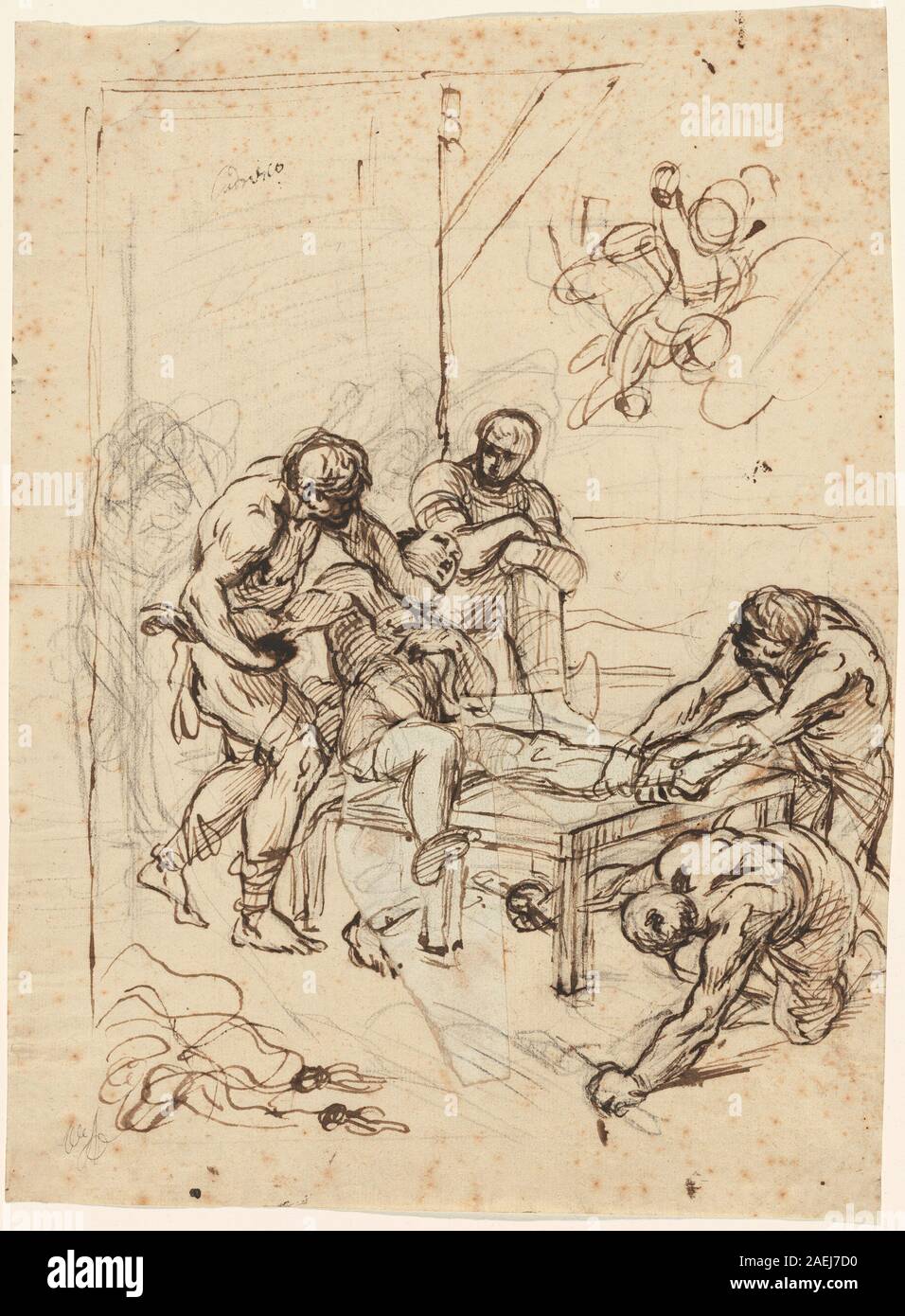 D13344.jpgLodovico Carracci, The Martyrdom of Saint Lawrence Lodovico Carracci (Bolognese, 1555 - 1619), The Martyrdom of Saint Lawrence, pen and brown and gray ink over black chalk on laid paper; with irregularly cut and torn patches attached and drawn with compositional corrections in pen and brown ink and black chalk, Joseph F. McCrindle Collection 2009.70.92 Stock Photohttps://www.alamy.com/image-license-details/?v=1https://www.alamy.com/d13344jpglodovico-carracci-the-martyrdom-of-saint-lawrence-lodovico-carracci-bolognese-1555-1619-the-martyrdom-of-saint-lawrence-pen-and-brown-and-gray-ink-over-black-chalk-on-laid-paper-with-irregularly-cut-and-torn-patches-attached-and-drawn-with-compositional-corrections-in-pen-and-brown-ink-and-black-chalk-joseph-f-mccrindle-collection-20097092-image336003164.html
D13344.jpgLodovico Carracci, The Martyrdom of Saint Lawrence Lodovico Carracci (Bolognese, 1555 - 1619), The Martyrdom of Saint Lawrence, pen and brown and gray ink over black chalk on laid paper; with irregularly cut and torn patches attached and drawn with compositional corrections in pen and brown ink and black chalk, Joseph F. McCrindle Collection 2009.70.92 Stock Photohttps://www.alamy.com/image-license-details/?v=1https://www.alamy.com/d13344jpglodovico-carracci-the-martyrdom-of-saint-lawrence-lodovico-carracci-bolognese-1555-1619-the-martyrdom-of-saint-lawrence-pen-and-brown-and-gray-ink-over-black-chalk-on-laid-paper-with-irregularly-cut-and-torn-patches-attached-and-drawn-with-compositional-corrections-in-pen-and-brown-ink-and-black-chalk-joseph-f-mccrindle-collection-20097092-image336003164.htmlRM2AEJ7D0–D13344.jpgLodovico Carracci, The Martyrdom of Saint Lawrence Lodovico Carracci (Bolognese, 1555 - 1619), The Martyrdom of Saint Lawrence, pen and brown and gray ink over black chalk on laid paper; with irregularly cut and torn patches attached and drawn with compositional corrections in pen and brown ink and black chalk, Joseph F. McCrindle Collection 2009.70.92
 Strip of bobbin lace with strongly winding flower vines with always one flower attached, Strip of natural-colored bobbin lace, old-Flemish lace. The repeating pattern consists of a succession of strong and irregularly winding tendrils with always one flower attached. The circumference of the flowers, just like the tendrils, is formed by a curling ribbon, it is made up of two palmetal flowers and a circular flower with faintly lobed edges. There is hardly any ground. The motifs are made in linen with cutouts. Various decorative grounds were used in the tendrils and flower hearts, including net Stock Photohttps://www.alamy.com/image-license-details/?v=1https://www.alamy.com/strip-of-bobbin-lace-with-strongly-winding-flower-vines-with-always-one-flower-attached-strip-of-natural-colored-bobbin-lace-old-flemish-lace-the-repeating-pattern-consists-of-a-succession-of-strong-and-irregularly-winding-tendrils-with-always-one-flower-attached-the-circumference-of-the-flowers-just-like-the-tendrils-is-formed-by-a-curling-ribbon-it-is-made-up-of-two-palmetal-flowers-and-a-circular-flower-with-faintly-lobed-edges-there-is-hardly-any-ground-the-motifs-are-made-in-linen-with-cutouts-various-decorative-grounds-were-used-in-the-tendrils-and-flower-hearts-including-net-image349975137.html
Strip of bobbin lace with strongly winding flower vines with always one flower attached, Strip of natural-colored bobbin lace, old-Flemish lace. The repeating pattern consists of a succession of strong and irregularly winding tendrils with always one flower attached. The circumference of the flowers, just like the tendrils, is formed by a curling ribbon, it is made up of two palmetal flowers and a circular flower with faintly lobed edges. There is hardly any ground. The motifs are made in linen with cutouts. Various decorative grounds were used in the tendrils and flower hearts, including net Stock Photohttps://www.alamy.com/image-license-details/?v=1https://www.alamy.com/strip-of-bobbin-lace-with-strongly-winding-flower-vines-with-always-one-flower-attached-strip-of-natural-colored-bobbin-lace-old-flemish-lace-the-repeating-pattern-consists-of-a-succession-of-strong-and-irregularly-winding-tendrils-with-always-one-flower-attached-the-circumference-of-the-flowers-just-like-the-tendrils-is-formed-by-a-curling-ribbon-it-is-made-up-of-two-palmetal-flowers-and-a-circular-flower-with-faintly-lobed-edges-there-is-hardly-any-ground-the-motifs-are-made-in-linen-with-cutouts-various-decorative-grounds-were-used-in-the-tendrils-and-flower-hearts-including-net-image349975137.htmlRF2B9AMT1–Strip of bobbin lace with strongly winding flower vines with always one flower attached, Strip of natural-colored bobbin lace, old-Flemish lace. The repeating pattern consists of a succession of strong and irregularly winding tendrils with always one flower attached. The circumference of the flowers, just like the tendrils, is formed by a curling ribbon, it is made up of two palmetal flowers and a circular flower with faintly lobed edges. There is hardly any ground. The motifs are made in linen with cutouts. Various decorative grounds were used in the tendrils and flower hearts, including net
 Marine isopods collected in the Philippines by the U.S fisheries steamer Albatross in 1907-08 . Fig. 48.—Prophryxus ala-scensis. Ventral view.X 191. no. 1701. NORTHWEST PACIFIC ISOPODS—RICHARDSOX. 125 Attached to one of the legs of /Ega symmetrica Richardson was aparasite, the outline of which was more or less irregularly trans-versely oval, with no traces of segmentation on the dorsal surface.The body seems to be converted into a sac for carrying the eggs,. Stock Photohttps://www.alamy.com/image-license-details/?v=1https://www.alamy.com/marine-isopods-collected-in-the-philippines-by-the-us-fisheries-steamer-albatross-in-1907-08-fig-48prophryxus-ala-scensis-ventral-viewx-191-no-1701-northwest-pacific-isopodsrichardsox-125-attached-to-one-of-the-legs-of-ega-symmetrica-richardson-was-aparasite-the-outline-of-which-was-more-or-less-irregularly-trans-versely-oval-with-no-traces-of-segmentation-on-the-dorsal-surfacethe-body-seems-to-be-converted-into-a-sac-for-carrying-the-eggs-image338120850.html
Marine isopods collected in the Philippines by the U.S fisheries steamer Albatross in 1907-08 . Fig. 48.—Prophryxus ala-scensis. Ventral view.X 191. no. 1701. NORTHWEST PACIFIC ISOPODS—RICHARDSOX. 125 Attached to one of the legs of /Ega symmetrica Richardson was aparasite, the outline of which was more or less irregularly trans-versely oval, with no traces of segmentation on the dorsal surface.The body seems to be converted into a sac for carrying the eggs,. Stock Photohttps://www.alamy.com/image-license-details/?v=1https://www.alamy.com/marine-isopods-collected-in-the-philippines-by-the-us-fisheries-steamer-albatross-in-1907-08-fig-48prophryxus-ala-scensis-ventral-viewx-191-no-1701-northwest-pacific-isopodsrichardsox-125-attached-to-one-of-the-legs-of-ega-symmetrica-richardson-was-aparasite-the-outline-of-which-was-more-or-less-irregularly-trans-versely-oval-with-no-traces-of-segmentation-on-the-dorsal-surfacethe-body-seems-to-be-converted-into-a-sac-for-carrying-the-eggs-image338120850.htmlRM2AJ2MGJ–Marine isopods collected in the Philippines by the U.S fisheries steamer Albatross in 1907-08 . Fig. 48.—Prophryxus ala-scensis. Ventral view.X 191. no. 1701. NORTHWEST PACIFIC ISOPODS—RICHARDSOX. 125 Attached to one of the legs of /Ega symmetrica Richardson was aparasite, the outline of which was more or less irregularly trans-versely oval, with no traces of segmentation on the dorsal surface.The body seems to be converted into a sac for carrying the eggs,.
 The Martyrdom of Saint Lawrence. Stock Photohttps://www.alamy.com/image-license-details/?v=1https://www.alamy.com/the-martyrdom-of-saint-lawrence-image506215366.html
The Martyrdom of Saint Lawrence. Stock Photohttps://www.alamy.com/image-license-details/?v=1https://www.alamy.com/the-martyrdom-of-saint-lawrence-image506215366.htmlRM2MBG2T6–The Martyrdom of Saint Lawrence.
 Land snail attached to the bark of an old tree stump with a blurred green nature background on a sunny day, gastropod mollusk with an irregularly text Stock Photohttps://www.alamy.com/image-license-details/?v=1https://www.alamy.com/land-snail-attached-to-the-bark-of-an-old-tree-stump-with-a-blurred-green-nature-background-on-a-sunny-day-gastropod-mollusk-with-an-irregularly-text-image554773591.html
Land snail attached to the bark of an old tree stump with a blurred green nature background on a sunny day, gastropod mollusk with an irregularly text Stock Photohttps://www.alamy.com/image-license-details/?v=1https://www.alamy.com/land-snail-attached-to-the-bark-of-an-old-tree-stump-with-a-blurred-green-nature-background-on-a-sunny-day-gastropod-mollusk-with-an-irregularly-text-image554773591.htmlRF2R6G3AF–Land snail attached to the bark of an old tree stump with a blurred green nature background on a sunny day, gastropod mollusk with an irregularly text
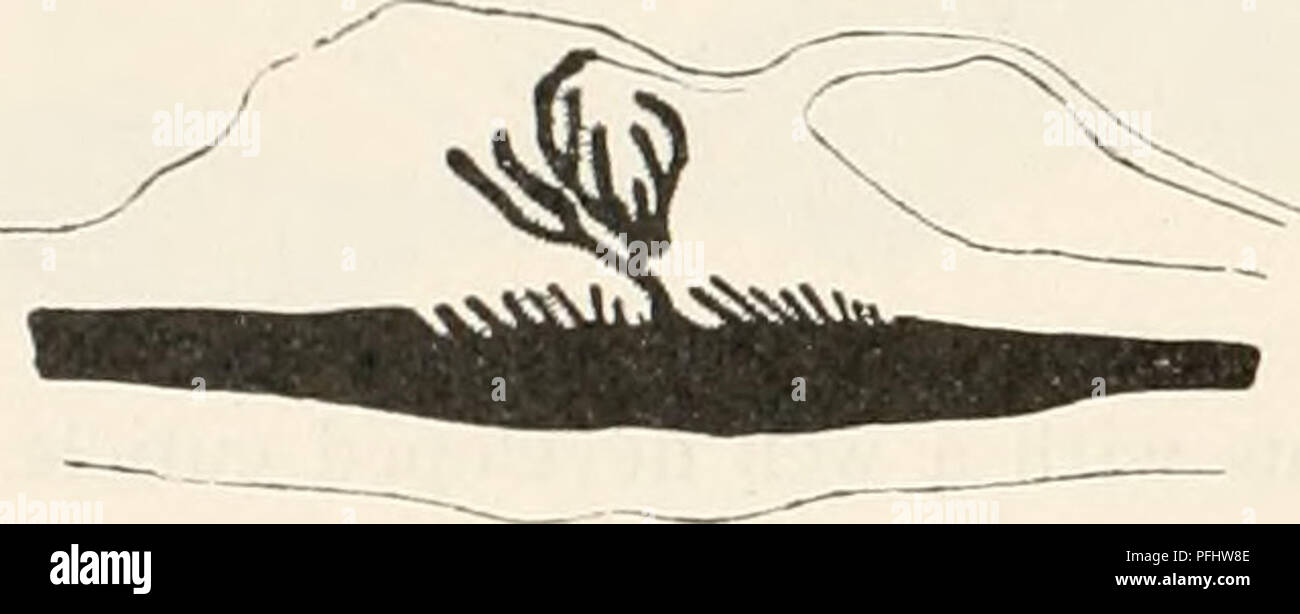 . The Danish Ingolf-Expedition. Scientific expeditions; Arctic Ocean. Fig. 83. The proximal part is rounded and fusing into the middle without distinct outline. No distinct physa is present. The scapus is provided with a sometimes thin, sometimes thick, but translucent, often irregularly wrinkled cuticle, to the outside of which small grains and a great number of detritus-particles are attached. Under low magnifying powers small papilliform elevations are to be seen, which are, however, not regularly arranged, they are as yet only thickenings of the ectoderm as may easily be ascertained on sec Stock Photohttps://www.alamy.com/image-license-details/?v=1https://www.alamy.com/the-danish-ingolf-expedition-scientific-expeditions-arctic-ocean-fig-83-the-proximal-part-is-rounded-and-fusing-into-the-middle-without-distinct-outline-no-distinct-physa-is-present-the-scapus-is-provided-with-a-sometimes-thin-sometimes-thick-but-translucent-often-irregularly-wrinkled-cuticle-to-the-outside-of-which-small-grains-and-a-great-number-of-detritus-particles-are-attached-under-low-magnifying-powers-small-papilliform-elevations-are-to-be-seen-which-are-however-not-regularly-arranged-they-are-as-yet-only-thickenings-of-the-ectoderm-as-may-easily-be-ascertained-on-sec-image216137278.html
. The Danish Ingolf-Expedition. Scientific expeditions; Arctic Ocean. Fig. 83. The proximal part is rounded and fusing into the middle without distinct outline. No distinct physa is present. The scapus is provided with a sometimes thin, sometimes thick, but translucent, often irregularly wrinkled cuticle, to the outside of which small grains and a great number of detritus-particles are attached. Under low magnifying powers small papilliform elevations are to be seen, which are, however, not regularly arranged, they are as yet only thickenings of the ectoderm as may easily be ascertained on sec Stock Photohttps://www.alamy.com/image-license-details/?v=1https://www.alamy.com/the-danish-ingolf-expedition-scientific-expeditions-arctic-ocean-fig-83-the-proximal-part-is-rounded-and-fusing-into-the-middle-without-distinct-outline-no-distinct-physa-is-present-the-scapus-is-provided-with-a-sometimes-thin-sometimes-thick-but-translucent-often-irregularly-wrinkled-cuticle-to-the-outside-of-which-small-grains-and-a-great-number-of-detritus-particles-are-attached-under-low-magnifying-powers-small-papilliform-elevations-are-to-be-seen-which-are-however-not-regularly-arranged-they-are-as-yet-only-thickenings-of-the-ectoderm-as-may-easily-be-ascertained-on-sec-image216137278.htmlRMPFHW8E–. The Danish Ingolf-Expedition. Scientific expeditions; Arctic Ocean. Fig. 83. The proximal part is rounded and fusing into the middle without distinct outline. No distinct physa is present. The scapus is provided with a sometimes thin, sometimes thick, but translucent, often irregularly wrinkled cuticle, to the outside of which small grains and a great number of detritus-particles are attached. Under low magnifying powers small papilliform elevations are to be seen, which are, however, not regularly arranged, they are as yet only thickenings of the ectoderm as may easily be ascertained on sec
 Archive image from page 81 of The Danish Ingolf-expedition (1899-1953). The Danish Ingolf-expedition danishingolfex5cpt9daniuoft Year: 1899-1953 68 ACTINIARIA The proximal part is rounded and fusing into the middle without distinct outline. No distinct pliysa is present. The scapus is provided with a sometimes thin, sometimes thick, but translucent, often irregularly wrinkled cuticle, to the outside of which small grains and a great number of detritus-particles are attached. Under low magnifying powers small papilliform elevations are to be seen, which are, however, not regularly arranged, th Stock Photohttps://www.alamy.com/image-license-details/?v=1https://www.alamy.com/archive-image-from-page-81-of-the-danish-ingolf-expedition-1899-1953-the-danish-ingolf-expedition-danishingolfex5cpt9daniuoft-year-1899-1953-68-actiniaria-the-proximal-part-is-rounded-and-fusing-into-the-middle-without-distinct-outline-no-distinct-pliysa-is-present-the-scapus-is-provided-with-a-sometimes-thin-sometimes-thick-but-translucent-often-irregularly-wrinkled-cuticle-to-the-outside-of-which-small-grains-and-a-great-number-of-detritus-particles-are-attached-under-low-magnifying-powers-small-papilliform-elevations-are-to-be-seen-which-are-however-not-regularly-arranged-th-image259295695.html
Archive image from page 81 of The Danish Ingolf-expedition (1899-1953). The Danish Ingolf-expedition danishingolfex5cpt9daniuoft Year: 1899-1953 68 ACTINIARIA The proximal part is rounded and fusing into the middle without distinct outline. No distinct pliysa is present. The scapus is provided with a sometimes thin, sometimes thick, but translucent, often irregularly wrinkled cuticle, to the outside of which small grains and a great number of detritus-particles are attached. Under low magnifying powers small papilliform elevations are to be seen, which are, however, not regularly arranged, th Stock Photohttps://www.alamy.com/image-license-details/?v=1https://www.alamy.com/archive-image-from-page-81-of-the-danish-ingolf-expedition-1899-1953-the-danish-ingolf-expedition-danishingolfex5cpt9daniuoft-year-1899-1953-68-actiniaria-the-proximal-part-is-rounded-and-fusing-into-the-middle-without-distinct-outline-no-distinct-pliysa-is-present-the-scapus-is-provided-with-a-sometimes-thin-sometimes-thick-but-translucent-often-irregularly-wrinkled-cuticle-to-the-outside-of-which-small-grains-and-a-great-number-of-detritus-particles-are-attached-under-low-magnifying-powers-small-papilliform-elevations-are-to-be-seen-which-are-however-not-regularly-arranged-th-image259295695.htmlRMW1RX8F–Archive image from page 81 of The Danish Ingolf-expedition (1899-1953). The Danish Ingolf-expedition danishingolfex5cpt9daniuoft Year: 1899-1953 68 ACTINIARIA The proximal part is rounded and fusing into the middle without distinct outline. No distinct pliysa is present. The scapus is provided with a sometimes thin, sometimes thick, but translucent, often irregularly wrinkled cuticle, to the outside of which small grains and a great number of detritus-particles are attached. Under low magnifying powers small papilliform elevations are to be seen, which are, however, not regularly arranged, th
 Head of the Christ Child, Francesco Mazzola, called il Parmigianino (Parma 1503–1540 Casalmaggiore), 1526–1527, Drawing, Black and red chalk; irregularly cut out, slightly toned paper attached, 23.6 x 19.8 cm, r.l. Marquis de Lagoy, l.b. Duke Albert of Saxe-Teschen Stock Photohttps://www.alamy.com/image-license-details/?v=1https://www.alamy.com/head-of-the-christ-child-francesco-mazzola-called-il-parmigianino-parma-15031540-casalmaggiore-15261527-drawing-black-and-red-chalk-irregularly-cut-out-slightly-toned-paper-attached-236-x-198-cm-rl-marquis-de-lagoy-lb-duke-albert-of-saxe-teschen-image573303724.html
Head of the Christ Child, Francesco Mazzola, called il Parmigianino (Parma 1503–1540 Casalmaggiore), 1526–1527, Drawing, Black and red chalk; irregularly cut out, slightly toned paper attached, 23.6 x 19.8 cm, r.l. Marquis de Lagoy, l.b. Duke Albert of Saxe-Teschen Stock Photohttps://www.alamy.com/image-license-details/?v=1https://www.alamy.com/head-of-the-christ-child-francesco-mazzola-called-il-parmigianino-parma-15031540-casalmaggiore-15261527-drawing-black-and-red-chalk-irregularly-cut-out-slightly-toned-paper-attached-236-x-198-cm-rl-marquis-de-lagoy-lb-duke-albert-of-saxe-teschen-image573303724.htmlRM2T8M6N0–Head of the Christ Child, Francesco Mazzola, called il Parmigianino (Parma 1503–1540 Casalmaggiore), 1526–1527, Drawing, Black and red chalk; irregularly cut out, slightly toned paper attached, 23.6 x 19.8 cm, r.l. Marquis de Lagoy, l.b. Duke Albert of Saxe-Teschen
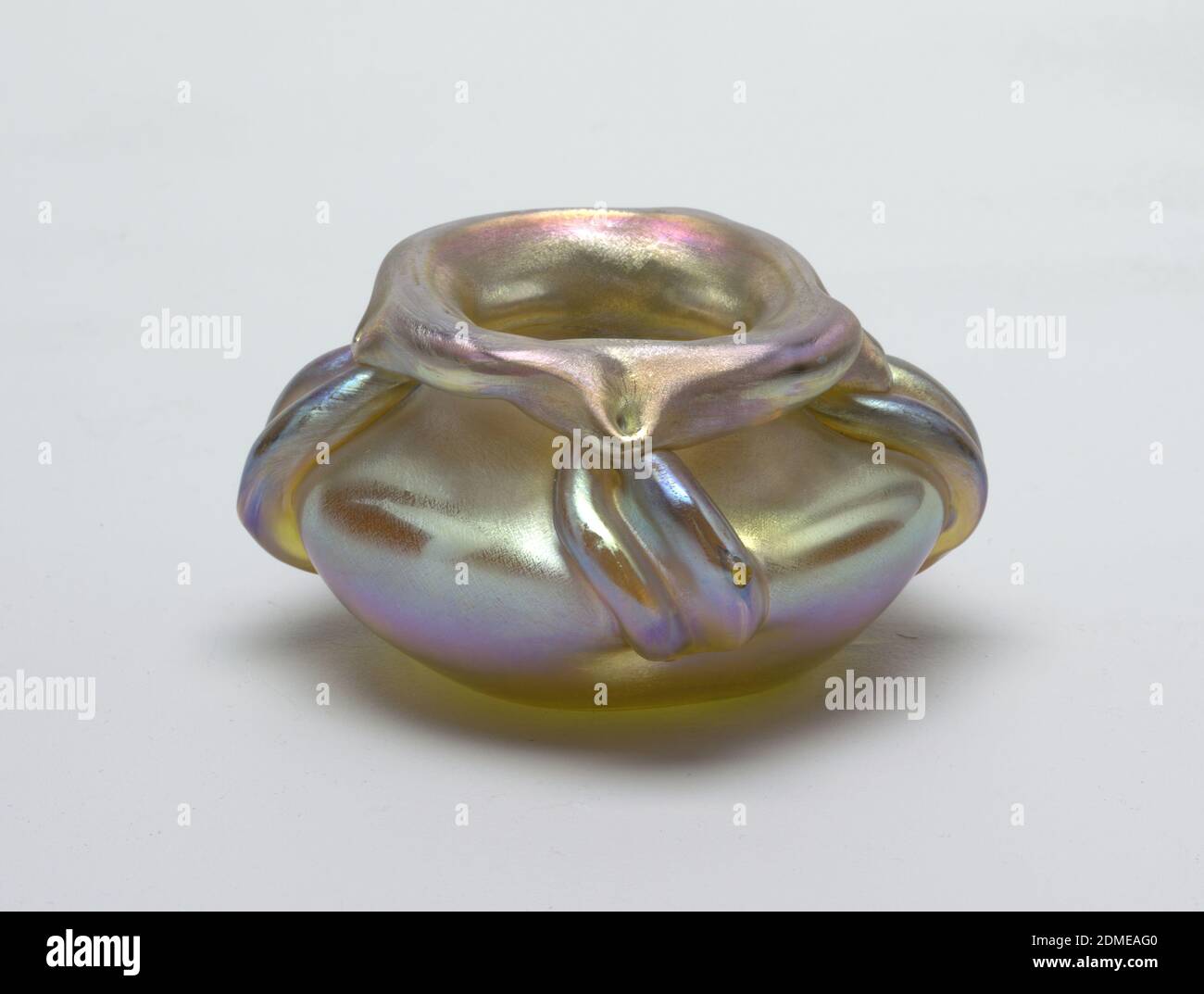 Vase, Tiffany Glass and Decorating Company, American, 1892 - 1900, Free-blown favrile glass, Iridescent blue, purple and yellow. Free-blown body, depressed sphere in shape, somewhat squared in plan. Heavy, rolled-over rim from squarish opening, drawn irregularly down and attached to applied heavy double threads, accenting four “corners” of body, and diminishing to points, near bottom. Depressed center on underside., New York, New York, USA, ca. 1895-96, glasswares, Decorative Arts, Vase Stock Photohttps://www.alamy.com/image-license-details/?v=1https://www.alamy.com/vase-tiffany-glass-and-decorating-company-american-1892-1900-free-blown-favrile-glass-iridescent-blue-purple-and-yellow-free-blown-body-depressed-sphere-in-shape-somewhat-squared-in-plan-heavy-rolled-over-rim-from-squarish-opening-drawn-irregularly-down-and-attached-to-applied-heavy-double-threads-accenting-four-corners-of-body-and-diminishing-to-points-near-bottom-depressed-center-on-underside-new-york-new-york-usa-ca-1895-96-glasswares-decorative-arts-vase-image391236832.html
Vase, Tiffany Glass and Decorating Company, American, 1892 - 1900, Free-blown favrile glass, Iridescent blue, purple and yellow. Free-blown body, depressed sphere in shape, somewhat squared in plan. Heavy, rolled-over rim from squarish opening, drawn irregularly down and attached to applied heavy double threads, accenting four “corners” of body, and diminishing to points, near bottom. Depressed center on underside., New York, New York, USA, ca. 1895-96, glasswares, Decorative Arts, Vase Stock Photohttps://www.alamy.com/image-license-details/?v=1https://www.alamy.com/vase-tiffany-glass-and-decorating-company-american-1892-1900-free-blown-favrile-glass-iridescent-blue-purple-and-yellow-free-blown-body-depressed-sphere-in-shape-somewhat-squared-in-plan-heavy-rolled-over-rim-from-squarish-opening-drawn-irregularly-down-and-attached-to-applied-heavy-double-threads-accenting-four-corners-of-body-and-diminishing-to-points-near-bottom-depressed-center-on-underside-new-york-new-york-usa-ca-1895-96-glasswares-decorative-arts-vase-image391236832.htmlRM2DMEAG0–Vase, Tiffany Glass and Decorating Company, American, 1892 - 1900, Free-blown favrile glass, Iridescent blue, purple and yellow. Free-blown body, depressed sphere in shape, somewhat squared in plan. Heavy, rolled-over rim from squarish opening, drawn irregularly down and attached to applied heavy double threads, accenting four “corners” of body, and diminishing to points, near bottom. Depressed center on underside., New York, New York, USA, ca. 1895-96, glasswares, Decorative Arts, Vase
 jug, Anonymous, 1763, cast, General: 11.8 x 16 x 7.7cm (118 x 160 x 77mm), Pewter jug with a spout. The jug has a baluster shape on a low concave ring and ends slightly flared cylindrical at the top. The jug has a thorny, irregularly shaped ear. The slightly curved lid is attached to a two-hinged hinge with a shell-shaped thumb rest. The jug has an obtuse-angled spout that is connected to the top edge of the jug with an additional connection. Marked, 1914 Stock Photohttps://www.alamy.com/image-license-details/?v=1https://www.alamy.com/jug-anonymous-1763-cast-general-118-x-16-x-77cm-118-x-160-x-77mm-pewter-jug-with-a-spout-the-jug-has-a-baluster-shape-on-a-low-concave-ring-and-ends-slightly-flared-cylindrical-at-the-top-the-jug-has-a-thorny-irregularly-shaped-ear-the-slightly-curved-lid-is-attached-to-a-two-hinged-hinge-with-a-shell-shaped-thumb-rest-the-jug-has-an-obtuse-angled-spout-that-is-connected-to-the-top-edge-of-the-jug-with-an-additional-connection-marked-1914-image386388516.html
jug, Anonymous, 1763, cast, General: 11.8 x 16 x 7.7cm (118 x 160 x 77mm), Pewter jug with a spout. The jug has a baluster shape on a low concave ring and ends slightly flared cylindrical at the top. The jug has a thorny, irregularly shaped ear. The slightly curved lid is attached to a two-hinged hinge with a shell-shaped thumb rest. The jug has an obtuse-angled spout that is connected to the top edge of the jug with an additional connection. Marked, 1914 Stock Photohttps://www.alamy.com/image-license-details/?v=1https://www.alamy.com/jug-anonymous-1763-cast-general-118-x-16-x-77cm-118-x-160-x-77mm-pewter-jug-with-a-spout-the-jug-has-a-baluster-shape-on-a-low-concave-ring-and-ends-slightly-flared-cylindrical-at-the-top-the-jug-has-a-thorny-irregularly-shaped-ear-the-slightly-curved-lid-is-attached-to-a-two-hinged-hinge-with-a-shell-shaped-thumb-rest-the-jug-has-an-obtuse-angled-spout-that-is-connected-to-the-top-edge-of-the-jug-with-an-additional-connection-marked-1914-image386388516.htmlRM2DCHEDT–jug, Anonymous, 1763, cast, General: 11.8 x 16 x 7.7cm (118 x 160 x 77mm), Pewter jug with a spout. The jug has a baluster shape on a low concave ring and ends slightly flared cylindrical at the top. The jug has a thorny, irregularly shaped ear. The slightly curved lid is attached to a two-hinged hinge with a shell-shaped thumb rest. The jug has an obtuse-angled spout that is connected to the top edge of the jug with an additional connection. Marked, 1914
 Silver thimble with pattern of pits, along the bottom edge of the inscription Catalina Blavoet 1595, thimble sewing kit soil find silver metal, cast Silver thimble with bottom edge with Catalina Blavoet 1595 with attached ring and band with rings above it; above that, protruded side irregularly of large and in vertical lines divided by means of bands into three compartments; moderately thick wall; groove between side and top; top is finely drawn in spiral shape with sun or star on the spherical top; possible silver mark on the inside CATALINA BLAVOET 1595 archeology Rotterdam Stadscentrum Stad Stock Photohttps://www.alamy.com/image-license-details/?v=1https://www.alamy.com/silver-thimble-with-pattern-of-pits-along-the-bottom-edge-of-the-inscription-catalina-blavoet-1595-thimble-sewing-kit-soil-find-silver-metal-cast-silver-thimble-with-bottom-edge-with-catalina-blavoet-1595-with-attached-ring-and-band-with-rings-above-it-above-that-protruded-side-irregularly-of-large-and-in-vertical-lines-divided-by-means-of-bands-into-three-compartments-moderately-thick-wall-groove-between-side-and-top-top-is-finely-drawn-in-spiral-shape-with-sun-or-star-on-the-spherical-top-possible-silver-mark-on-the-inside-catalina-blavoet-1595-archeology-rotterdam-stadscentrum-stad-image350087718.html
Silver thimble with pattern of pits, along the bottom edge of the inscription Catalina Blavoet 1595, thimble sewing kit soil find silver metal, cast Silver thimble with bottom edge with Catalina Blavoet 1595 with attached ring and band with rings above it; above that, protruded side irregularly of large and in vertical lines divided by means of bands into three compartments; moderately thick wall; groove between side and top; top is finely drawn in spiral shape with sun or star on the spherical top; possible silver mark on the inside CATALINA BLAVOET 1595 archeology Rotterdam Stadscentrum Stad Stock Photohttps://www.alamy.com/image-license-details/?v=1https://www.alamy.com/silver-thimble-with-pattern-of-pits-along-the-bottom-edge-of-the-inscription-catalina-blavoet-1595-thimble-sewing-kit-soil-find-silver-metal-cast-silver-thimble-with-bottom-edge-with-catalina-blavoet-1595-with-attached-ring-and-band-with-rings-above-it-above-that-protruded-side-irregularly-of-large-and-in-vertical-lines-divided-by-means-of-bands-into-three-compartments-moderately-thick-wall-groove-between-side-and-top-top-is-finely-drawn-in-spiral-shape-with-sun-or-star-on-the-spherical-top-possible-silver-mark-on-the-inside-catalina-blavoet-1595-archeology-rotterdam-stadscentrum-stad-image350087718.htmlRF2B9FTCP–Silver thimble with pattern of pits, along the bottom edge of the inscription Catalina Blavoet 1595, thimble sewing kit soil find silver metal, cast Silver thimble with bottom edge with Catalina Blavoet 1595 with attached ring and band with rings above it; above that, protruded side irregularly of large and in vertical lines divided by means of bands into three compartments; moderately thick wall; groove between side and top; top is finely drawn in spiral shape with sun or star on the spherical top; possible silver mark on the inside CATALINA BLAVOET 1595 archeology Rotterdam Stadscentrum Stad
 The anatomical record . regularly fused, so thatit is ver> difficult to distinguish the boundaries of the individualvertebrae, e.speciallj of the last three. The axis, ax, is seen in this view to consist of the two widelydivergent articular processes, ar, which are not in contact witheach other, and an irregularly rectangular bone, ax, lying inthe median line and articulating with the median articularsurfaces of the two atlases, al. This strange-looking bone isloosely attached to the articular processes, ar, but seems fairlyclosely united, in the anterior part of its mid-dorsal region, with Stock Photohttps://www.alamy.com/image-license-details/?v=1https://www.alamy.com/the-anatomical-record-regularly-fused-so-thatit-is-vergt-difficult-to-distinguish-the-boundaries-of-the-individualvertebrae-especiallj-of-the-last-three-the-axis-ax-is-seen-in-this-view-to-consist-of-the-two-widelydivergent-articular-processes-ar-which-are-not-in-contact-witheach-other-and-an-irregularly-rectangular-bone-ax-lying-inthe-median-line-and-articulating-with-the-median-articularsurfaces-of-the-two-atlases-al-this-strange-looking-bone-isloosely-attached-to-the-articular-processes-ar-but-seems-fairlyclosely-united-in-the-anterior-part-of-its-mid-dorsal-region-with-image340296791.html
The anatomical record . regularly fused, so thatit is ver> difficult to distinguish the boundaries of the individualvertebrae, e.speciallj of the last three. The axis, ax, is seen in this view to consist of the two widelydivergent articular processes, ar, which are not in contact witheach other, and an irregularly rectangular bone, ax, lying inthe median line and articulating with the median articularsurfaces of the two atlases, al. This strange-looking bone isloosely attached to the articular processes, ar, but seems fairlyclosely united, in the anterior part of its mid-dorsal region, with Stock Photohttps://www.alamy.com/image-license-details/?v=1https://www.alamy.com/the-anatomical-record-regularly-fused-so-thatit-is-vergt-difficult-to-distinguish-the-boundaries-of-the-individualvertebrae-especiallj-of-the-last-three-the-axis-ax-is-seen-in-this-view-to-consist-of-the-two-widelydivergent-articular-processes-ar-which-are-not-in-contact-witheach-other-and-an-irregularly-rectangular-bone-ax-lying-inthe-median-line-and-articulating-with-the-median-articularsurfaces-of-the-two-atlases-al-this-strange-looking-bone-isloosely-attached-to-the-articular-processes-ar-but-seems-fairlyclosely-united-in-the-anterior-part-of-its-mid-dorsal-region-with-image340296791.htmlRM2ANHT0R–The anatomical record . regularly fused, so thatit is ver> difficult to distinguish the boundaries of the individualvertebrae, e.speciallj of the last three. The axis, ax, is seen in this view to consist of the two widelydivergent articular processes, ar, which are not in contact witheach other, and an irregularly rectangular bone, ax, lying inthe median line and articulating with the median articularsurfaces of the two atlases, al. This strange-looking bone isloosely attached to the articular processes, ar, but seems fairlyclosely united, in the anterior part of its mid-dorsal region, with
 . The Danish Ingolf-Expedition. Scientific expeditions; Arctic Ocean. Fig. 83. The proximal part is rounded and fusing into the middle without distinct outline. No distinct physa is present. The scapus is provided with a sometimes thin, sometimes thick, but translucent, often irregularly wrinkled cuticle, to the outside of which small grains and a great number of detritus-particles are attached. Under low magnifying powers small papilliform elevations are to be seen, which are, however, not regularly arranged, they are as yet only thickenings of the ectoderm as may easily be ascertained on sec Stock Photohttps://www.alamy.com/image-license-details/?v=1https://www.alamy.com/the-danish-ingolf-expedition-scientific-expeditions-arctic-ocean-fig-83-the-proximal-part-is-rounded-and-fusing-into-the-middle-without-distinct-outline-no-distinct-physa-is-present-the-scapus-is-provided-with-a-sometimes-thin-sometimes-thick-but-translucent-often-irregularly-wrinkled-cuticle-to-the-outside-of-which-small-grains-and-a-great-number-of-detritus-particles-are-attached-under-low-magnifying-powers-small-papilliform-elevations-are-to-be-seen-which-are-however-not-regularly-arranged-they-are-as-yet-only-thickenings-of-the-ectoderm-as-may-easily-be-ascertained-on-sec-image216137287.html
. The Danish Ingolf-Expedition. Scientific expeditions; Arctic Ocean. Fig. 83. The proximal part is rounded and fusing into the middle without distinct outline. No distinct physa is present. The scapus is provided with a sometimes thin, sometimes thick, but translucent, often irregularly wrinkled cuticle, to the outside of which small grains and a great number of detritus-particles are attached. Under low magnifying powers small papilliform elevations are to be seen, which are, however, not regularly arranged, they are as yet only thickenings of the ectoderm as may easily be ascertained on sec Stock Photohttps://www.alamy.com/image-license-details/?v=1https://www.alamy.com/the-danish-ingolf-expedition-scientific-expeditions-arctic-ocean-fig-83-the-proximal-part-is-rounded-and-fusing-into-the-middle-without-distinct-outline-no-distinct-physa-is-present-the-scapus-is-provided-with-a-sometimes-thin-sometimes-thick-but-translucent-often-irregularly-wrinkled-cuticle-to-the-outside-of-which-small-grains-and-a-great-number-of-detritus-particles-are-attached-under-low-magnifying-powers-small-papilliform-elevations-are-to-be-seen-which-are-however-not-regularly-arranged-they-are-as-yet-only-thickenings-of-the-ectoderm-as-may-easily-be-ascertained-on-sec-image216137287.htmlRMPFHW8R–. The Danish Ingolf-Expedition. Scientific expeditions; Arctic Ocean. Fig. 83. The proximal part is rounded and fusing into the middle without distinct outline. No distinct physa is present. The scapus is provided with a sometimes thin, sometimes thick, but translucent, often irregularly wrinkled cuticle, to the outside of which small grains and a great number of detritus-particles are attached. Under low magnifying powers small papilliform elevations are to be seen, which are, however, not regularly arranged, they are as yet only thickenings of the ectoderm as may easily be ascertained on sec
 Archive image from page 9 of A cytological study of haploid. A cytological study of haploid Crepis capillaris plants cytologicalstudy64holl Year: 1930 114 University of California Publications in Agricultural Sciences [Vol. 6 and later figures show, division of the chromosomes within a cell does not always proceed synchronously. Usually, however, the divi- sion begins later, and the chromosomes in the shape of attached twin spheres pass irregularly to the poles (fig. 5, b, c) or one may be left out of the spindle and fail to reach a pole, giving rise to three iso- Stock Photohttps://www.alamy.com/image-license-details/?v=1https://www.alamy.com/archive-image-from-page-9-of-a-cytological-study-of-haploid-a-cytological-study-of-haploid-crepis-capillaris-plants-cytologicalstudy64holl-year-1930-114-university-of-california-publications-in-agricultural-sciences-vol-6-and-later-figures-show-division-of-the-chromosomes-within-a-cell-does-not-always-proceed-synchronously-usually-however-the-divi-sion-begins-later-and-the-chromosomes-in-the-shape-of-attached-twin-spheres-pass-irregularly-to-the-poles-fig-5-b-c-or-one-may-be-left-out-of-the-spindle-and-fail-to-reach-a-pole-giving-rise-to-three-iso-image259281911.html
Archive image from page 9 of A cytological study of haploid. A cytological study of haploid Crepis capillaris plants cytologicalstudy64holl Year: 1930 114 University of California Publications in Agricultural Sciences [Vol. 6 and later figures show, division of the chromosomes within a cell does not always proceed synchronously. Usually, however, the divi- sion begins later, and the chromosomes in the shape of attached twin spheres pass irregularly to the poles (fig. 5, b, c) or one may be left out of the spindle and fail to reach a pole, giving rise to three iso- Stock Photohttps://www.alamy.com/image-license-details/?v=1https://www.alamy.com/archive-image-from-page-9-of-a-cytological-study-of-haploid-a-cytological-study-of-haploid-crepis-capillaris-plants-cytologicalstudy64holl-year-1930-114-university-of-california-publications-in-agricultural-sciences-vol-6-and-later-figures-show-division-of-the-chromosomes-within-a-cell-does-not-always-proceed-synchronously-usually-however-the-divi-sion-begins-later-and-the-chromosomes-in-the-shape-of-attached-twin-spheres-pass-irregularly-to-the-poles-fig-5-b-c-or-one-may-be-left-out-of-the-spindle-and-fail-to-reach-a-pole-giving-rise-to-three-iso-image259281911.htmlRMW1R8M7–Archive image from page 9 of A cytological study of haploid. A cytological study of haploid Crepis capillaris plants cytologicalstudy64holl Year: 1930 114 University of California Publications in Agricultural Sciences [Vol. 6 and later figures show, division of the chromosomes within a cell does not always proceed synchronously. Usually, however, the divi- sion begins later, and the chromosomes in the shape of attached twin spheres pass irregularly to the poles (fig. 5, b, c) or one may be left out of the spindle and fail to reach a pole, giving rise to three iso-
 jug, Anonymous, 1763, cast, General: 11.8 x 16 x 7.7cm (118 x 160 x 77mm), Pewter jug with a spout. The jug has a baluster shape on a low concave ring and ends slightly flared cylindrical at the top. The jug has a thorny, irregularly shaped ear. The slightly curved lid is attached to a two-hinged hinge with a shell-shaped thumb rest. The jug has an obtuse-angled spout that is connected to the top edge of the jug with an additional connection. Marked, 1914 Stock Photohttps://www.alamy.com/image-license-details/?v=1https://www.alamy.com/jug-anonymous-1763-cast-general-118-x-16-x-77cm-118-x-160-x-77mm-pewter-jug-with-a-spout-the-jug-has-a-baluster-shape-on-a-low-concave-ring-and-ends-slightly-flared-cylindrical-at-the-top-the-jug-has-a-thorny-irregularly-shaped-ear-the-slightly-curved-lid-is-attached-to-a-two-hinged-hinge-with-a-shell-shaped-thumb-rest-the-jug-has-an-obtuse-angled-spout-that-is-connected-to-the-top-edge-of-the-jug-with-an-additional-connection-marked-1914-image386388540.html
jug, Anonymous, 1763, cast, General: 11.8 x 16 x 7.7cm (118 x 160 x 77mm), Pewter jug with a spout. The jug has a baluster shape on a low concave ring and ends slightly flared cylindrical at the top. The jug has a thorny, irregularly shaped ear. The slightly curved lid is attached to a two-hinged hinge with a shell-shaped thumb rest. The jug has an obtuse-angled spout that is connected to the top edge of the jug with an additional connection. Marked, 1914 Stock Photohttps://www.alamy.com/image-license-details/?v=1https://www.alamy.com/jug-anonymous-1763-cast-general-118-x-16-x-77cm-118-x-160-x-77mm-pewter-jug-with-a-spout-the-jug-has-a-baluster-shape-on-a-low-concave-ring-and-ends-slightly-flared-cylindrical-at-the-top-the-jug-has-a-thorny-irregularly-shaped-ear-the-slightly-curved-lid-is-attached-to-a-two-hinged-hinge-with-a-shell-shaped-thumb-rest-the-jug-has-an-obtuse-angled-spout-that-is-connected-to-the-top-edge-of-the-jug-with-an-additional-connection-marked-1914-image386388540.htmlRM2DCHEEM–jug, Anonymous, 1763, cast, General: 11.8 x 16 x 7.7cm (118 x 160 x 77mm), Pewter jug with a spout. The jug has a baluster shape on a low concave ring and ends slightly flared cylindrical at the top. The jug has a thorny, irregularly shaped ear. The slightly curved lid is attached to a two-hinged hinge with a shell-shaped thumb rest. The jug has an obtuse-angled spout that is connected to the top edge of the jug with an additional connection. Marked, 1914
 The hydropathic encyclopedia : a system of hydropathy and hygiene in eight parts ..designed as a guide to families and students, and a text-book for physicians . , irregularly curvedbones, projecting inward toward, the septum narium, or partition of thenose. Each one is attached to the maxillary bone in front, and thopalate bone behind. The Vomer is a thin quadrilateral piece, forming the back and lowerpart of the septum of the nosr OSTEOLOGY. 65 The Inferio-, Mc. riitary bone, ov lower jaw, is an arch of bone contain-ing the under tow of teeth. Its distinctive parts are shown in tig. 7. 1. Th Stock Photohttps://www.alamy.com/image-license-details/?v=1https://www.alamy.com/the-hydropathic-encyclopedia-a-system-of-hydropathy-and-hygiene-in-eight-parts-designed-as-a-guide-to-families-and-students-and-a-text-book-for-physicians-irregularly-curvedbones-projecting-inward-toward-the-septum-narium-or-partition-of-thenose-each-one-is-attached-to-the-maxillary-bone-in-front-and-thopalate-bone-behind-the-vomer-is-a-thin-quadrilateral-piece-forming-the-back-and-lowerpart-of-the-septum-of-the-nosr-osteology-65-the-inferio-mc-riitary-bone-ov-lower-jaw-is-an-arch-of-bone-contain-ing-the-under-tow-of-teeth-its-distinctive-parts-are-shown-in-tig-7-1-th-image342765489.html
The hydropathic encyclopedia : a system of hydropathy and hygiene in eight parts ..designed as a guide to families and students, and a text-book for physicians . , irregularly curvedbones, projecting inward toward, the septum narium, or partition of thenose. Each one is attached to the maxillary bone in front, and thopalate bone behind. The Vomer is a thin quadrilateral piece, forming the back and lowerpart of the septum of the nosr OSTEOLOGY. 65 The Inferio-, Mc. riitary bone, ov lower jaw, is an arch of bone contain-ing the under tow of teeth. Its distinctive parts are shown in tig. 7. 1. Th Stock Photohttps://www.alamy.com/image-license-details/?v=1https://www.alamy.com/the-hydropathic-encyclopedia-a-system-of-hydropathy-and-hygiene-in-eight-parts-designed-as-a-guide-to-families-and-students-and-a-text-book-for-physicians-irregularly-curvedbones-projecting-inward-toward-the-septum-narium-or-partition-of-thenose-each-one-is-attached-to-the-maxillary-bone-in-front-and-thopalate-bone-behind-the-vomer-is-a-thin-quadrilateral-piece-forming-the-back-and-lowerpart-of-the-septum-of-the-nosr-osteology-65-the-inferio-mc-riitary-bone-ov-lower-jaw-is-an-arch-of-bone-contain-ing-the-under-tow-of-teeth-its-distinctive-parts-are-shown-in-tig-7-1-th-image342765489.htmlRM2AWJ8TH–The hydropathic encyclopedia : a system of hydropathy and hygiene in eight parts ..designed as a guide to families and students, and a text-book for physicians . , irregularly curvedbones, projecting inward toward, the septum narium, or partition of thenose. Each one is attached to the maxillary bone in front, and thopalate bone behind. The Vomer is a thin quadrilateral piece, forming the back and lowerpart of the septum of the nosr OSTEOLOGY. 65 The Inferio-, Mc. riitary bone, ov lower jaw, is an arch of bone contain-ing the under tow of teeth. Its distinctive parts are shown in tig. 7. 1. Th
 . The natural history of plants. Botany. Fi&. 188. Fruit. Fia. 189. Fruit opened. or absent. The flowers are small and numerous,' in terminal or axillary racemes; these are ramified, consisting of a large number of regularly or irregularly branching cymes,' and CO- Fterocarp^ Draco. vered with sometimes large bracts, and small bractlets, either caducous or fairly persistent. AU the plants which in common with Dalbergia have alternate leaves and a dry fruit, with the seeds attached by the middle of the inner edge, so that they are neither ascending nor descending, have been united, into a s Stock Photohttps://www.alamy.com/image-license-details/?v=1https://www.alamy.com/the-natural-history-of-plants-botany-fiamp-188-fruit-fia-189-fruit-opened-or-absent-the-flowers-are-small-and-numerous-in-terminal-or-axillary-racemes-these-are-ramified-consisting-of-a-large-number-of-regularly-or-irregularly-branching-cymes-and-co-fterocarp-draco-vered-with-sometimes-large-bracts-and-small-bractlets-either-caducous-or-fairly-persistent-au-the-plants-which-in-common-with-dalbergia-have-alternate-leaves-and-a-dry-fruit-with-the-seeds-attached-by-the-middle-of-the-inner-edge-so-that-they-are-neither-ascending-nor-descending-have-been-united-into-a-s-image216423113.html
. The natural history of plants. Botany. Fi&. 188. Fruit. Fia. 189. Fruit opened. or absent. The flowers are small and numerous,' in terminal or axillary racemes; these are ramified, consisting of a large number of regularly or irregularly branching cymes,' and CO- Fterocarp^ Draco. vered with sometimes large bracts, and small bractlets, either caducous or fairly persistent. AU the plants which in common with Dalbergia have alternate leaves and a dry fruit, with the seeds attached by the middle of the inner edge, so that they are neither ascending nor descending, have been united, into a s Stock Photohttps://www.alamy.com/image-license-details/?v=1https://www.alamy.com/the-natural-history-of-plants-botany-fiamp-188-fruit-fia-189-fruit-opened-or-absent-the-flowers-are-small-and-numerous-in-terminal-or-axillary-racemes-these-are-ramified-consisting-of-a-large-number-of-regularly-or-irregularly-branching-cymes-and-co-fterocarp-draco-vered-with-sometimes-large-bracts-and-small-bractlets-either-caducous-or-fairly-persistent-au-the-plants-which-in-common-with-dalbergia-have-alternate-leaves-and-a-dry-fruit-with-the-seeds-attached-by-the-middle-of-the-inner-edge-so-that-they-are-neither-ascending-nor-descending-have-been-united-into-a-s-image216423113.htmlRMPG2WTW–. The natural history of plants. Botany. Fi&. 188. Fruit. Fia. 189. Fruit opened. or absent. The flowers are small and numerous,' in terminal or axillary racemes; these are ramified, consisting of a large number of regularly or irregularly branching cymes,' and CO- Fterocarp^ Draco. vered with sometimes large bracts, and small bractlets, either caducous or fairly persistent. AU the plants which in common with Dalbergia have alternate leaves and a dry fruit, with the seeds attached by the middle of the inner edge, so that they are neither ascending nor descending, have been united, into a s
 Dissection of the platana and Dissection of the platana and the frog dissectionofplat00gilc Year: 1919 In the female Platana note :— (a) The ovaries, a pair of irregularly-lobed organs usually consisting of a mass of rounded black and white bodies, the ova. The ovaries are attached to the dorsal wall of the body cavity by a fold of the peritoneum. (b) The corpora adiposa lying in front of the kidneys. (c) The long convoluted oviducts opening into the body cavity in front and into the cloaca behind. The ureters open separately into the cloaca in the female. Make a drawing of the urinogenital Stock Photohttps://www.alamy.com/image-license-details/?v=1https://www.alamy.com/dissection-of-the-platana-and-dissection-of-the-platana-and-the-frog-dissectionofplat00gilc-year-1919-in-the-female-platana-note-a-the-ovaries-a-pair-of-irregularly-lobed-organs-usually-consisting-of-a-mass-of-rounded-black-and-white-bodies-the-ova-the-ovaries-are-attached-to-the-dorsal-wall-of-the-body-cavity-by-a-fold-of-the-peritoneum-b-the-corpora-adiposa-lying-in-front-of-the-kidneys-c-the-long-convoluted-oviducts-opening-into-the-body-cavity-in-front-and-into-the-cloaca-behind-the-ureters-open-separately-into-the-cloaca-in-the-female-make-a-drawing-of-the-urinogenital-image241937387.html
Dissection of the platana and Dissection of the platana and the frog dissectionofplat00gilc Year: 1919 In the female Platana note :— (a) The ovaries, a pair of irregularly-lobed organs usually consisting of a mass of rounded black and white bodies, the ova. The ovaries are attached to the dorsal wall of the body cavity by a fold of the peritoneum. (b) The corpora adiposa lying in front of the kidneys. (c) The long convoluted oviducts opening into the body cavity in front and into the cloaca behind. The ureters open separately into the cloaca in the female. Make a drawing of the urinogenital Stock Photohttps://www.alamy.com/image-license-details/?v=1https://www.alamy.com/dissection-of-the-platana-and-dissection-of-the-platana-and-the-frog-dissectionofplat00gilc-year-1919-in-the-female-platana-note-a-the-ovaries-a-pair-of-irregularly-lobed-organs-usually-consisting-of-a-mass-of-rounded-black-and-white-bodies-the-ova-the-ovaries-are-attached-to-the-dorsal-wall-of-the-body-cavity-by-a-fold-of-the-peritoneum-b-the-corpora-adiposa-lying-in-front-of-the-kidneys-c-the-long-convoluted-oviducts-opening-into-the-body-cavity-in-front-and-into-the-cloaca-behind-the-ureters-open-separately-into-the-cloaca-in-the-female-make-a-drawing-of-the-urinogenital-image241937387.htmlRMT1H5GY–Dissection of the platana and Dissection of the platana and the frog dissectionofplat00gilc Year: 1919 In the female Platana note :— (a) The ovaries, a pair of irregularly-lobed organs usually consisting of a mass of rounded black and white bodies, the ova. The ovaries are attached to the dorsal wall of the body cavity by a fold of the peritoneum. (b) The corpora adiposa lying in front of the kidneys. (c) The long convoluted oviducts opening into the body cavity in front and into the cloaca behind. The ureters open separately into the cloaca in the female. Make a drawing of the urinogenital
 jug, Anonymous, 1763, cast, General: 11.8 x 16 x 7.7cm (118 x 160 x 77mm), Pewter jug with a spout. The jug has a baluster shape on a low concave ring and ends slightly flared cylindrical at the top. The jug has a thorny, irregularly shaped ear. The slightly curved lid is attached to a two-hinged hinge with a shell-shaped thumb rest. The jug has an obtuse-angled spout that is connected to the top edge of the jug with an additional connection. Marked, 1914 Stock Photohttps://www.alamy.com/image-license-details/?v=1https://www.alamy.com/jug-anonymous-1763-cast-general-118-x-16-x-77cm-118-x-160-x-77mm-pewter-jug-with-a-spout-the-jug-has-a-baluster-shape-on-a-low-concave-ring-and-ends-slightly-flared-cylindrical-at-the-top-the-jug-has-a-thorny-irregularly-shaped-ear-the-slightly-curved-lid-is-attached-to-a-two-hinged-hinge-with-a-shell-shaped-thumb-rest-the-jug-has-an-obtuse-angled-spout-that-is-connected-to-the-top-edge-of-the-jug-with-an-additional-connection-marked-1914-image386388530.html
jug, Anonymous, 1763, cast, General: 11.8 x 16 x 7.7cm (118 x 160 x 77mm), Pewter jug with a spout. The jug has a baluster shape on a low concave ring and ends slightly flared cylindrical at the top. The jug has a thorny, irregularly shaped ear. The slightly curved lid is attached to a two-hinged hinge with a shell-shaped thumb rest. The jug has an obtuse-angled spout that is connected to the top edge of the jug with an additional connection. Marked, 1914 Stock Photohttps://www.alamy.com/image-license-details/?v=1https://www.alamy.com/jug-anonymous-1763-cast-general-118-x-16-x-77cm-118-x-160-x-77mm-pewter-jug-with-a-spout-the-jug-has-a-baluster-shape-on-a-low-concave-ring-and-ends-slightly-flared-cylindrical-at-the-top-the-jug-has-a-thorny-irregularly-shaped-ear-the-slightly-curved-lid-is-attached-to-a-two-hinged-hinge-with-a-shell-shaped-thumb-rest-the-jug-has-an-obtuse-angled-spout-that-is-connected-to-the-top-edge-of-the-jug-with-an-additional-connection-marked-1914-image386388530.htmlRM2DCHEEA–jug, Anonymous, 1763, cast, General: 11.8 x 16 x 7.7cm (118 x 160 x 77mm), Pewter jug with a spout. The jug has a baluster shape on a low concave ring and ends slightly flared cylindrical at the top. The jug has a thorny, irregularly shaped ear. The slightly curved lid is attached to a two-hinged hinge with a shell-shaped thumb rest. The jug has an obtuse-angled spout that is connected to the top edge of the jug with an additional connection. Marked, 1914
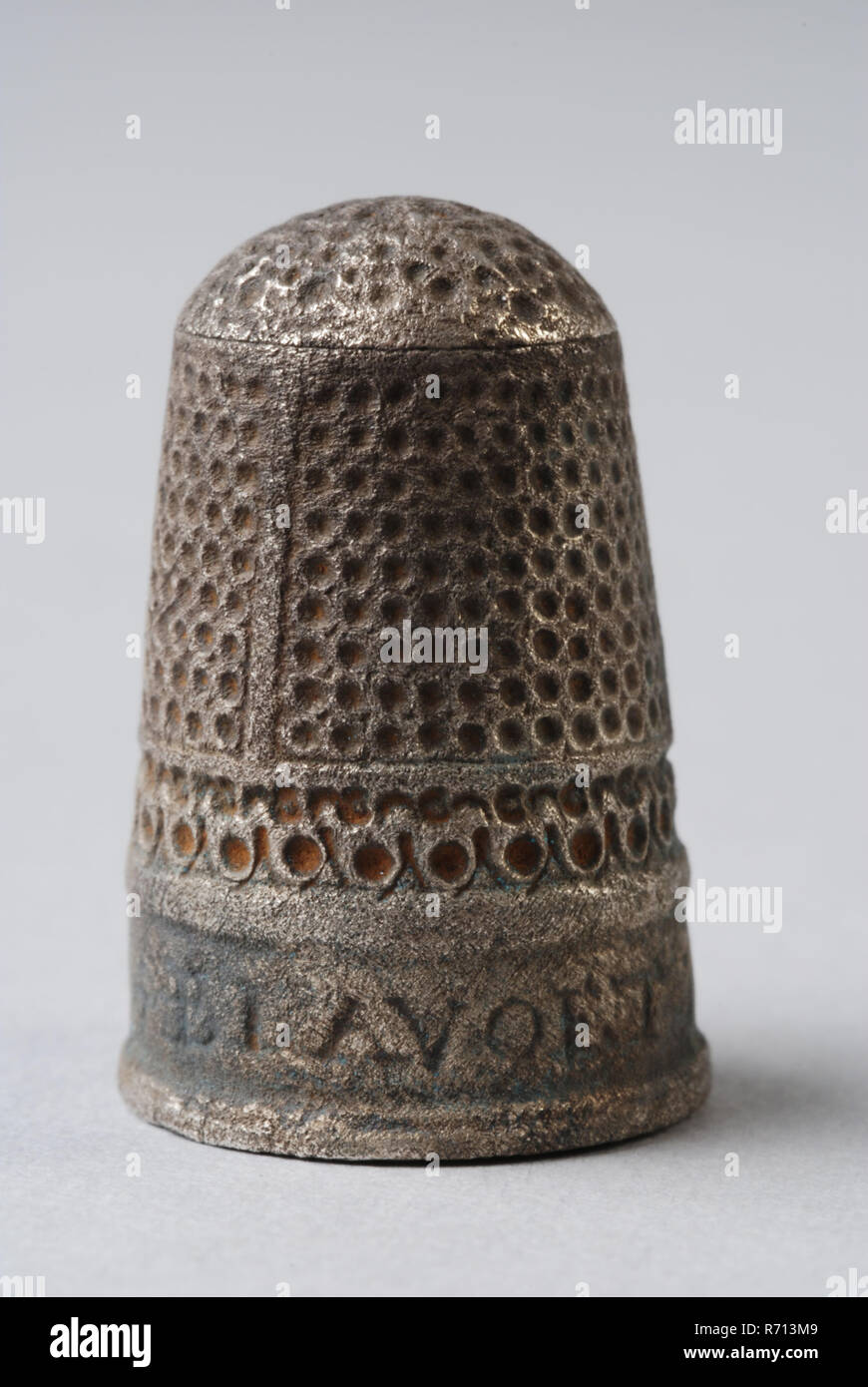 Silver thimble with pattern of pits, along the bottom edge of the inscription Catalina Blavoet 1595, thimble sewing kit soil find silver metal, cast Silver thimble with bottom edge with Catalina Blavoet 1595 with attached ring and band with rings above it; above that, protruded side irregularly of large and in vertical lines divided by means of bands into three compartments; moderately thick wall; groove between side and top; top is finely drawn in spiral shape with sun or star on the spherical top; possible silver mark on the inside CATALINA BLAVOET 1595 archeology Rotterdam Stadscentrum Stad Stock Photohttps://www.alamy.com/image-license-details/?v=1https://www.alamy.com/silver-thimble-with-pattern-of-pits-along-the-bottom-edge-of-the-inscription-catalina-blavoet-1595-thimble-sewing-kit-soil-find-silver-metal-cast-silver-thimble-with-bottom-edge-with-catalina-blavoet-1595-with-attached-ring-and-band-with-rings-above-it-above-that-protruded-side-irregularly-of-large-and-in-vertical-lines-divided-by-means-of-bands-into-three-compartments-moderately-thick-wall-groove-between-side-and-top-top-is-finely-drawn-in-spiral-shape-with-sun-or-star-on-the-spherical-top-possible-silver-mark-on-the-inside-catalina-blavoet-1595-archeology-rotterdam-stadscentrum-stad-image228062249.html
Silver thimble with pattern of pits, along the bottom edge of the inscription Catalina Blavoet 1595, thimble sewing kit soil find silver metal, cast Silver thimble with bottom edge with Catalina Blavoet 1595 with attached ring and band with rings above it; above that, protruded side irregularly of large and in vertical lines divided by means of bands into three compartments; moderately thick wall; groove between side and top; top is finely drawn in spiral shape with sun or star on the spherical top; possible silver mark on the inside CATALINA BLAVOET 1595 archeology Rotterdam Stadscentrum Stad Stock Photohttps://www.alamy.com/image-license-details/?v=1https://www.alamy.com/silver-thimble-with-pattern-of-pits-along-the-bottom-edge-of-the-inscription-catalina-blavoet-1595-thimble-sewing-kit-soil-find-silver-metal-cast-silver-thimble-with-bottom-edge-with-catalina-blavoet-1595-with-attached-ring-and-band-with-rings-above-it-above-that-protruded-side-irregularly-of-large-and-in-vertical-lines-divided-by-means-of-bands-into-three-compartments-moderately-thick-wall-groove-between-side-and-top-top-is-finely-drawn-in-spiral-shape-with-sun-or-star-on-the-spherical-top-possible-silver-mark-on-the-inside-catalina-blavoet-1595-archeology-rotterdam-stadscentrum-stad-image228062249.htmlRMR713M9–Silver thimble with pattern of pits, along the bottom edge of the inscription Catalina Blavoet 1595, thimble sewing kit soil find silver metal, cast Silver thimble with bottom edge with Catalina Blavoet 1595 with attached ring and band with rings above it; above that, protruded side irregularly of large and in vertical lines divided by means of bands into three compartments; moderately thick wall; groove between side and top; top is finely drawn in spiral shape with sun or star on the spherical top; possible silver mark on the inside CATALINA BLAVOET 1595 archeology Rotterdam Stadscentrum Stad
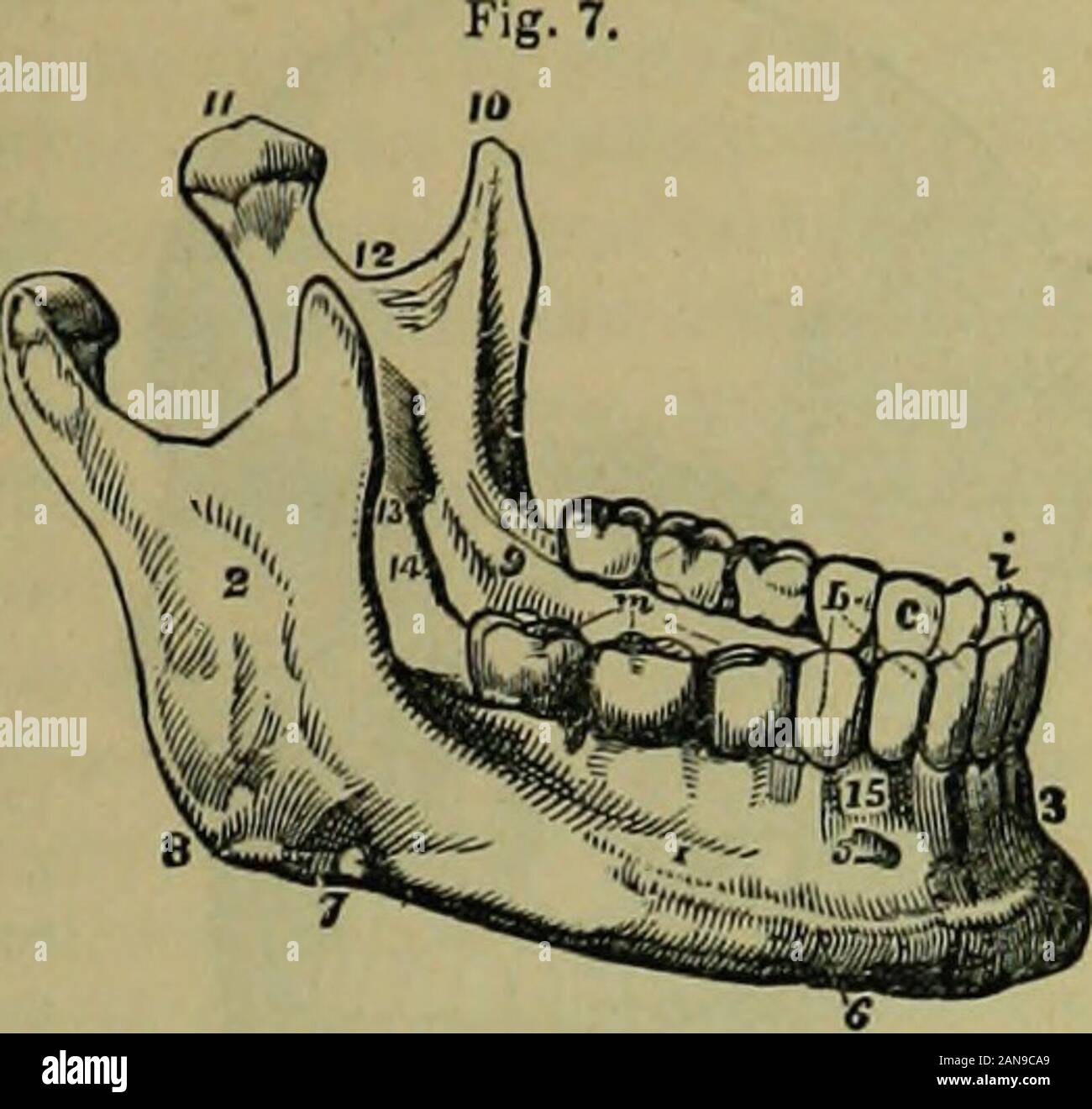 The hydropathic encyclopedia: a system of hydropathy and hygiene .. . ht, spongy, irregularly curvedbones, projecting inward toward the septum narium, or partition of thenose. Each one is attached to the maxillary bone in front, and thepalate bone behind. The Vomer is a thin quadrilateril piece, forming the back and lowoipart of the septum of the nose OS TED LOT, Y. 61 The Inferior Mc ciliary bone, or lov er jaw, is an arch of bone contain-ing the unrW iow of teeth. Itsdistinctive parts are shown in fig. 7. 1. The body. 2. The ramus. 3 TheSymphisis, or point of union. 4. Fossator the depressi Stock Photohttps://www.alamy.com/image-license-details/?v=1https://www.alamy.com/the-hydropathic-encyclopedia-a-system-of-hydropathy-and-hygiene-ht-spongy-irregularly-curvedbones-projecting-inward-toward-the-septum-narium-or-partition-of-thenose-each-one-is-attached-to-the-maxillary-bone-in-front-and-thepalate-bone-behind-the-vomer-is-a-thin-quadrilateril-piece-forming-the-back-and-lowoipart-of-the-septum-of-the-nose-os-ted-lot-y-61-the-inferior-mc-ciliary-bone-or-lov-er-jaw-is-an-arch-of-bone-contain-ing-the-unrw-iow-of-teeth-itsdistinctive-parts-are-shown-in-fig-7-1-the-body-2-the-ramus-3-thesymphisis-or-point-of-union-4-fossator-the-depressi-image340112033.html
The hydropathic encyclopedia: a system of hydropathy and hygiene .. . ht, spongy, irregularly curvedbones, projecting inward toward the septum narium, or partition of thenose. Each one is attached to the maxillary bone in front, and thepalate bone behind. The Vomer is a thin quadrilateril piece, forming the back and lowoipart of the septum of the nose OS TED LOT, Y. 61 The Inferior Mc ciliary bone, or lov er jaw, is an arch of bone contain-ing the unrW iow of teeth. Itsdistinctive parts are shown in fig. 7. 1. The body. 2. The ramus. 3 TheSymphisis, or point of union. 4. Fossator the depressi Stock Photohttps://www.alamy.com/image-license-details/?v=1https://www.alamy.com/the-hydropathic-encyclopedia-a-system-of-hydropathy-and-hygiene-ht-spongy-irregularly-curvedbones-projecting-inward-toward-the-septum-narium-or-partition-of-thenose-each-one-is-attached-to-the-maxillary-bone-in-front-and-thepalate-bone-behind-the-vomer-is-a-thin-quadrilateril-piece-forming-the-back-and-lowoipart-of-the-septum-of-the-nose-os-ted-lot-y-61-the-inferior-mc-ciliary-bone-or-lov-er-jaw-is-an-arch-of-bone-contain-ing-the-unrw-iow-of-teeth-itsdistinctive-parts-are-shown-in-fig-7-1-the-body-2-the-ramus-3-thesymphisis-or-point-of-union-4-fossator-the-depressi-image340112033.htmlRM2AN9CA9–The hydropathic encyclopedia: a system of hydropathy and hygiene .. . ht, spongy, irregularly curvedbones, projecting inward toward the septum narium, or partition of thenose. Each one is attached to the maxillary bone in front, and thepalate bone behind. The Vomer is a thin quadrilateril piece, forming the back and lowoipart of the septum of the nose OS TED LOT, Y. 61 The Inferior Mc ciliary bone, or lov er jaw, is an arch of bone contain-ing the unrW iow of teeth. Itsdistinctive parts are shown in fig. 7. 1. The body. 2. The ramus. 3 TheSymphisis, or point of union. 4. Fossator the depressi
 . The Danish Ingolf-expedition. Marine animals -- Arctic regions; Scientific expeditions; Arctic regions. 68 ACTINIARIA The proximal part is rounded and fusing into the middle without distinct outline. No distinct pliysa is present. The scapus is provided with a sometimes thin, sometimes thick, but translucent, often irregularly wrinkled cuticle, to the outside of which small grains and a great number of detritus-particles are attached. Under low magnifying powers small papilliform elevations are to be seen, which are, however, not regularly arranged, thej' are as yet only thickenings of the e Stock Photohttps://www.alamy.com/image-license-details/?v=1https://www.alamy.com/the-danish-ingolf-expedition-marine-animals-arctic-regions-scientific-expeditions-arctic-regions-68-actiniaria-the-proximal-part-is-rounded-and-fusing-into-the-middle-without-distinct-outline-no-distinct-pliysa-is-present-the-scapus-is-provided-with-a-sometimes-thin-sometimes-thick-but-translucent-often-irregularly-wrinkled-cuticle-to-the-outside-of-which-small-grains-and-a-great-number-of-detritus-particles-are-attached-under-low-magnifying-powers-small-papilliform-elevations-are-to-be-seen-which-are-however-not-regularly-arranged-thej-are-as-yet-only-thickenings-of-the-e-image216155309.html
. The Danish Ingolf-expedition. Marine animals -- Arctic regions; Scientific expeditions; Arctic regions. 68 ACTINIARIA The proximal part is rounded and fusing into the middle without distinct outline. No distinct pliysa is present. The scapus is provided with a sometimes thin, sometimes thick, but translucent, often irregularly wrinkled cuticle, to the outside of which small grains and a great number of detritus-particles are attached. Under low magnifying powers small papilliform elevations are to be seen, which are, however, not regularly arranged, thej' are as yet only thickenings of the e Stock Photohttps://www.alamy.com/image-license-details/?v=1https://www.alamy.com/the-danish-ingolf-expedition-marine-animals-arctic-regions-scientific-expeditions-arctic-regions-68-actiniaria-the-proximal-part-is-rounded-and-fusing-into-the-middle-without-distinct-outline-no-distinct-pliysa-is-present-the-scapus-is-provided-with-a-sometimes-thin-sometimes-thick-but-translucent-often-irregularly-wrinkled-cuticle-to-the-outside-of-which-small-grains-and-a-great-number-of-detritus-particles-are-attached-under-low-magnifying-powers-small-papilliform-elevations-are-to-be-seen-which-are-however-not-regularly-arranged-thej-are-as-yet-only-thickenings-of-the-e-image216155309.htmlRMPFJM8D–. The Danish Ingolf-expedition. Marine animals -- Arctic regions; Scientific expeditions; Arctic regions. 68 ACTINIARIA The proximal part is rounded and fusing into the middle without distinct outline. No distinct pliysa is present. The scapus is provided with a sometimes thin, sometimes thick, but translucent, often irregularly wrinkled cuticle, to the outside of which small grains and a great number of detritus-particles are attached. Under low magnifying powers small papilliform elevations are to be seen, which are, however, not regularly arranged, thej' are as yet only thickenings of the e
 Text-book of ophthalmology . Fig. 220. Fig. 221. Fig. 220.—Capsular Epithelium of the Cortex. (After Rabl.) The epithelium which wasleft attached to the capsule when the latter was stripped off is seen in surface view. The area repre-sented lies directly in front of the nuclear zone of the lens. In front of the latter the epithelial cells,which further forward are disposed irregularly (u), become arranged in regular meridional rows, m.Fig. 221.—Equatorial Section Through a Human Lens. (After Rabl.) e, epithelial cells ofthe anterior capsule; /, cross section of the lens fibers which are arrang Stock Photohttps://www.alamy.com/image-license-details/?v=1https://www.alamy.com/text-book-of-ophthalmology-fig-220-fig-221-fig-220capsular-epithelium-of-the-cortex-after-rabl-the-epithelium-which-wasleft-attached-to-the-capsule-when-the-latter-was-stripped-off-is-seen-in-surface-view-the-area-repre-sented-lies-directly-in-front-of-the-nuclear-zone-of-the-lens-in-front-of-the-latter-the-epithelial-cellswhich-further-forward-are-disposed-irregularly-u-become-arranged-in-regular-meridional-rows-mfig-221equatorial-section-through-a-human-lens-after-rabl-e-epithelial-cells-ofthe-anterior-capsule-cross-section-of-the-lens-fibers-which-are-arrang-image340006923.html
Text-book of ophthalmology . Fig. 220. Fig. 221. Fig. 220.—Capsular Epithelium of the Cortex. (After Rabl.) The epithelium which wasleft attached to the capsule when the latter was stripped off is seen in surface view. The area repre-sented lies directly in front of the nuclear zone of the lens. In front of the latter the epithelial cells,which further forward are disposed irregularly (u), become arranged in regular meridional rows, m.Fig. 221.—Equatorial Section Through a Human Lens. (After Rabl.) e, epithelial cells ofthe anterior capsule; /, cross section of the lens fibers which are arrang Stock Photohttps://www.alamy.com/image-license-details/?v=1https://www.alamy.com/text-book-of-ophthalmology-fig-220-fig-221-fig-220capsular-epithelium-of-the-cortex-after-rabl-the-epithelium-which-wasleft-attached-to-the-capsule-when-the-latter-was-stripped-off-is-seen-in-surface-view-the-area-repre-sented-lies-directly-in-front-of-the-nuclear-zone-of-the-lens-in-front-of-the-latter-the-epithelial-cellswhich-further-forward-are-disposed-irregularly-u-become-arranged-in-regular-meridional-rows-mfig-221equatorial-section-through-a-human-lens-after-rabl-e-epithelial-cells-ofthe-anterior-capsule-cross-section-of-the-lens-fibers-which-are-arrang-image340006923.htmlRM2AN4J8B–Text-book of ophthalmology . Fig. 220. Fig. 221. Fig. 220.—Capsular Epithelium of the Cortex. (After Rabl.) The epithelium which wasleft attached to the capsule when the latter was stripped off is seen in surface view. The area repre-sented lies directly in front of the nuclear zone of the lens. In front of the latter the epithelial cells,which further forward are disposed irregularly (u), become arranged in regular meridional rows, m.Fig. 221.—Equatorial Section Through a Human Lens. (After Rabl.) e, epithelial cells ofthe anterior capsule; /, cross section of the lens fibers which are arrang
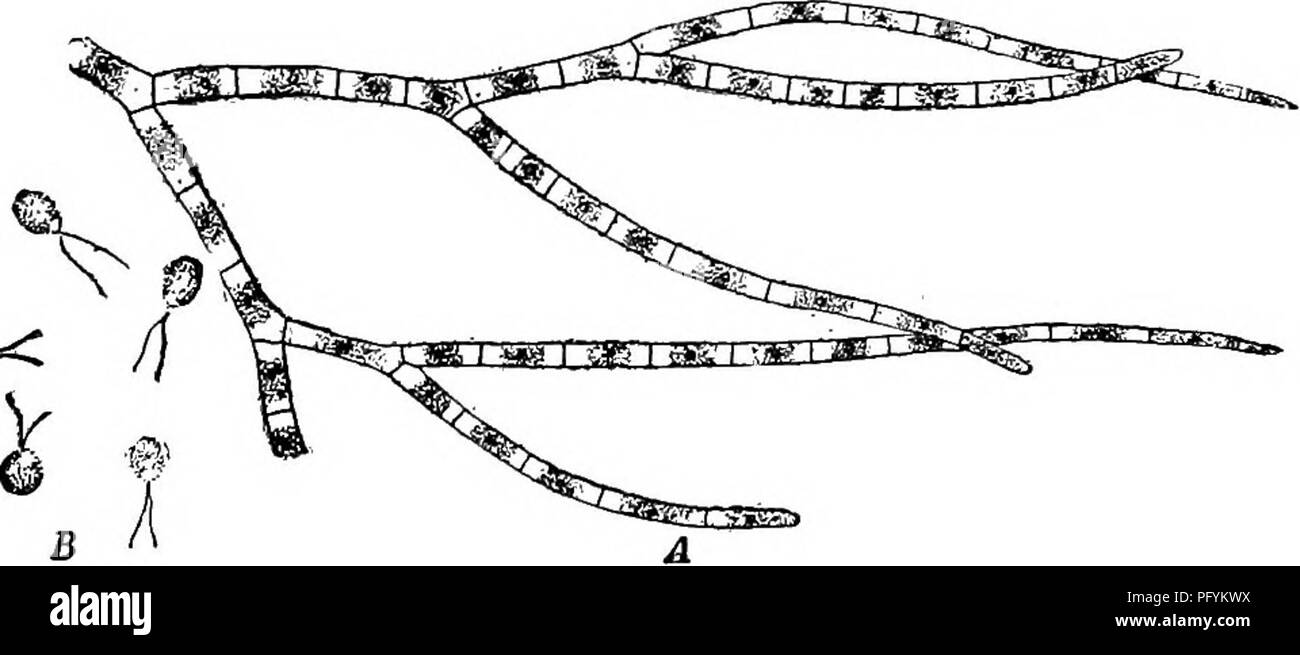 . Fresh-water biology. Freshwater biology. i68 FRESH-WATER BIOLOGY 233 (220) Chromatophore a single equatorial band, with one pyrenoid. Fila- ments branched, attached, frequently with a gelatinous cov- ering. Reproduction by zoospores and isogametes. Family Chaetophoeaceae . 234 234 (242) The zoosporangia of the same form as the vegetative cells; the larger species usually bearing long hairs. Subfamily Cha'etophoreae . 235 ^iS (239) Plant attached, differentiated into base and apex 236 236 (237, 238) Filaments imbedded in a firm, gelatinous matrix, forming a spherical or an irregularly branche Stock Photohttps://www.alamy.com/image-license-details/?v=1https://www.alamy.com/fresh-water-biology-freshwater-biology-i68-fresh-water-biology-233-220-chromatophore-a-single-equatorial-band-with-one-pyrenoid-fila-ments-branched-attached-frequently-with-a-gelatinous-cov-ering-reproduction-by-zoospores-and-isogametes-family-chaetophoeaceae-234-234-242-the-zoosporangia-of-the-same-form-as-the-vegetative-cells-the-larger-species-usually-bearing-long-hairs-subfamily-chaetophoreae-235-is-239-plant-attached-differentiated-into-base-and-apex-236-236-237-238-filaments-imbedded-in-a-firm-gelatinous-matrix-forming-a-spherical-or-an-irregularly-branche-image216352582.html
. Fresh-water biology. Freshwater biology. i68 FRESH-WATER BIOLOGY 233 (220) Chromatophore a single equatorial band, with one pyrenoid. Fila- ments branched, attached, frequently with a gelatinous cov- ering. Reproduction by zoospores and isogametes. Family Chaetophoeaceae . 234 234 (242) The zoosporangia of the same form as the vegetative cells; the larger species usually bearing long hairs. Subfamily Cha'etophoreae . 235 ^iS (239) Plant attached, differentiated into base and apex 236 236 (237, 238) Filaments imbedded in a firm, gelatinous matrix, forming a spherical or an irregularly branche Stock Photohttps://www.alamy.com/image-license-details/?v=1https://www.alamy.com/fresh-water-biology-freshwater-biology-i68-fresh-water-biology-233-220-chromatophore-a-single-equatorial-band-with-one-pyrenoid-fila-ments-branched-attached-frequently-with-a-gelatinous-cov-ering-reproduction-by-zoospores-and-isogametes-family-chaetophoeaceae-234-234-242-the-zoosporangia-of-the-same-form-as-the-vegetative-cells-the-larger-species-usually-bearing-long-hairs-subfamily-chaetophoreae-235-is-239-plant-attached-differentiated-into-base-and-apex-236-236-237-238-filaments-imbedded-in-a-firm-gelatinous-matrix-forming-a-spherical-or-an-irregularly-branche-image216352582.htmlRMPFYKWX–. Fresh-water biology. Freshwater biology. i68 FRESH-WATER BIOLOGY 233 (220) Chromatophore a single equatorial band, with one pyrenoid. Fila- ments branched, attached, frequently with a gelatinous cov- ering. Reproduction by zoospores and isogametes. Family Chaetophoeaceae . 234 234 (242) The zoosporangia of the same form as the vegetative cells; the larger species usually bearing long hairs. Subfamily Cha'etophoreae . 235 ^iS (239) Plant attached, differentiated into base and apex 236 236 (237, 238) Filaments imbedded in a firm, gelatinous matrix, forming a spherical or an irregularly branche
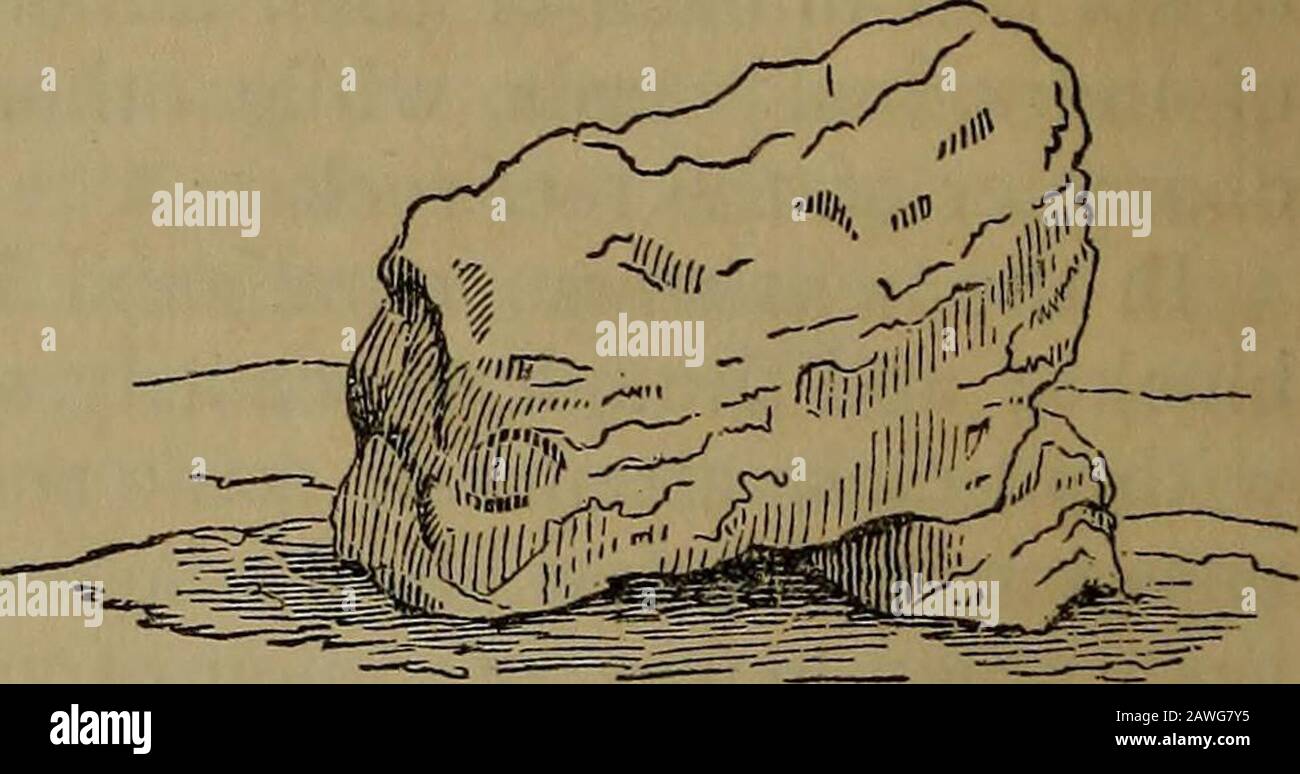 On coral reefs and islands . Figure 1 represents a mass on the island of Waterland, (one ofthe Paumotus,) six feet high, and about five in diameter; it wassolid with the reef-rock below, as though a part of it, and abouttwo feet above its base, it had been so nearly worn off by thewaters as to have become irregularly top-shape. Figure 2 is. 30 ON CORAL HEEFS AND ISLANDS. another mass, similarly attached to the reef at base, observed onKawehe, (Yincennes Island.) It was six feet high above lowwater level, and seven feet in its longest diameter. Below, ithad been worn like the one just described Stock Photohttps://www.alamy.com/image-license-details/?v=1https://www.alamy.com/on-coral-reefs-and-islands-figure-1-represents-a-mass-on-the-island-of-waterland-one-ofthe-paumotus-six-feet-high-and-about-five-in-diameter-it-wassolid-with-the-reef-rock-below-as-though-a-part-of-it-and-abouttwo-feet-above-its-base-it-had-been-so-nearly-worn-off-by-thewaters-as-to-have-become-irregularly-top-shape-figure-2-is-30-on-coral-heefs-and-islands-another-mass-similarly-attached-to-the-reef-at-base-observed-onkawehe-yincennes-island-it-was-six-feet-high-above-lowwater-level-and-seven-feet-in-its-longest-diameter-below-ithad-been-worn-like-the-one-just-described-image342720873.html
On coral reefs and islands . Figure 1 represents a mass on the island of Waterland, (one ofthe Paumotus,) six feet high, and about five in diameter; it wassolid with the reef-rock below, as though a part of it, and abouttwo feet above its base, it had been so nearly worn off by thewaters as to have become irregularly top-shape. Figure 2 is. 30 ON CORAL HEEFS AND ISLANDS. another mass, similarly attached to the reef at base, observed onKawehe, (Yincennes Island.) It was six feet high above lowwater level, and seven feet in its longest diameter. Below, ithad been worn like the one just described Stock Photohttps://www.alamy.com/image-license-details/?v=1https://www.alamy.com/on-coral-reefs-and-islands-figure-1-represents-a-mass-on-the-island-of-waterland-one-ofthe-paumotus-six-feet-high-and-about-five-in-diameter-it-wassolid-with-the-reef-rock-below-as-though-a-part-of-it-and-abouttwo-feet-above-its-base-it-had-been-so-nearly-worn-off-by-thewaters-as-to-have-become-irregularly-top-shape-figure-2-is-30-on-coral-heefs-and-islands-another-mass-similarly-attached-to-the-reef-at-base-observed-onkawehe-yincennes-island-it-was-six-feet-high-above-lowwater-level-and-seven-feet-in-its-longest-diameter-below-ithad-been-worn-like-the-one-just-described-image342720873.htmlRM2AWG7Y5–On coral reefs and islands . Figure 1 represents a mass on the island of Waterland, (one ofthe Paumotus,) six feet high, and about five in diameter; it wassolid with the reef-rock below, as though a part of it, and abouttwo feet above its base, it had been so nearly worn off by thewaters as to have become irregularly top-shape. Figure 2 is. 30 ON CORAL HEEFS AND ISLANDS. another mass, similarly attached to the reef at base, observed onKawehe, (Yincennes Island.) It was six feet high above lowwater level, and seven feet in its longest diameter. Below, ithad been worn like the one just described
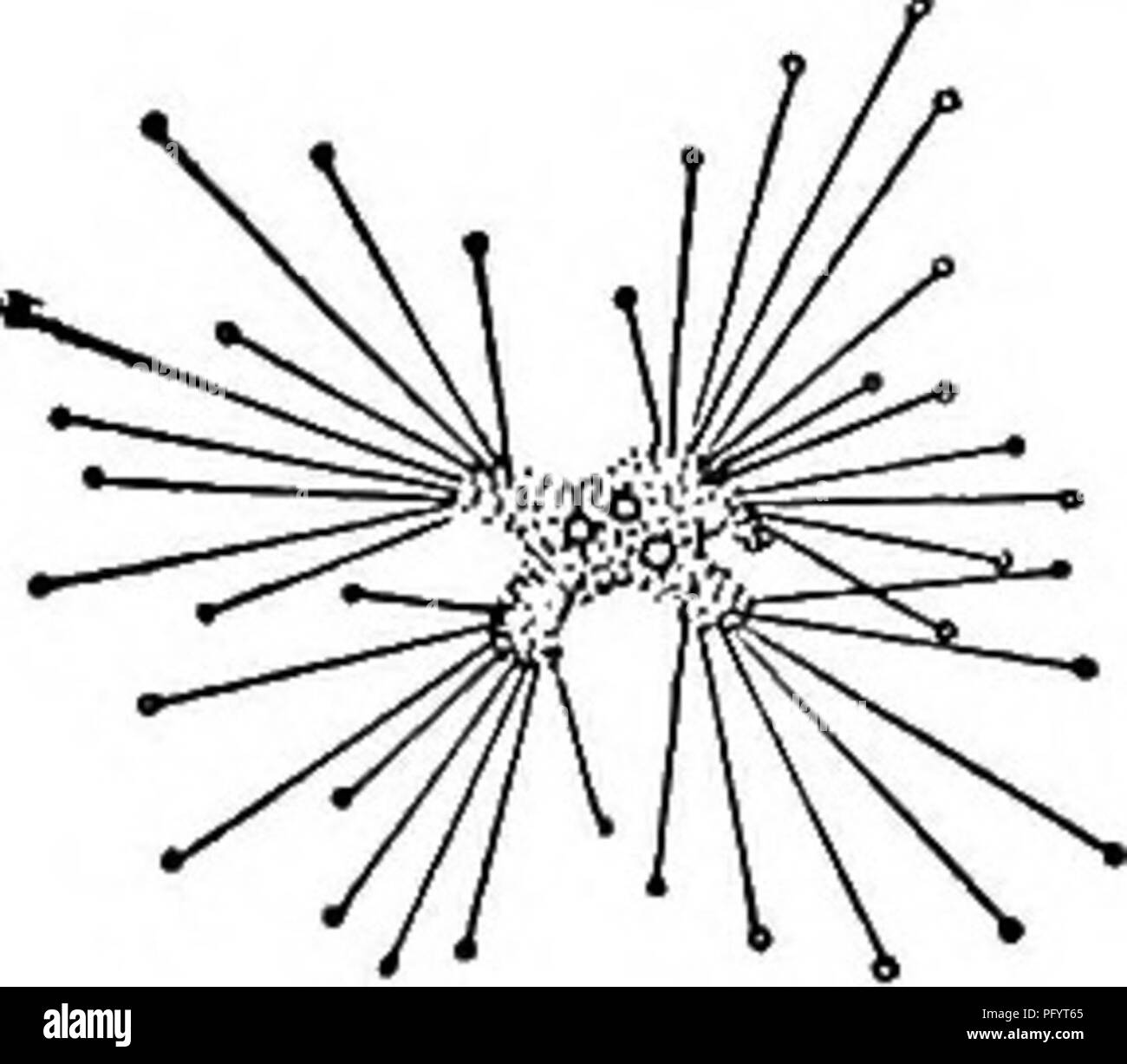 . Fresh-water biology. Freshwater biology. 220 (211) With a lorica 221 221 (224) Lorica sessile 222 222 (223) Usually cup-shaped or subspherical; tentacles suctorial, sometimes in groups. . Solenophrya Claparede and Lachmann. Representative species Solenophrya pera Stokes 1885. Lorica irregularly cubical or satchel-shaped, hyaline, widest at the base of attachment, narrowing anteriorly, witli the sides somewhat concave. Zooid oval, not attached to bottom of lorica. Tentacles arising from the entire frontal border. Two individuals often in the same lorica. Height of lorica 40 /x. Width and leng Stock Photohttps://www.alamy.com/image-license-details/?v=1https://www.alamy.com/fresh-water-biology-freshwater-biology-220-211-with-a-lorica-221-221-224-lorica-sessile-222-222-223-usually-cup-shaped-or-subspherical-tentacles-suctorial-sometimes-in-groups-solenophrya-claparede-and-lachmann-representative-species-solenophrya-pera-stokes-1885-lorica-irregularly-cubical-or-satchel-shaped-hyaline-widest-at-the-base-of-attachment-narrowing-anteriorly-witli-the-sides-somewhat-concave-zooid-oval-not-attached-to-bottom-of-lorica-tentacles-arising-from-the-entire-frontal-border-two-individuals-often-in-the-same-lorica-height-of-lorica-40-x-width-and-leng-image216355949.html
. Fresh-water biology. Freshwater biology. 220 (211) With a lorica 221 221 (224) Lorica sessile 222 222 (223) Usually cup-shaped or subspherical; tentacles suctorial, sometimes in groups. . Solenophrya Claparede and Lachmann. Representative species Solenophrya pera Stokes 1885. Lorica irregularly cubical or satchel-shaped, hyaline, widest at the base of attachment, narrowing anteriorly, witli the sides somewhat concave. Zooid oval, not attached to bottom of lorica. Tentacles arising from the entire frontal border. Two individuals often in the same lorica. Height of lorica 40 /x. Width and leng Stock Photohttps://www.alamy.com/image-license-details/?v=1https://www.alamy.com/fresh-water-biology-freshwater-biology-220-211-with-a-lorica-221-221-224-lorica-sessile-222-222-223-usually-cup-shaped-or-subspherical-tentacles-suctorial-sometimes-in-groups-solenophrya-claparede-and-lachmann-representative-species-solenophrya-pera-stokes-1885-lorica-irregularly-cubical-or-satchel-shaped-hyaline-widest-at-the-base-of-attachment-narrowing-anteriorly-witli-the-sides-somewhat-concave-zooid-oval-not-attached-to-bottom-of-lorica-tentacles-arising-from-the-entire-frontal-border-two-individuals-often-in-the-same-lorica-height-of-lorica-40-x-width-and-leng-image216355949.htmlRMPFYT65–. Fresh-water biology. Freshwater biology. 220 (211) With a lorica 221 221 (224) Lorica sessile 222 222 (223) Usually cup-shaped or subspherical; tentacles suctorial, sometimes in groups. . Solenophrya Claparede and Lachmann. Representative species Solenophrya pera Stokes 1885. Lorica irregularly cubical or satchel-shaped, hyaline, widest at the base of attachment, narrowing anteriorly, witli the sides somewhat concave. Zooid oval, not attached to bottom of lorica. Tentacles arising from the entire frontal border. Two individuals often in the same lorica. Height of lorica 40 /x. Width and leng
 . The Cleveland medical journal. al. On the inner surface of the placenta are to be seennumerous spherical and irregularly shaped protuberances varying in size 584 The Cleveland Medical Journal from 2-3 mm. in diameter to 2 cm. in diameter. These protuberancesproject into the cavity of the ovum several mm. to i cm., and are coveredwith the smooth and glistening amniochorion. They are of a dullreddish-blue color. Toward one edge of the placenta is to be seen theembryo, attached by a small umbilical cord 8 mm. in length, the latterapparently being inserted directly into one of the protuberances. Stock Photohttps://www.alamy.com/image-license-details/?v=1https://www.alamy.com/the-cleveland-medical-journal-al-on-the-inner-surface-of-the-placenta-are-to-be-seennumerous-spherical-and-irregularly-shaped-protuberances-varying-in-size-584-the-cleveland-medical-journal-from-2-3-mm-in-diameter-to-2-cm-in-diameter-these-protuberancesproject-into-the-cavity-of-the-ovum-several-mm-to-i-cm-and-are-coveredwith-the-smooth-and-glistening-amniochorion-they-are-of-a-dullreddish-blue-color-toward-one-edge-of-the-placenta-is-to-be-seen-theembryo-attached-by-a-small-umbilical-cord-8-mm-in-length-the-latterapparently-being-inserted-directly-into-one-of-the-protuberances-image370517806.html
. The Cleveland medical journal. al. On the inner surface of the placenta are to be seennumerous spherical and irregularly shaped protuberances varying in size 584 The Cleveland Medical Journal from 2-3 mm. in diameter to 2 cm. in diameter. These protuberancesproject into the cavity of the ovum several mm. to i cm., and are coveredwith the smooth and glistening amniochorion. They are of a dullreddish-blue color. Toward one edge of the placenta is to be seen theembryo, attached by a small umbilical cord 8 mm. in length, the latterapparently being inserted directly into one of the protuberances. Stock Photohttps://www.alamy.com/image-license-details/?v=1https://www.alamy.com/the-cleveland-medical-journal-al-on-the-inner-surface-of-the-placenta-are-to-be-seennumerous-spherical-and-irregularly-shaped-protuberances-varying-in-size-584-the-cleveland-medical-journal-from-2-3-mm-in-diameter-to-2-cm-in-diameter-these-protuberancesproject-into-the-cavity-of-the-ovum-several-mm-to-i-cm-and-are-coveredwith-the-smooth-and-glistening-amniochorion-they-are-of-a-dullreddish-blue-color-toward-one-edge-of-the-placenta-is-to-be-seen-theembryo-attached-by-a-small-umbilical-cord-8-mm-in-length-the-latterapparently-being-inserted-directly-into-one-of-the-protuberances-image370517806.htmlRM2CEPF6P–. The Cleveland medical journal. al. On the inner surface of the placenta are to be seennumerous spherical and irregularly shaped protuberances varying in size 584 The Cleveland Medical Journal from 2-3 mm. in diameter to 2 cm. in diameter. These protuberancesproject into the cavity of the ovum several mm. to i cm., and are coveredwith the smooth and glistening amniochorion. They are of a dullreddish-blue color. Toward one edge of the placenta is to be seen theembryo, attached by a small umbilical cord 8 mm. in length, the latterapparently being inserted directly into one of the protuberances.
 . A cytological study of haploid Crepis capillaris plants. Karyokinesis; Crepis. 114 University of California Publications in Agricultural Sciences [Vol. 6 and later figures show, division of the chromosomes within a cell does not always proceed synchronously. Usually, however, the divi- sion begins later, and the chromosomes in the shape of attached twin spheres pass irregularly to the poles (fig. 5, b, c) or one may be left out of the spindle and fail to reach a pole, giving rise to three iso-. Please note that these images are extracted from scanned page images that may have been digitally Stock Photohttps://www.alamy.com/image-license-details/?v=1https://www.alamy.com/a-cytological-study-of-haploid-crepis-capillaris-plants-karyokinesis-crepis-114-university-of-california-publications-in-agricultural-sciences-vol-6-and-later-figures-show-division-of-the-chromosomes-within-a-cell-does-not-always-proceed-synchronously-usually-however-the-divi-sion-begins-later-and-the-chromosomes-in-the-shape-of-attached-twin-spheres-pass-irregularly-to-the-poles-fig-5-b-c-or-one-may-be-left-out-of-the-spindle-and-fail-to-reach-a-pole-giving-rise-to-three-iso-please-note-that-these-images-are-extracted-from-scanned-page-images-that-may-have-been-digitally-image216174904.html
. A cytological study of haploid Crepis capillaris plants. Karyokinesis; Crepis. 114 University of California Publications in Agricultural Sciences [Vol. 6 and later figures show, division of the chromosomes within a cell does not always proceed synchronously. Usually, however, the divi- sion begins later, and the chromosomes in the shape of attached twin spheres pass irregularly to the poles (fig. 5, b, c) or one may be left out of the spindle and fail to reach a pole, giving rise to three iso-. Please note that these images are extracted from scanned page images that may have been digitally Stock Photohttps://www.alamy.com/image-license-details/?v=1https://www.alamy.com/a-cytological-study-of-haploid-crepis-capillaris-plants-karyokinesis-crepis-114-university-of-california-publications-in-agricultural-sciences-vol-6-and-later-figures-show-division-of-the-chromosomes-within-a-cell-does-not-always-proceed-synchronously-usually-however-the-divi-sion-begins-later-and-the-chromosomes-in-the-shape-of-attached-twin-spheres-pass-irregularly-to-the-poles-fig-5-b-c-or-one-may-be-left-out-of-the-spindle-and-fail-to-reach-a-pole-giving-rise-to-three-iso-please-note-that-these-images-are-extracted-from-scanned-page-images-that-may-have-been-digitally-image216174904.htmlRMPFKH88–. A cytological study of haploid Crepis capillaris plants. Karyokinesis; Crepis. 114 University of California Publications in Agricultural Sciences [Vol. 6 and later figures show, division of the chromosomes within a cell does not always proceed synchronously. Usually, however, the divi- sion begins later, and the chromosomes in the shape of attached twin spheres pass irregularly to the poles (fig. 5, b, c) or one may be left out of the spindle and fail to reach a pole, giving rise to three iso-. Please note that these images are extracted from scanned page images that may have been digitally
 . Annals of surgery . e of junction. The attached fragments appearedto be composed of oxalate, phosphate and carbonate of lime. The stone wasbeing absorbed by fibroblasts in a rich capillary network and directly replacedby bone (Fig. 9). The stone was then broken and its middle portion foundto consist of a hard, dark bmwn, slightly laminated, irregularly spherical mass, 243 Fig. -Case I. Photograph of junction of stone and bone; (a) i$ stone composed of crystals, (ft) is invading capillaries and U) itrabecula of newly formed Done. DALLAS B. PHEMLSTRK which came to the suriacu on one side. Depo Stock Photohttps://www.alamy.com/image-license-details/?v=1https://www.alamy.com/annals-of-surgery-e-of-junction-the-attached-fragments-appearedto-be-composed-of-oxalate-phosphate-and-carbonate-of-lime-the-stone-wasbeing-absorbed-by-fibroblasts-in-a-rich-capillary-network-and-directly-replacedby-bone-fig-9-the-stone-was-then-broken-and-its-middle-portion-foundto-consist-of-a-hard-dark-bmwn-slightly-laminated-irregularly-spherical-mass-243-fig-case-i-photograph-of-junction-of-stone-and-bone-a-i-stone-composed-of-crystals-ft-is-invading-capillaries-and-u-itrabecula-of-newly-formed-done-dallas-b-phemlstrk-which-came-to-the-suriacu-on-one-side-depo-image370006294.html
. Annals of surgery . e of junction. The attached fragments appearedto be composed of oxalate, phosphate and carbonate of lime. The stone wasbeing absorbed by fibroblasts in a rich capillary network and directly replacedby bone (Fig. 9). The stone was then broken and its middle portion foundto consist of a hard, dark bmwn, slightly laminated, irregularly spherical mass, 243 Fig. -Case I. Photograph of junction of stone and bone; (a) i$ stone composed of crystals, (ft) is invading capillaries and U) itrabecula of newly formed Done. DALLAS B. PHEMLSTRK which came to the suriacu on one side. Depo Stock Photohttps://www.alamy.com/image-license-details/?v=1https://www.alamy.com/annals-of-surgery-e-of-junction-the-attached-fragments-appearedto-be-composed-of-oxalate-phosphate-and-carbonate-of-lime-the-stone-wasbeing-absorbed-by-fibroblasts-in-a-rich-capillary-network-and-directly-replacedby-bone-fig-9-the-stone-was-then-broken-and-its-middle-portion-foundto-consist-of-a-hard-dark-bmwn-slightly-laminated-irregularly-spherical-mass-243-fig-case-i-photograph-of-junction-of-stone-and-bone-a-i-stone-composed-of-crystals-ft-is-invading-capillaries-and-u-itrabecula-of-newly-formed-done-dallas-b-phemlstrk-which-came-to-the-suriacu-on-one-side-depo-image370006294.htmlRM2CDY6PE–. Annals of surgery . e of junction. The attached fragments appearedto be composed of oxalate, phosphate and carbonate of lime. The stone wasbeing absorbed by fibroblasts in a rich capillary network and directly replacedby bone (Fig. 9). The stone was then broken and its middle portion foundto consist of a hard, dark bmwn, slightly laminated, irregularly spherical mass, 243 Fig. -Case I. Photograph of junction of stone and bone; (a) i$ stone composed of crystals, (ft) is invading capillaries and U) itrabecula of newly formed Done. DALLAS B. PHEMLSTRK which came to the suriacu on one side. Depo
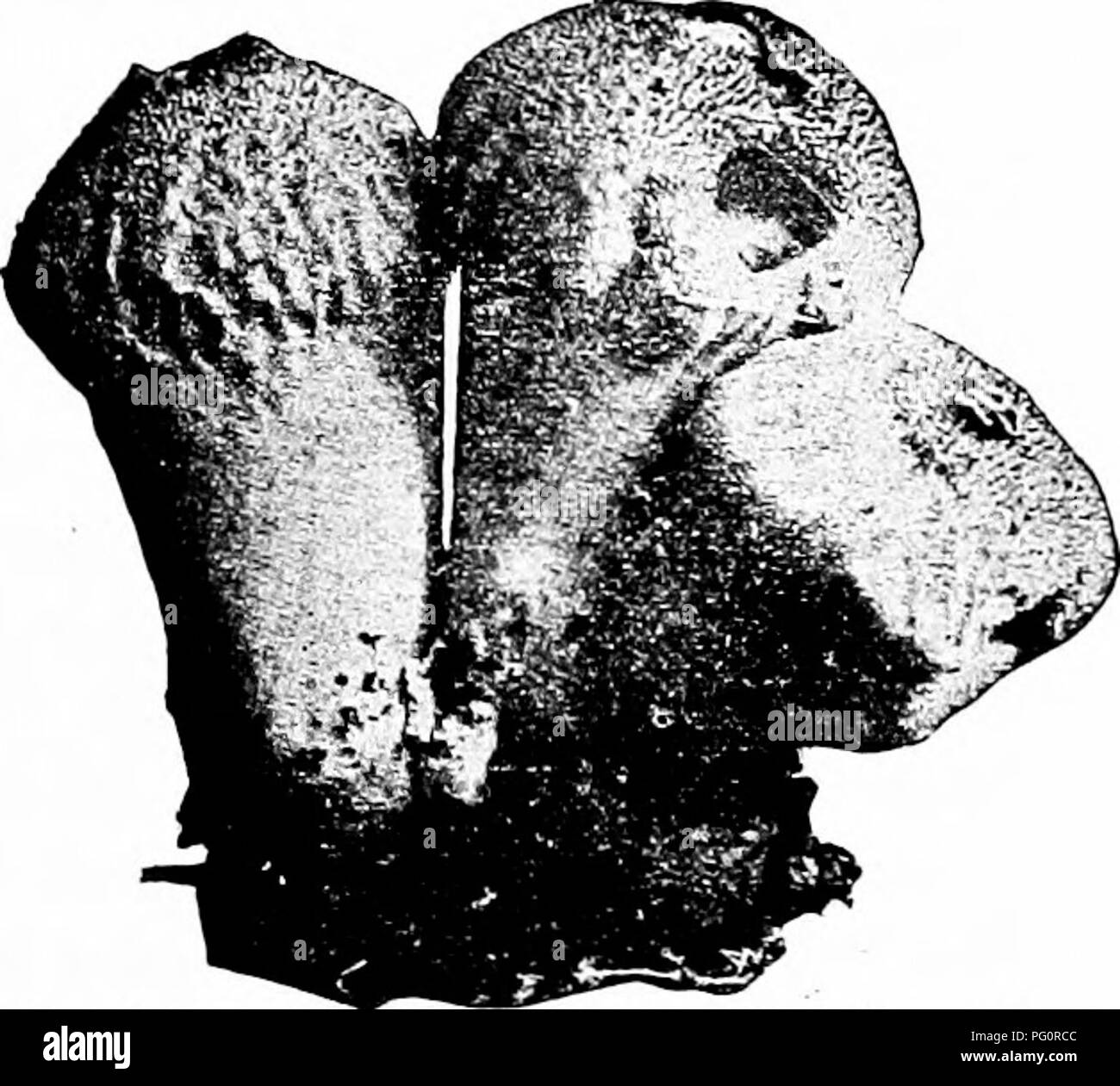 . The fungi which cause plant disease . Plant diseases; Fungi. THE FUNGI WHICH CAUSE PLANT DISEASE 465 Sporophore with a pronounced sterile persistent base Sporopliorc witliout a pronounced sterile base Inner peridium opening irregularly. Inner peridium opening by a basal pore, the outer peridium break- ing equatorially and the upper half with the attached inner peridium forcefully ejected Capillitium free, short-branched ynth pointed ends Sporophore with a pronounced per- sistent sterile base 4. Sporophore without a pronounced sterile base Inner peridium paperj', opening by an apical mouth 5. Stock Photohttps://www.alamy.com/image-license-details/?v=1https://www.alamy.com/the-fungi-which-cause-plant-disease-plant-diseases-fungi-the-fungi-which-cause-plant-disease-465-sporophore-with-a-pronounced-sterile-persistent-base-sporopliorc-witliout-a-pronounced-sterile-base-inner-peridium-opening-irregularly-inner-peridium-opening-by-a-basal-pore-the-outer-peridium-break-ing-equatorially-and-the-upper-half-with-the-attached-inner-peridium-forcefully-ejected-capillitium-free-short-branched-ynth-pointed-ends-sporophore-with-a-pronounced-per-sistent-sterile-base-4-sporophore-without-a-pronounced-sterile-base-inner-peridium-paperj-opening-by-an-apical-mouth-5-image216377292.html
. The fungi which cause plant disease . Plant diseases; Fungi. THE FUNGI WHICH CAUSE PLANT DISEASE 465 Sporophore with a pronounced sterile persistent base Sporopliorc witliout a pronounced sterile base Inner peridium opening irregularly. Inner peridium opening by a basal pore, the outer peridium break- ing equatorially and the upper half with the attached inner peridium forcefully ejected Capillitium free, short-branched ynth pointed ends Sporophore with a pronounced per- sistent sterile base 4. Sporophore without a pronounced sterile base Inner peridium paperj', opening by an apical mouth 5. Stock Photohttps://www.alamy.com/image-license-details/?v=1https://www.alamy.com/the-fungi-which-cause-plant-disease-plant-diseases-fungi-the-fungi-which-cause-plant-disease-465-sporophore-with-a-pronounced-sterile-persistent-base-sporopliorc-witliout-a-pronounced-sterile-base-inner-peridium-opening-irregularly-inner-peridium-opening-by-a-basal-pore-the-outer-peridium-break-ing-equatorially-and-the-upper-half-with-the-attached-inner-peridium-forcefully-ejected-capillitium-free-short-branched-ynth-pointed-ends-sporophore-with-a-pronounced-per-sistent-sterile-base-4-sporophore-without-a-pronounced-sterile-base-inner-peridium-paperj-opening-by-an-apical-mouth-5-image216377292.htmlRMPG0RCC–. The fungi which cause plant disease . Plant diseases; Fungi. THE FUNGI WHICH CAUSE PLANT DISEASE 465 Sporophore with a pronounced sterile persistent base Sporopliorc witliout a pronounced sterile base Inner peridium opening irregularly. Inner peridium opening by a basal pore, the outer peridium break- ing equatorially and the upper half with the attached inner peridium forcefully ejected Capillitium free, short-branched ynth pointed ends Sporophore with a pronounced per- sistent sterile base 4. Sporophore without a pronounced sterile base Inner peridium paperj', opening by an apical mouth 5.
 . The cell in development and inheritance. Cells; Cells. 72 CELL-DIVISION facts in its support, though neither his observations nor those of later investigators have sustained Van Beneden's account of the grouping of the astral rays. Boveri showed in the clearest manner that, during the fertilization of Ascaris, the astral rays become attached to the chromosomes of the germ-nuclei; that each comes into connection with rays from both the asters; that the chromosomes, at first irregularly scattered in the ^gg, are drawn into a position of equilibrium in the equator of the spindle by the shorteni Stock Photohttps://www.alamy.com/image-license-details/?v=1https://www.alamy.com/the-cell-in-development-and-inheritance-cells-cells-72-cell-division-facts-in-its-support-though-neither-his-observations-nor-those-of-later-investigators-have-sustained-van-benedens-account-of-the-grouping-of-the-astral-rays-boveri-showed-in-the-clearest-manner-that-during-the-fertilization-of-ascaris-the-astral-rays-become-attached-to-the-chromosomes-of-the-germ-nuclei-that-each-comes-into-connection-with-rays-from-both-the-asters-that-the-chromosomes-at-first-irregularly-scattered-in-the-gg-are-drawn-into-a-position-of-equilibrium-in-the-equator-of-the-spindle-by-the-shorteni-image235081888.html
. The cell in development and inheritance. Cells; Cells. 72 CELL-DIVISION facts in its support, though neither his observations nor those of later investigators have sustained Van Beneden's account of the grouping of the astral rays. Boveri showed in the clearest manner that, during the fertilization of Ascaris, the astral rays become attached to the chromosomes of the germ-nuclei; that each comes into connection with rays from both the asters; that the chromosomes, at first irregularly scattered in the ^gg, are drawn into a position of equilibrium in the equator of the spindle by the shorteni Stock Photohttps://www.alamy.com/image-license-details/?v=1https://www.alamy.com/the-cell-in-development-and-inheritance-cells-cells-72-cell-division-facts-in-its-support-though-neither-his-observations-nor-those-of-later-investigators-have-sustained-van-benedens-account-of-the-grouping-of-the-astral-rays-boveri-showed-in-the-clearest-manner-that-during-the-fertilization-of-ascaris-the-astral-rays-become-attached-to-the-chromosomes-of-the-germ-nuclei-that-each-comes-into-connection-with-rays-from-both-the-asters-that-the-chromosomes-at-first-irregularly-scattered-in-the-gg-are-drawn-into-a-position-of-equilibrium-in-the-equator-of-the-spindle-by-the-shorteni-image235081888.htmlRMRJCW9M–. The cell in development and inheritance. Cells; Cells. 72 CELL-DIVISION facts in its support, though neither his observations nor those of later investigators have sustained Van Beneden's account of the grouping of the astral rays. Boveri showed in the clearest manner that, during the fertilization of Ascaris, the astral rays become attached to the chromosomes of the germ-nuclei; that each comes into connection with rays from both the asters; that the chromosomes, at first irregularly scattered in the ^gg, are drawn into a position of equilibrium in the equator of the spindle by the shorteni
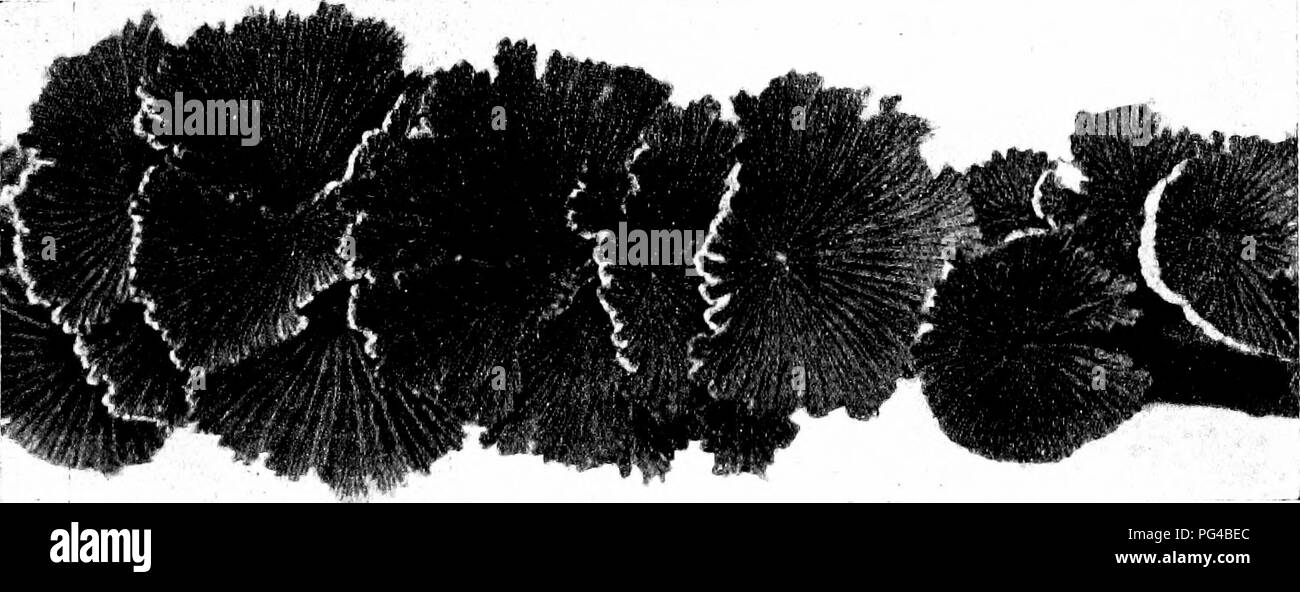 . Minnesota mushrooms ... Botany; Mushrooms. GILL FUNGI 51 SCHIZOPHYLLUJI Characterized by the two-forked edge of the gills, and the upturned woolly cap. Growing on wood ; not poisonous, but too tougli to be of value. Tlie name refers to the forked gills. Schizophyllum commune Fork Gill Cap 1-4 cm. wide, white- or gray-woolly, upturned, attached excentrically, irregularly saucer-shaped; stem lacking; gills grayish to purplish; spores subglobose, l-S/j.. The name refers to the frequence of the plant. Everywhere on dead or dying twigs and trunks, in forest, orchard, etc. ; not edible.. Figure 29 Stock Photohttps://www.alamy.com/image-license-details/?v=1https://www.alamy.com/minnesota-mushrooms-botany-mushrooms-gill-fungi-51-schizophylluji-characterized-by-the-two-forked-edge-of-the-gills-and-the-upturned-woolly-cap-growing-on-wood-not-poisonous-but-too-tougli-to-be-of-value-tlie-name-refers-to-the-forked-gills-schizophyllum-commune-fork-gill-cap-1-4-cm-wide-white-or-gray-woolly-upturned-attached-excentrically-irregularly-saucer-shaped-stem-lacking-gills-grayish-to-purplish-spores-subglobose-l-sj-the-name-refers-to-the-frequence-of-the-plant-everywhere-on-dead-or-dying-twigs-and-trunks-in-forest-orchard-etc-not-edible-figure-29-image216455748.html
. Minnesota mushrooms ... Botany; Mushrooms. GILL FUNGI 51 SCHIZOPHYLLUJI Characterized by the two-forked edge of the gills, and the upturned woolly cap. Growing on wood ; not poisonous, but too tougli to be of value. Tlie name refers to the forked gills. Schizophyllum commune Fork Gill Cap 1-4 cm. wide, white- or gray-woolly, upturned, attached excentrically, irregularly saucer-shaped; stem lacking; gills grayish to purplish; spores subglobose, l-S/j.. The name refers to the frequence of the plant. Everywhere on dead or dying twigs and trunks, in forest, orchard, etc. ; not edible.. Figure 29 Stock Photohttps://www.alamy.com/image-license-details/?v=1https://www.alamy.com/minnesota-mushrooms-botany-mushrooms-gill-fungi-51-schizophylluji-characterized-by-the-two-forked-edge-of-the-gills-and-the-upturned-woolly-cap-growing-on-wood-not-poisonous-but-too-tougli-to-be-of-value-tlie-name-refers-to-the-forked-gills-schizophyllum-commune-fork-gill-cap-1-4-cm-wide-white-or-gray-woolly-upturned-attached-excentrically-irregularly-saucer-shaped-stem-lacking-gills-grayish-to-purplish-spores-subglobose-l-sj-the-name-refers-to-the-frequence-of-the-plant-everywhere-on-dead-or-dying-twigs-and-trunks-in-forest-orchard-etc-not-edible-figure-29-image216455748.htmlRMPG4BEC–. Minnesota mushrooms ... Botany; Mushrooms. GILL FUNGI 51 SCHIZOPHYLLUJI Characterized by the two-forked edge of the gills, and the upturned woolly cap. Growing on wood ; not poisonous, but too tougli to be of value. Tlie name refers to the forked gills. Schizophyllum commune Fork Gill Cap 1-4 cm. wide, white- or gray-woolly, upturned, attached excentrically, irregularly saucer-shaped; stem lacking; gills grayish to purplish; spores subglobose, l-S/j.. The name refers to the frequence of the plant. Everywhere on dead or dying twigs and trunks, in forest, orchard, etc. ; not edible.. Figure 29
 . A Manual of botany : being an introduction to the study of the structure, physiology, and classification of plants . Botany. 314 INDEHISCENT SYNCAEPOUS FBTJITS. each other. The seeds are immersed in pulp, and are attached irregularly to the parietes, base, and centre. The fruit has been called Balausta {halaustiwm, flower of pomegranate), and the tough rind is called malicorium (a name applied to it by Pliny). The Pepo or Peponida (nrivuv, a pumpkin) is illustrated by the fruit of the Gourd, Melon (fig. 430, p. 245), and other Oucurbitacese, where the calyx is superior, the rind is thick and Stock Photohttps://www.alamy.com/image-license-details/?v=1https://www.alamy.com/a-manual-of-botany-being-an-introduction-to-the-study-of-the-structure-physiology-and-classification-of-plants-botany-314-indehiscent-syncaepous-fbtjits-each-other-the-seeds-are-immersed-in-pulp-and-are-attached-irregularly-to-the-parietes-base-and-centre-the-fruit-has-been-called-balausta-halaustiwm-flower-of-pomegranate-and-the-tough-rind-is-called-malicorium-a-name-applied-to-it-by-pliny-the-pepo-or-peponida-nrivuv-a-pumpkin-is-illustrated-by-the-fruit-of-the-gourd-melon-fig-430-p-245-and-other-oucurbitacese-where-the-calyx-is-superior-the-rind-is-thick-and-image232090197.html
. A Manual of botany : being an introduction to the study of the structure, physiology, and classification of plants . Botany. 314 INDEHISCENT SYNCAEPOUS FBTJITS. each other. The seeds are immersed in pulp, and are attached irregularly to the parietes, base, and centre. The fruit has been called Balausta {halaustiwm, flower of pomegranate), and the tough rind is called malicorium (a name applied to it by Pliny). The Pepo or Peponida (nrivuv, a pumpkin) is illustrated by the fruit of the Gourd, Melon (fig. 430, p. 245), and other Oucurbitacese, where the calyx is superior, the rind is thick and Stock Photohttps://www.alamy.com/image-license-details/?v=1https://www.alamy.com/a-manual-of-botany-being-an-introduction-to-the-study-of-the-structure-physiology-and-classification-of-plants-botany-314-indehiscent-syncaepous-fbtjits-each-other-the-seeds-are-immersed-in-pulp-and-are-attached-irregularly-to-the-parietes-base-and-centre-the-fruit-has-been-called-balausta-halaustiwm-flower-of-pomegranate-and-the-tough-rind-is-called-malicorium-a-name-applied-to-it-by-pliny-the-pepo-or-peponida-nrivuv-a-pumpkin-is-illustrated-by-the-fruit-of-the-gourd-melon-fig-430-p-245-and-other-oucurbitacese-where-the-calyx-is-superior-the-rind-is-thick-and-image232090197.htmlRMRDGHBH–. A Manual of botany : being an introduction to the study of the structure, physiology, and classification of plants . Botany. 314 INDEHISCENT SYNCAEPOUS FBTJITS. each other. The seeds are immersed in pulp, and are attached irregularly to the parietes, base, and centre. The fruit has been called Balausta {halaustiwm, flower of pomegranate), and the tough rind is called malicorium (a name applied to it by Pliny). The Pepo or Peponida (nrivuv, a pumpkin) is illustrated by the fruit of the Gourd, Melon (fig. 430, p. 245), and other Oucurbitacese, where the calyx is superior, the rind is thick and
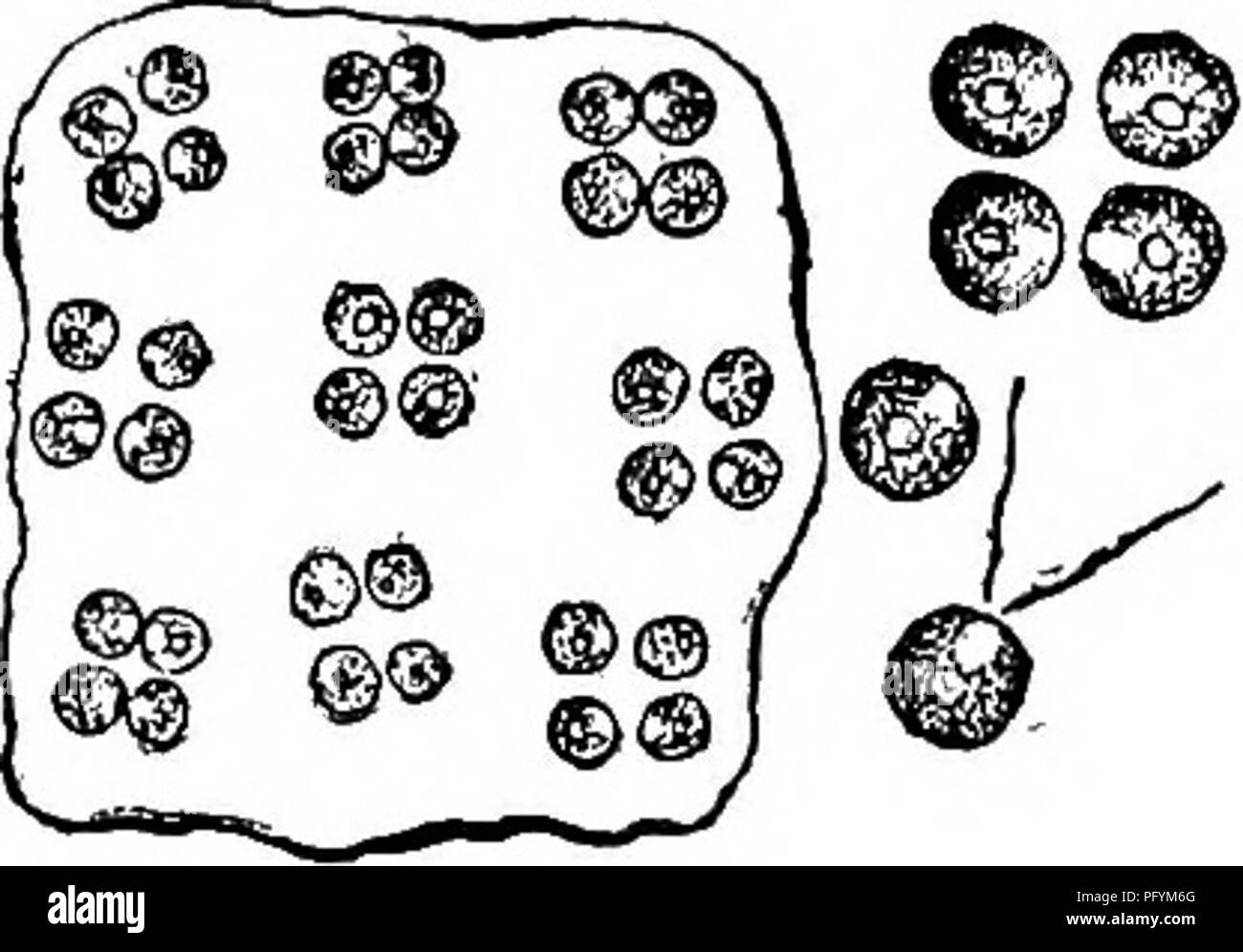 . Fresh-water biology. Freshwater biology. THE FRESH-WATER ALGAE 147 92 (93) Colonies macroscopic or microscopic, expanded or intestiform, cells arranged in fours Tetraspora Link. Reproduction by division in two directions; zoospores may originate directly from the vegetative cells, and by divi- sion give rise to a new colony; isogametes with two cilia may be formed, also resting spores with heavy brown walls. Fig. 153. Tetraspora explanata KUtzing. X 2So- (After Nageli.) 93 (92) Colonies pear-shaped, attached, cells irregularly placed near the surface Apiocystis Nageli.. Please note that thes Stock Photohttps://www.alamy.com/image-license-details/?v=1https://www.alamy.com/fresh-water-biology-freshwater-biology-the-fresh-water-algae-147-92-93-colonies-macroscopic-or-microscopic-expanded-or-intestiform-cells-arranged-in-fours-tetraspora-link-reproduction-by-division-in-two-directions-zoospores-may-originate-directly-from-the-vegetative-cells-and-by-divi-sion-give-rise-to-a-new-colony-isogametes-with-two-cilia-may-be-formed-also-resting-spores-with-heavy-brown-walls-fig-153-tetraspora-explanata-kutzing-x-2so-after-nageli-93-92-colonies-pear-shaped-attached-cells-irregularly-placed-near-the-surface-apiocystis-nageli-please-note-that-thes-image216352824.html
. Fresh-water biology. Freshwater biology. THE FRESH-WATER ALGAE 147 92 (93) Colonies macroscopic or microscopic, expanded or intestiform, cells arranged in fours Tetraspora Link. Reproduction by division in two directions; zoospores may originate directly from the vegetative cells, and by divi- sion give rise to a new colony; isogametes with two cilia may be formed, also resting spores with heavy brown walls. Fig. 153. Tetraspora explanata KUtzing. X 2So- (After Nageli.) 93 (92) Colonies pear-shaped, attached, cells irregularly placed near the surface Apiocystis Nageli.. Please note that thes Stock Photohttps://www.alamy.com/image-license-details/?v=1https://www.alamy.com/fresh-water-biology-freshwater-biology-the-fresh-water-algae-147-92-93-colonies-macroscopic-or-microscopic-expanded-or-intestiform-cells-arranged-in-fours-tetraspora-link-reproduction-by-division-in-two-directions-zoospores-may-originate-directly-from-the-vegetative-cells-and-by-divi-sion-give-rise-to-a-new-colony-isogametes-with-two-cilia-may-be-formed-also-resting-spores-with-heavy-brown-walls-fig-153-tetraspora-explanata-kutzing-x-2so-after-nageli-93-92-colonies-pear-shaped-attached-cells-irregularly-placed-near-the-surface-apiocystis-nageli-please-note-that-thes-image216352824.htmlRMPFYM6G–. Fresh-water biology. Freshwater biology. THE FRESH-WATER ALGAE 147 92 (93) Colonies macroscopic or microscopic, expanded or intestiform, cells arranged in fours Tetraspora Link. Reproduction by division in two directions; zoospores may originate directly from the vegetative cells, and by divi- sion give rise to a new colony; isogametes with two cilia may be formed, also resting spores with heavy brown walls. Fig. 153. Tetraspora explanata KUtzing. X 2So- (After Nageli.) 93 (92) Colonies pear-shaped, attached, cells irregularly placed near the surface Apiocystis Nageli.. Please note that thes
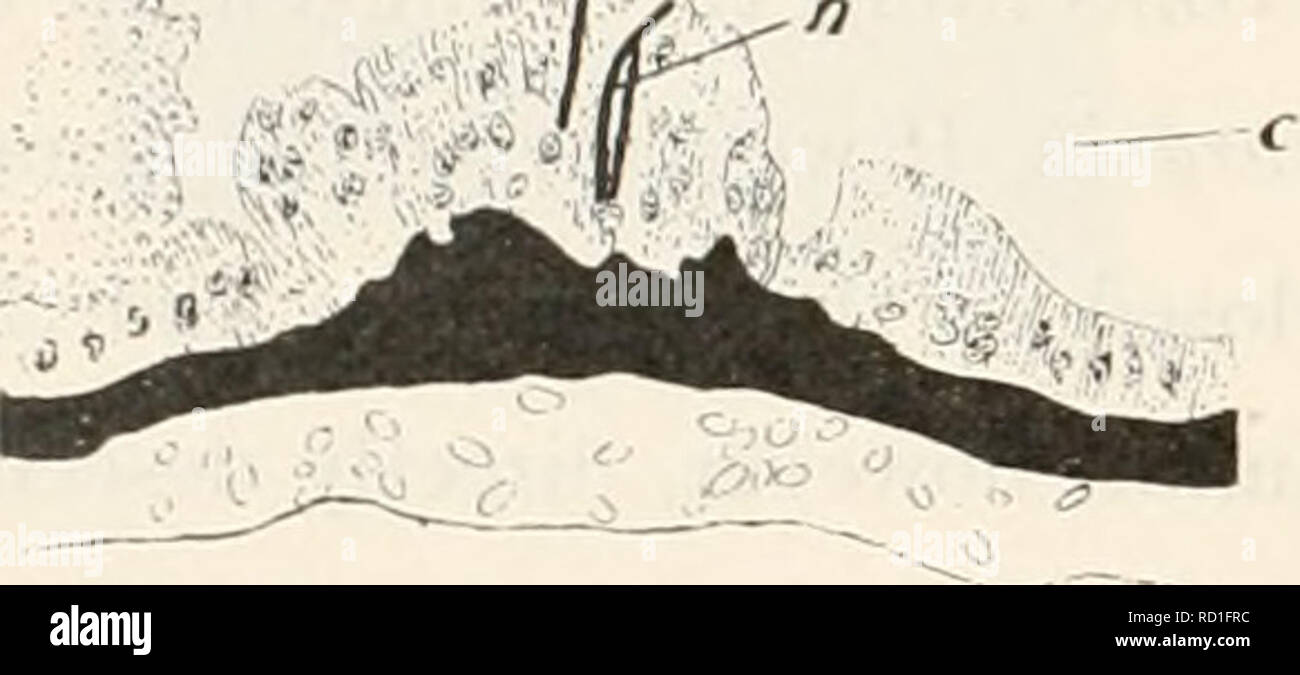 . The Danish Ingolf-Expedition. Scientific expeditions; Arctic Ocean. Fig. 83. The proximal part is rounded and fusing into the middle without distinct outline. No distinct physa is present. The scapus is provided with a sometimes thin, sometimes thick, but translucent, often irregularly wrinkled cuticle, to the outside of which small grains and a great number of detritus-particles are attached. Under low magnifying powers small papilliform elevations are to be seen, which are, however, not regularly arranged, they are as yet only thickenings of the ectoderm as may easily be ascertained on sec Stock Photohttps://www.alamy.com/image-license-details/?v=1https://www.alamy.com/the-danish-ingolf-expedition-scientific-expeditions-arctic-ocean-fig-83-the-proximal-part-is-rounded-and-fusing-into-the-middle-without-distinct-outline-no-distinct-physa-is-present-the-scapus-is-provided-with-a-sometimes-thin-sometimes-thick-but-translucent-often-irregularly-wrinkled-cuticle-to-the-outside-of-which-small-grains-and-a-great-number-of-detritus-particles-are-attached-under-low-magnifying-powers-small-papilliform-elevations-are-to-be-seen-which-are-however-not-regularly-arranged-they-are-as-yet-only-thickenings-of-the-ectoderm-as-may-easily-be-ascertained-on-sec-image231759680.html
. The Danish Ingolf-Expedition. Scientific expeditions; Arctic Ocean. Fig. 83. The proximal part is rounded and fusing into the middle without distinct outline. No distinct physa is present. The scapus is provided with a sometimes thin, sometimes thick, but translucent, often irregularly wrinkled cuticle, to the outside of which small grains and a great number of detritus-particles are attached. Under low magnifying powers small papilliform elevations are to be seen, which are, however, not regularly arranged, they are as yet only thickenings of the ectoderm as may easily be ascertained on sec Stock Photohttps://www.alamy.com/image-license-details/?v=1https://www.alamy.com/the-danish-ingolf-expedition-scientific-expeditions-arctic-ocean-fig-83-the-proximal-part-is-rounded-and-fusing-into-the-middle-without-distinct-outline-no-distinct-physa-is-present-the-scapus-is-provided-with-a-sometimes-thin-sometimes-thick-but-translucent-often-irregularly-wrinkled-cuticle-to-the-outside-of-which-small-grains-and-a-great-number-of-detritus-particles-are-attached-under-low-magnifying-powers-small-papilliform-elevations-are-to-be-seen-which-are-however-not-regularly-arranged-they-are-as-yet-only-thickenings-of-the-ectoderm-as-may-easily-be-ascertained-on-sec-image231759680.htmlRMRD1FRC–. The Danish Ingolf-Expedition. Scientific expeditions; Arctic Ocean. Fig. 83. The proximal part is rounded and fusing into the middle without distinct outline. No distinct physa is present. The scapus is provided with a sometimes thin, sometimes thick, but translucent, often irregularly wrinkled cuticle, to the outside of which small grains and a great number of detritus-particles are attached. Under low magnifying powers small papilliform elevations are to be seen, which are, however, not regularly arranged, they are as yet only thickenings of the ectoderm as may easily be ascertained on sec
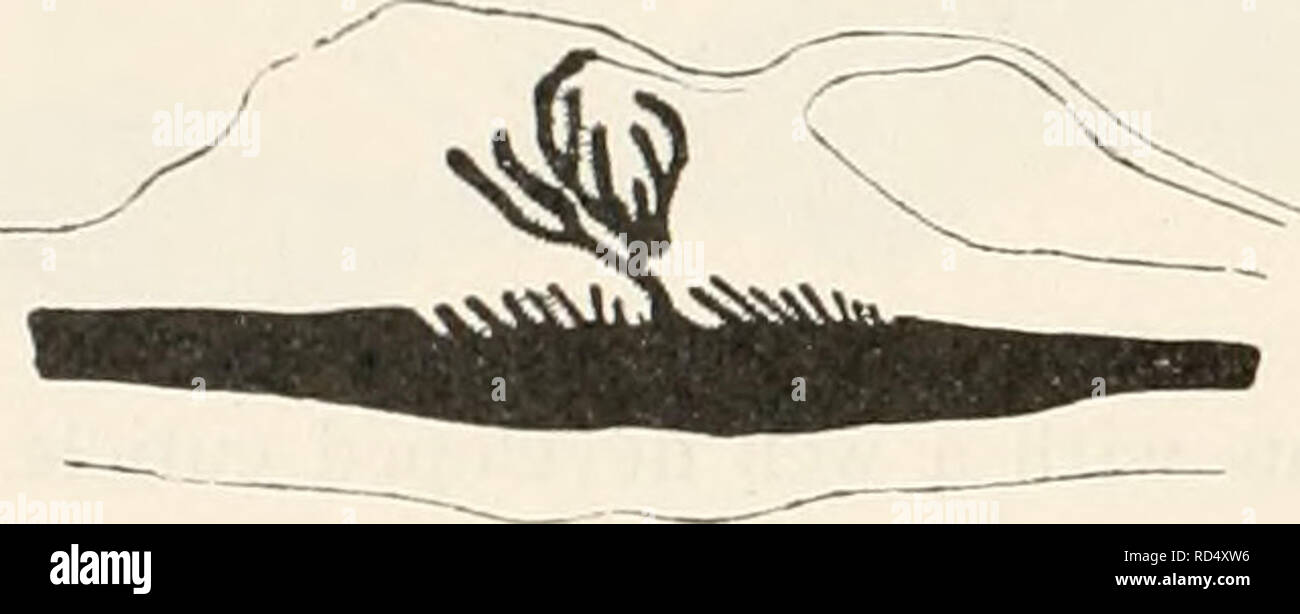 . The Danish Ingolf-Expedition. Scientific expeditions; Arctic Ocean. Fig. 83. The proximal part is rounded and fusing into the middle without distinct outline. No distinct physa is present. The scapus is provided with a sometimes thin, sometimes thick, but translucent, often irregularly wrinkled cuticle, to the outside of which small grains and a great number of detritus-particles are attached. Under low magnifying powers small papilliform elevations are to be seen, which are, however, not regularly arranged, they are as yet only thickenings of the ectoderm as may easily be ascertained on sec Stock Photohttps://www.alamy.com/image-license-details/?v=1https://www.alamy.com/the-danish-ingolf-expedition-scientific-expeditions-arctic-ocean-fig-83-the-proximal-part-is-rounded-and-fusing-into-the-middle-without-distinct-outline-no-distinct-physa-is-present-the-scapus-is-provided-with-a-sometimes-thin-sometimes-thick-but-translucent-often-irregularly-wrinkled-cuticle-to-the-outside-of-which-small-grains-and-a-great-number-of-detritus-particles-are-attached-under-low-magnifying-powers-small-papilliform-elevations-are-to-be-seen-which-are-however-not-regularly-arranged-they-are-as-yet-only-thickenings-of-the-ectoderm-as-may-easily-be-ascertained-on-sec-image231834210.html
. The Danish Ingolf-Expedition. Scientific expeditions; Arctic Ocean. Fig. 83. The proximal part is rounded and fusing into the middle without distinct outline. No distinct physa is present. The scapus is provided with a sometimes thin, sometimes thick, but translucent, often irregularly wrinkled cuticle, to the outside of which small grains and a great number of detritus-particles are attached. Under low magnifying powers small papilliform elevations are to be seen, which are, however, not regularly arranged, they are as yet only thickenings of the ectoderm as may easily be ascertained on sec Stock Photohttps://www.alamy.com/image-license-details/?v=1https://www.alamy.com/the-danish-ingolf-expedition-scientific-expeditions-arctic-ocean-fig-83-the-proximal-part-is-rounded-and-fusing-into-the-middle-without-distinct-outline-no-distinct-physa-is-present-the-scapus-is-provided-with-a-sometimes-thin-sometimes-thick-but-translucent-often-irregularly-wrinkled-cuticle-to-the-outside-of-which-small-grains-and-a-great-number-of-detritus-particles-are-attached-under-low-magnifying-powers-small-papilliform-elevations-are-to-be-seen-which-are-however-not-regularly-arranged-they-are-as-yet-only-thickenings-of-the-ectoderm-as-may-easily-be-ascertained-on-sec-image231834210.htmlRMRD4XW6–. The Danish Ingolf-Expedition. Scientific expeditions; Arctic Ocean. Fig. 83. The proximal part is rounded and fusing into the middle without distinct outline. No distinct physa is present. The scapus is provided with a sometimes thin, sometimes thick, but translucent, often irregularly wrinkled cuticle, to the outside of which small grains and a great number of detritus-particles are attached. Under low magnifying powers small papilliform elevations are to be seen, which are, however, not regularly arranged, they are as yet only thickenings of the ectoderm as may easily be ascertained on sec
 . The natural history of plants. Botany. Fi&. 188. Fruit. Fia. 189. Fruit opened. or absent. The flowers are small and numerous,' in terminal or axillary racemes; these are ramified, consisting of a large number of regularly or irregularly branching cymes,' and CO- Fterocarp^ Draco. vered with sometimes large bracts, and small bractlets, either caducous or fairly persistent. AU the plants which in common with Dalbergia have alternate leaves and a dry fruit, with the seeds attached by the middle of the inner edge, so that they are neither ascending nor descending, have been united, into a s Stock Photohttps://www.alamy.com/image-license-details/?v=1https://www.alamy.com/the-natural-history-of-plants-botany-fiamp-188-fruit-fia-189-fruit-opened-or-absent-the-flowers-are-small-and-numerous-in-terminal-or-axillary-racemes-these-are-ramified-consisting-of-a-large-number-of-regularly-or-irregularly-branching-cymes-and-co-fterocarp-draco-vered-with-sometimes-large-bracts-and-small-bractlets-either-caducous-or-fairly-persistent-au-the-plants-which-in-common-with-dalbergia-have-alternate-leaves-and-a-dry-fruit-with-the-seeds-attached-by-the-middle-of-the-inner-edge-so-that-they-are-neither-ascending-nor-descending-have-been-united-into-a-s-image232086534.html
. The natural history of plants. Botany. Fi&. 188. Fruit. Fia. 189. Fruit opened. or absent. The flowers are small and numerous,' in terminal or axillary racemes; these are ramified, consisting of a large number of regularly or irregularly branching cymes,' and CO- Fterocarp^ Draco. vered with sometimes large bracts, and small bractlets, either caducous or fairly persistent. AU the plants which in common with Dalbergia have alternate leaves and a dry fruit, with the seeds attached by the middle of the inner edge, so that they are neither ascending nor descending, have been united, into a s Stock Photohttps://www.alamy.com/image-license-details/?v=1https://www.alamy.com/the-natural-history-of-plants-botany-fiamp-188-fruit-fia-189-fruit-opened-or-absent-the-flowers-are-small-and-numerous-in-terminal-or-axillary-racemes-these-are-ramified-consisting-of-a-large-number-of-regularly-or-irregularly-branching-cymes-and-co-fterocarp-draco-vered-with-sometimes-large-bracts-and-small-bractlets-either-caducous-or-fairly-persistent-au-the-plants-which-in-common-with-dalbergia-have-alternate-leaves-and-a-dry-fruit-with-the-seeds-attached-by-the-middle-of-the-inner-edge-so-that-they-are-neither-ascending-nor-descending-have-been-united-into-a-s-image232086534.htmlRMRDGCMP–. The natural history of plants. Botany. Fi&. 188. Fruit. Fia. 189. Fruit opened. or absent. The flowers are small and numerous,' in terminal or axillary racemes; these are ramified, consisting of a large number of regularly or irregularly branching cymes,' and CO- Fterocarp^ Draco. vered with sometimes large bracts, and small bractlets, either caducous or fairly persistent. AU the plants which in common with Dalbergia have alternate leaves and a dry fruit, with the seeds attached by the middle of the inner edge, so that they are neither ascending nor descending, have been united, into a s
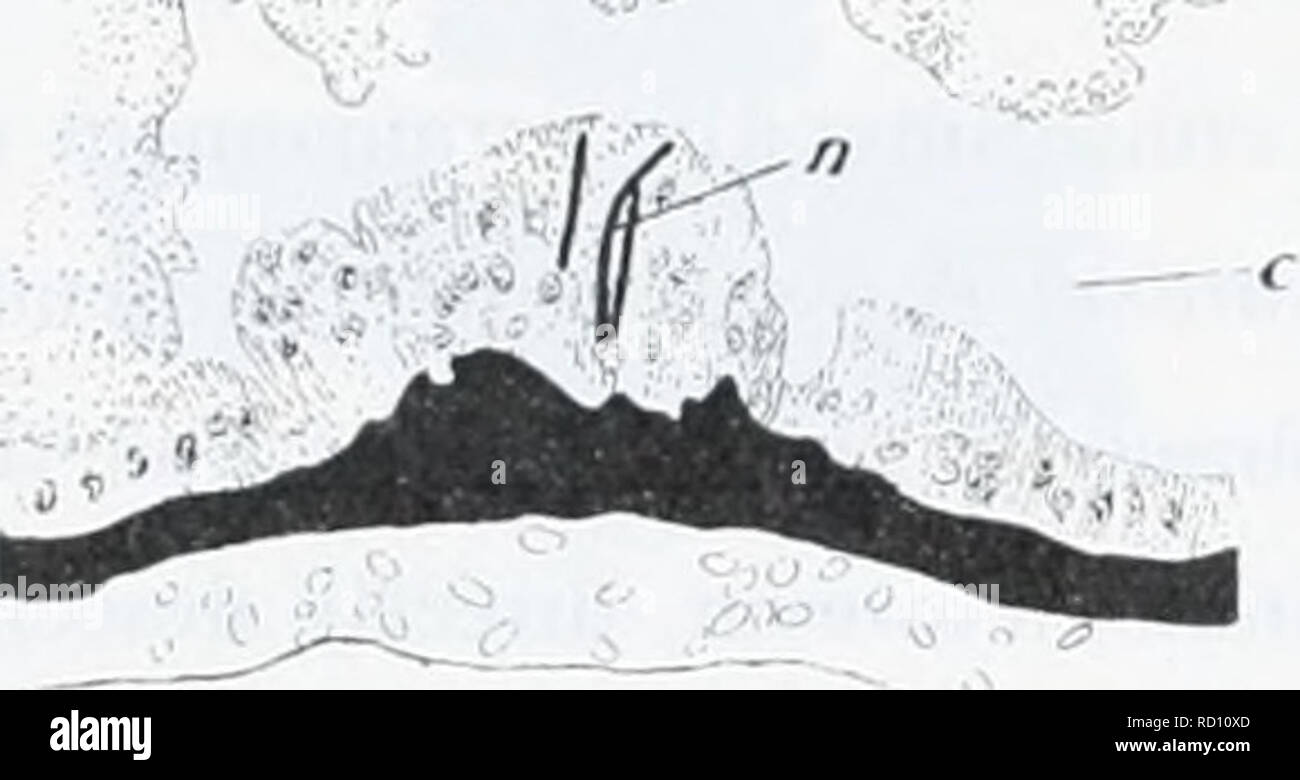 . The Danish Ingolf-expedition. Marine animals -- Arctic regions; Scientific expeditions; Arctic regions. 68 ACTINIARIA The proximal part is rounded and fusing into the middle without distinct outline. No distinct pliysa is present. The scapus is provided with a sometimes thin, sometimes thick, but translucent, often irregularly wrinkled cuticle, to the outside of which small grains and a great number of detritus-particles are attached. Under low magnifying powers small papilliform elevations are to be seen, which are, however, not regularly arranged, thej' are as yet only thickenings of the e Stock Photohttps://www.alamy.com/image-license-details/?v=1https://www.alamy.com/the-danish-ingolf-expedition-marine-animals-arctic-regions-scientific-expeditions-arctic-regions-68-actiniaria-the-proximal-part-is-rounded-and-fusing-into-the-middle-without-distinct-outline-no-distinct-pliysa-is-present-the-scapus-is-provided-with-a-sometimes-thin-sometimes-thick-but-translucent-often-irregularly-wrinkled-cuticle-to-the-outside-of-which-small-grains-and-a-great-number-of-detritus-particles-are-attached-under-low-magnifying-powers-small-papilliform-elevations-are-to-be-seen-which-are-however-not-regularly-arranged-thej-are-as-yet-only-thickenings-of-the-e-image231748005.html
. The Danish Ingolf-expedition. Marine animals -- Arctic regions; Scientific expeditions; Arctic regions. 68 ACTINIARIA The proximal part is rounded and fusing into the middle without distinct outline. No distinct pliysa is present. The scapus is provided with a sometimes thin, sometimes thick, but translucent, often irregularly wrinkled cuticle, to the outside of which small grains and a great number of detritus-particles are attached. Under low magnifying powers small papilliform elevations are to be seen, which are, however, not regularly arranged, thej' are as yet only thickenings of the e Stock Photohttps://www.alamy.com/image-license-details/?v=1https://www.alamy.com/the-danish-ingolf-expedition-marine-animals-arctic-regions-scientific-expeditions-arctic-regions-68-actiniaria-the-proximal-part-is-rounded-and-fusing-into-the-middle-without-distinct-outline-no-distinct-pliysa-is-present-the-scapus-is-provided-with-a-sometimes-thin-sometimes-thick-but-translucent-often-irregularly-wrinkled-cuticle-to-the-outside-of-which-small-grains-and-a-great-number-of-detritus-particles-are-attached-under-low-magnifying-powers-small-papilliform-elevations-are-to-be-seen-which-are-however-not-regularly-arranged-thej-are-as-yet-only-thickenings-of-the-e-image231748005.htmlRMRD10XD–. The Danish Ingolf-expedition. Marine animals -- Arctic regions; Scientific expeditions; Arctic regions. 68 ACTINIARIA The proximal part is rounded and fusing into the middle without distinct outline. No distinct pliysa is present. The scapus is provided with a sometimes thin, sometimes thick, but translucent, often irregularly wrinkled cuticle, to the outside of which small grains and a great number of detritus-particles are attached. Under low magnifying powers small papilliform elevations are to be seen, which are, however, not regularly arranged, thej' are as yet only thickenings of the e
 . Animal life as affected by the natural conditions of existence. Animal ecology. Fig. 88.—Rhizcchilus antipathum, Steenstrup. To the right the young shell exactly resembling Buccinum ; to the left the old shell firmly attached to the branches of Anli- pathet by its irregularly formed margin- it. The shell throws out processes in every direction, by which it clings to the coral, in the mode here shown in a woodcut copied from Steenstrup, till at last the mollusc loses all power of motion and lies, anchored as it were, to the Anti- pathes. Of what use this can be to the animal it is difficult t Stock Photohttps://www.alamy.com/image-license-details/?v=1https://www.alamy.com/animal-life-as-affected-by-the-natural-conditions-of-existence-animal-ecology-fig-88rhizcchilus-antipathum-steenstrup-to-the-right-the-young-shell-exactly-resembling-buccinum-to-the-left-the-old-shell-firmly-attached-to-the-branches-of-anli-pathet-by-its-irregularly-formed-margin-it-the-shell-throws-out-processes-in-every-direction-by-which-it-clings-to-the-coral-in-the-mode-here-shown-in-a-woodcut-copied-from-steenstrup-till-at-last-the-mollusc-loses-all-power-of-motion-and-lies-anchored-as-it-were-to-the-anti-pathes-of-what-use-this-can-be-to-the-animal-it-is-difficult-t-image236751795.html
. Animal life as affected by the natural conditions of existence. Animal ecology. Fig. 88.—Rhizcchilus antipathum, Steenstrup. To the right the young shell exactly resembling Buccinum ; to the left the old shell firmly attached to the branches of Anli- pathet by its irregularly formed margin- it. The shell throws out processes in every direction, by which it clings to the coral, in the mode here shown in a woodcut copied from Steenstrup, till at last the mollusc loses all power of motion and lies, anchored as it were, to the Anti- pathes. Of what use this can be to the animal it is difficult t Stock Photohttps://www.alamy.com/image-license-details/?v=1https://www.alamy.com/animal-life-as-affected-by-the-natural-conditions-of-existence-animal-ecology-fig-88rhizcchilus-antipathum-steenstrup-to-the-right-the-young-shell-exactly-resembling-buccinum-to-the-left-the-old-shell-firmly-attached-to-the-branches-of-anli-pathet-by-its-irregularly-formed-margin-it-the-shell-throws-out-processes-in-every-direction-by-which-it-clings-to-the-coral-in-the-mode-here-shown-in-a-woodcut-copied-from-steenstrup-till-at-last-the-mollusc-loses-all-power-of-motion-and-lies-anchored-as-it-were-to-the-anti-pathes-of-what-use-this-can-be-to-the-animal-it-is-difficult-t-image236751795.htmlRMRN4Y97–. Animal life as affected by the natural conditions of existence. Animal ecology. Fig. 88.—Rhizcchilus antipathum, Steenstrup. To the right the young shell exactly resembling Buccinum ; to the left the old shell firmly attached to the branches of Anli- pathet by its irregularly formed margin- it. The shell throws out processes in every direction, by which it clings to the coral, in the mode here shown in a woodcut copied from Steenstrup, till at last the mollusc loses all power of motion and lies, anchored as it were, to the Anti- pathes. Of what use this can be to the animal it is difficult t
 . A history of British ferns. Ferns. ASPLENIUM ADIANTUM-NIGEUM. 227 ones often pinnate or pinnatifid, with the lobes notched; the apices of the ultimate divisions are serrated. The lateral veins in the pinnules or lobes, as the case may be, are irregularly- alternate, and are generally forked after leaving the midveia ; and one or both branches of this divided vein bears on the side a line of capsules : these are at first covered by a white, linear, narrow, scale-like involucre, also attached to the side of the veins : the clusters of capsules, together with their involucres, are situated rath Stock Photohttps://www.alamy.com/image-license-details/?v=1https://www.alamy.com/a-history-of-british-ferns-ferns-asplenium-adiantum-nigeum-227-ones-often-pinnate-or-pinnatifid-with-the-lobes-notched-the-apices-of-the-ultimate-divisions-are-serrated-the-lateral-veins-in-the-pinnules-or-lobes-as-the-case-may-be-are-irregularly-alternate-and-are-generally-forked-after-leaving-the-midveia-and-one-or-both-branches-of-this-divided-vein-bears-on-the-side-a-line-of-capsules-these-are-at-first-covered-by-a-white-linear-narrow-scale-like-involucre-also-attached-to-the-side-of-the-veins-the-clusters-of-capsules-together-with-their-involucres-are-situated-rath-image232375555.html
. A history of British ferns. Ferns. ASPLENIUM ADIANTUM-NIGEUM. 227 ones often pinnate or pinnatifid, with the lobes notched; the apices of the ultimate divisions are serrated. The lateral veins in the pinnules or lobes, as the case may be, are irregularly- alternate, and are generally forked after leaving the midveia ; and one or both branches of this divided vein bears on the side a line of capsules : these are at first covered by a white, linear, narrow, scale-like involucre, also attached to the side of the veins : the clusters of capsules, together with their involucres, are situated rath Stock Photohttps://www.alamy.com/image-license-details/?v=1https://www.alamy.com/a-history-of-british-ferns-ferns-asplenium-adiantum-nigeum-227-ones-often-pinnate-or-pinnatifid-with-the-lobes-notched-the-apices-of-the-ultimate-divisions-are-serrated-the-lateral-veins-in-the-pinnules-or-lobes-as-the-case-may-be-are-irregularly-alternate-and-are-generally-forked-after-leaving-the-midveia-and-one-or-both-branches-of-this-divided-vein-bears-on-the-side-a-line-of-capsules-these-are-at-first-covered-by-a-white-linear-narrow-scale-like-involucre-also-attached-to-the-side-of-the-veins-the-clusters-of-capsules-together-with-their-involucres-are-situated-rath-image232375555.htmlRMRE1HAY–. A history of British ferns. Ferns. ASPLENIUM ADIANTUM-NIGEUM. 227 ones often pinnate or pinnatifid, with the lobes notched; the apices of the ultimate divisions are serrated. The lateral veins in the pinnules or lobes, as the case may be, are irregularly- alternate, and are generally forked after leaving the midveia ; and one or both branches of this divided vein bears on the side a line of capsules : these are at first covered by a white, linear, narrow, scale-like involucre, also attached to the side of the veins : the clusters of capsules, together with their involucres, are situated rath
 . Anatomy of the cat. Cats; Mammals. 46 THE SKELETON OF THE CAT. The perpendicular or nasal portion (Fig. 33, b) of the palatine is thin and irregularly quadrilateral in form. It is attached by its cranial two-thirds to the dorsal surface of the horizontal portion. The outer surface is concave and looks into the orbital fossa. The inner surface is convex and looks into the nasal cavity. The perpendicular portion is marked by two formaina just craniad of the middle. The larger dorsal oval foramen is the sphenopalatine foramen {e). The smaller ventral foramen is the caudal opening of the posteri Stock Photohttps://www.alamy.com/image-license-details/?v=1https://www.alamy.com/anatomy-of-the-cat-cats-mammals-46-the-skeleton-of-the-cat-the-perpendicular-or-nasal-portion-fig-33-b-of-the-palatine-is-thin-and-irregularly-quadrilateral-in-form-it-is-attached-by-its-cranial-two-thirds-to-the-dorsal-surface-of-the-horizontal-portion-the-outer-surface-is-concave-and-looks-into-the-orbital-fossa-the-inner-surface-is-convex-and-looks-into-the-nasal-cavity-the-perpendicular-portion-is-marked-by-two-formaina-just-craniad-of-the-middle-the-larger-dorsal-oval-foramen-is-the-sphenopalatine-foramen-e-the-smaller-ventral-foramen-is-the-caudal-opening-of-the-posteri-image236819372.html
. Anatomy of the cat. Cats; Mammals. 46 THE SKELETON OF THE CAT. The perpendicular or nasal portion (Fig. 33, b) of the palatine is thin and irregularly quadrilateral in form. It is attached by its cranial two-thirds to the dorsal surface of the horizontal portion. The outer surface is concave and looks into the orbital fossa. The inner surface is convex and looks into the nasal cavity. The perpendicular portion is marked by two formaina just craniad of the middle. The larger dorsal oval foramen is the sphenopalatine foramen {e). The smaller ventral foramen is the caudal opening of the posteri Stock Photohttps://www.alamy.com/image-license-details/?v=1https://www.alamy.com/anatomy-of-the-cat-cats-mammals-46-the-skeleton-of-the-cat-the-perpendicular-or-nasal-portion-fig-33-b-of-the-palatine-is-thin-and-irregularly-quadrilateral-in-form-it-is-attached-by-its-cranial-two-thirds-to-the-dorsal-surface-of-the-horizontal-portion-the-outer-surface-is-concave-and-looks-into-the-orbital-fossa-the-inner-surface-is-convex-and-looks-into-the-nasal-cavity-the-perpendicular-portion-is-marked-by-two-formaina-just-craniad-of-the-middle-the-larger-dorsal-oval-foramen-is-the-sphenopalatine-foramen-e-the-smaller-ventral-foramen-is-the-caudal-opening-of-the-posteri-image236819372.htmlRMRN81EM–. Anatomy of the cat. Cats; Mammals. 46 THE SKELETON OF THE CAT. The perpendicular or nasal portion (Fig. 33, b) of the palatine is thin and irregularly quadrilateral in form. It is attached by its cranial two-thirds to the dorsal surface of the horizontal portion. The outer surface is concave and looks into the orbital fossa. The inner surface is convex and looks into the nasal cavity. The perpendicular portion is marked by two formaina just craniad of the middle. The larger dorsal oval foramen is the sphenopalatine foramen {e). The smaller ventral foramen is the caudal opening of the posteri
 . The cell in development and inheritance. Cells. 72 CELL-DI VISION facts in its support, though neither his observations nor those of later investigators have sustained Van Beneden's account of the grouping of the astral rays. Boveri showed in the clearest manner that, during the fertilization of Ascaris, the astral rays become attached to the chromosomes of the germ-nuclei; that each comes into connection with rays from both the asters; that the chromosomes, at first irregularly scattered in the Q,g^, are drawn into a position of equilibrium in the equator of the spindle by the shortening of Stock Photohttps://www.alamy.com/image-license-details/?v=1https://www.alamy.com/the-cell-in-development-and-inheritance-cells-72-cell-di-vision-facts-in-its-support-though-neither-his-observations-nor-those-of-later-investigators-have-sustained-van-benedens-account-of-the-grouping-of-the-astral-rays-boveri-showed-in-the-clearest-manner-that-during-the-fertilization-of-ascaris-the-astral-rays-become-attached-to-the-chromosomes-of-the-germ-nuclei-that-each-comes-into-connection-with-rays-from-both-the-asters-that-the-chromosomes-at-first-irregularly-scattered-in-the-qg-are-drawn-into-a-position-of-equilibrium-in-the-equator-of-the-spindle-by-the-shortening-of-image235082099.html
. The cell in development and inheritance. Cells. 72 CELL-DI VISION facts in its support, though neither his observations nor those of later investigators have sustained Van Beneden's account of the grouping of the astral rays. Boveri showed in the clearest manner that, during the fertilization of Ascaris, the astral rays become attached to the chromosomes of the germ-nuclei; that each comes into connection with rays from both the asters; that the chromosomes, at first irregularly scattered in the Q,g^, are drawn into a position of equilibrium in the equator of the spindle by the shortening of Stock Photohttps://www.alamy.com/image-license-details/?v=1https://www.alamy.com/the-cell-in-development-and-inheritance-cells-72-cell-di-vision-facts-in-its-support-though-neither-his-observations-nor-those-of-later-investigators-have-sustained-van-benedens-account-of-the-grouping-of-the-astral-rays-boveri-showed-in-the-clearest-manner-that-during-the-fertilization-of-ascaris-the-astral-rays-become-attached-to-the-chromosomes-of-the-germ-nuclei-that-each-comes-into-connection-with-rays-from-both-the-asters-that-the-chromosomes-at-first-irregularly-scattered-in-the-qg-are-drawn-into-a-position-of-equilibrium-in-the-equator-of-the-spindle-by-the-shortening-of-image235082099.htmlRMRJCWH7–. The cell in development and inheritance. Cells. 72 CELL-DI VISION facts in its support, though neither his observations nor those of later investigators have sustained Van Beneden's account of the grouping of the astral rays. Boveri showed in the clearest manner that, during the fertilization of Ascaris, the astral rays become attached to the chromosomes of the germ-nuclei; that each comes into connection with rays from both the asters; that the chromosomes, at first irregularly scattered in the Q,g^, are drawn into a position of equilibrium in the equator of the spindle by the shortening of
 . The Biological bulletin. Biology; Zoology; Biology; Marine Biology. FOOD, GROWTH AND STRUCTURE IN AMOEBA 395 pseudopods and these were very short, thick, and blunt without a hy- aline cap. They were only slightly attached to the substratum and moved about very slowly and irregularly, now in one direction, then in another, giving the impression of very sluggish, aimless, rolling about. Many had two nuclei. The alpha and beta granules were normal in number and structure, but the bipyramidal crystals were scarce and much. FIG. 2. Camera outlines showing the size, form, and structure of Amoeba p Stock Photohttps://www.alamy.com/image-license-details/?v=1https://www.alamy.com/the-biological-bulletin-biology-zoology-biology-marine-biology-food-growth-and-structure-in-amoeba-395-pseudopods-and-these-were-very-short-thick-and-blunt-without-a-hy-aline-cap-they-were-only-slightly-attached-to-the-substratum-and-moved-about-very-slowly-and-irregularly-now-in-one-direction-then-in-another-giving-the-impression-of-very-sluggish-aimless-rolling-about-many-had-two-nuclei-the-alpha-and-beta-granules-were-normal-in-number-and-structure-but-the-bipyramidal-crystals-were-scarce-and-much-fig-2-camera-outlines-showing-the-size-form-and-structure-of-amoeba-p-image234641397.html
. The Biological bulletin. Biology; Zoology; Biology; Marine Biology. FOOD, GROWTH AND STRUCTURE IN AMOEBA 395 pseudopods and these were very short, thick, and blunt without a hy- aline cap. They were only slightly attached to the substratum and moved about very slowly and irregularly, now in one direction, then in another, giving the impression of very sluggish, aimless, rolling about. Many had two nuclei. The alpha and beta granules were normal in number and structure, but the bipyramidal crystals were scarce and much. FIG. 2. Camera outlines showing the size, form, and structure of Amoeba p Stock Photohttps://www.alamy.com/image-license-details/?v=1https://www.alamy.com/the-biological-bulletin-biology-zoology-biology-marine-biology-food-growth-and-structure-in-amoeba-395-pseudopods-and-these-were-very-short-thick-and-blunt-without-a-hy-aline-cap-they-were-only-slightly-attached-to-the-substratum-and-moved-about-very-slowly-and-irregularly-now-in-one-direction-then-in-another-giving-the-impression-of-very-sluggish-aimless-rolling-about-many-had-two-nuclei-the-alpha-and-beta-granules-were-normal-in-number-and-structure-but-the-bipyramidal-crystals-were-scarce-and-much-fig-2-camera-outlines-showing-the-size-form-and-structure-of-amoeba-p-image234641397.htmlRMRHMRDW–. The Biological bulletin. Biology; Zoology; Biology; Marine Biology. FOOD, GROWTH AND STRUCTURE IN AMOEBA 395 pseudopods and these were very short, thick, and blunt without a hy- aline cap. They were only slightly attached to the substratum and moved about very slowly and irregularly, now in one direction, then in another, giving the impression of very sluggish, aimless, rolling about. Many had two nuclei. The alpha and beta granules were normal in number and structure, but the bipyramidal crystals were scarce and much. FIG. 2. Camera outlines showing the size, form, and structure of Amoeba p
 . The Biological bulletin. Biology; Zoology; Biology; Marine Biology. PHYLLODISTOMUM SOLIDUM RANKIN, 1937 73 staining technique was not used. The host does not aid in the formation of the cyst wall, but host cellular elements do adhere irregularly to the outer cyst membrane. The cercarial stylet which is discarded into the cavity of the metacercarial cyst during the first 24 hours, is at first free-floating in the internal liquid; later it attached to the internal surface of the cyst and is finally embedded between primary and secondary cystogenous deposits. The growth of the metacercaria is r Stock Photohttps://www.alamy.com/image-license-details/?v=1https://www.alamy.com/the-biological-bulletin-biology-zoology-biology-marine-biology-phyllodistomum-solidum-rankin-1937-73-staining-technique-was-not-used-the-host-does-not-aid-in-the-formation-of-the-cyst-wall-but-host-cellular-elements-do-adhere-irregularly-to-the-outer-cyst-membrane-the-cercarial-stylet-which-is-discarded-into-the-cavity-of-the-metacercarial-cyst-during-the-first-24-hours-is-at-first-free-floating-in-the-internal-liquid-later-it-attached-to-the-internal-surface-of-the-cyst-and-is-finally-embedded-between-primary-and-secondary-cystogenous-deposits-the-growth-of-the-metacercaria-is-r-image234669639.html
. The Biological bulletin. Biology; Zoology; Biology; Marine Biology. PHYLLODISTOMUM SOLIDUM RANKIN, 1937 73 staining technique was not used. The host does not aid in the formation of the cyst wall, but host cellular elements do adhere irregularly to the outer cyst membrane. The cercarial stylet which is discarded into the cavity of the metacercarial cyst during the first 24 hours, is at first free-floating in the internal liquid; later it attached to the internal surface of the cyst and is finally embedded between primary and secondary cystogenous deposits. The growth of the metacercaria is r Stock Photohttps://www.alamy.com/image-license-details/?v=1https://www.alamy.com/the-biological-bulletin-biology-zoology-biology-marine-biology-phyllodistomum-solidum-rankin-1937-73-staining-technique-was-not-used-the-host-does-not-aid-in-the-formation-of-the-cyst-wall-but-host-cellular-elements-do-adhere-irregularly-to-the-outer-cyst-membrane-the-cercarial-stylet-which-is-discarded-into-the-cavity-of-the-metacercarial-cyst-during-the-first-24-hours-is-at-first-free-floating-in-the-internal-liquid-later-it-attached-to-the-internal-surface-of-the-cyst-and-is-finally-embedded-between-primary-and-secondary-cystogenous-deposits-the-growth-of-the-metacercaria-is-r-image234669639.htmlRMRHP3EF–. The Biological bulletin. Biology; Zoology; Biology; Marine Biology. PHYLLODISTOMUM SOLIDUM RANKIN, 1937 73 staining technique was not used. The host does not aid in the formation of the cyst wall, but host cellular elements do adhere irregularly to the outer cyst membrane. The cercarial stylet which is discarded into the cavity of the metacercarial cyst during the first 24 hours, is at first free-floating in the internal liquid; later it attached to the internal surface of the cyst and is finally embedded between primary and secondary cystogenous deposits. The growth of the metacercaria is r
 . The essentials of botany. Botany. 174 PHYLUM II. CHLOROPHYCEAE. Fio. 68. Oedogonium, producing 4-ciliate zoospores, or 2-ciliate gametes. The irregularly tubular Enteromorphas resemble the Sea Lettuces and are common in brackish ponds. 245. In the Oedogoniums (Oedogoniaceae) the plants are attached below, and are simple or branched above. They propagate by means of multiciliated zoospores which are formed singly in the cells, and generate by hetero- gametes, consisting of small multiciliated sperms, and large non-ciliated eggs. The sperms are formed (1) in certain cells in the filament which Stock Photohttps://www.alamy.com/image-license-details/?v=1https://www.alamy.com/the-essentials-of-botany-botany-174-phylum-ii-chlorophyceae-fio-68-oedogonium-producing-4-ciliate-zoospores-or-2-ciliate-gametes-the-irregularly-tubular-enteromorphas-resemble-the-sea-lettuces-and-are-common-in-brackish-ponds-245-in-the-oedogoniums-oedogoniaceae-the-plants-are-attached-below-and-are-simple-or-branched-above-they-propagate-by-means-of-multiciliated-zoospores-which-are-formed-singly-in-the-cells-and-generate-by-hetero-gametes-consisting-of-small-multiciliated-sperms-and-large-non-ciliated-eggs-the-sperms-are-formed-1-in-certain-cells-in-the-filament-which-image232283713.html
. The essentials of botany. Botany. 174 PHYLUM II. CHLOROPHYCEAE. Fio. 68. Oedogonium, producing 4-ciliate zoospores, or 2-ciliate gametes. The irregularly tubular Enteromorphas resemble the Sea Lettuces and are common in brackish ponds. 245. In the Oedogoniums (Oedogoniaceae) the plants are attached below, and are simple or branched above. They propagate by means of multiciliated zoospores which are formed singly in the cells, and generate by hetero- gametes, consisting of small multiciliated sperms, and large non-ciliated eggs. The sperms are formed (1) in certain cells in the filament which Stock Photohttps://www.alamy.com/image-license-details/?v=1https://www.alamy.com/the-essentials-of-botany-botany-174-phylum-ii-chlorophyceae-fio-68-oedogonium-producing-4-ciliate-zoospores-or-2-ciliate-gametes-the-irregularly-tubular-enteromorphas-resemble-the-sea-lettuces-and-are-common-in-brackish-ponds-245-in-the-oedogoniums-oedogoniaceae-the-plants-are-attached-below-and-are-simple-or-branched-above-they-propagate-by-means-of-multiciliated-zoospores-which-are-formed-singly-in-the-cells-and-generate-by-hetero-gametes-consisting-of-small-multiciliated-sperms-and-large-non-ciliated-eggs-the-sperms-are-formed-1-in-certain-cells-in-the-filament-which-image232283713.htmlRMRDWC6W–. The essentials of botany. Botany. 174 PHYLUM II. CHLOROPHYCEAE. Fio. 68. Oedogonium, producing 4-ciliate zoospores, or 2-ciliate gametes. The irregularly tubular Enteromorphas resemble the Sea Lettuces and are common in brackish ponds. 245. In the Oedogoniums (Oedogoniaceae) the plants are attached below, and are simple or branched above. They propagate by means of multiciliated zoospores which are formed singly in the cells, and generate by hetero- gametes, consisting of small multiciliated sperms, and large non-ciliated eggs. The sperms are formed (1) in certain cells in the filament which
 . The Biological bulletin. Biology; Zoology; Biology; Marine Biology. 282 E. A. ANDREWS. tached by the posterior end and feel about like a leech and later swim off in a short arc to settle again. When carmine grains were added to the water it was evident that the animal was attached by the posterior end to an invisible film or raft of secretion that formed a pellicle over the surface of the water and extended out irregularly in all directions to a distance of one to four times the length of the Folliculina. These thin pellicles that moved on the water with the contract- tions of the Folliculin Stock Photohttps://www.alamy.com/image-license-details/?v=1https://www.alamy.com/the-biological-bulletin-biology-zoology-biology-marine-biology-282-e-a-andrews-tached-by-the-posterior-end-and-feel-about-like-a-leech-and-later-swim-off-in-a-short-arc-to-settle-again-when-carmine-grains-were-added-to-the-water-it-was-evident-that-the-animal-was-attached-by-the-posterior-end-to-an-invisible-film-or-raft-of-secretion-that-formed-a-pellicle-over-the-surface-of-the-water-and-extended-out-irregularly-in-all-directions-to-a-distance-of-one-to-four-times-the-length-of-the-folliculina-these-thin-pellicles-that-moved-on-the-water-with-the-contract-tions-of-the-folliculin-image234695274.html
. The Biological bulletin. Biology; Zoology; Biology; Marine Biology. 282 E. A. ANDREWS. tached by the posterior end and feel about like a leech and later swim off in a short arc to settle again. When carmine grains were added to the water it was evident that the animal was attached by the posterior end to an invisible film or raft of secretion that formed a pellicle over the surface of the water and extended out irregularly in all directions to a distance of one to four times the length of the Folliculina. These thin pellicles that moved on the water with the contract- tions of the Folliculin Stock Photohttps://www.alamy.com/image-license-details/?v=1https://www.alamy.com/the-biological-bulletin-biology-zoology-biology-marine-biology-282-e-a-andrews-tached-by-the-posterior-end-and-feel-about-like-a-leech-and-later-swim-off-in-a-short-arc-to-settle-again-when-carmine-grains-were-added-to-the-water-it-was-evident-that-the-animal-was-attached-by-the-posterior-end-to-an-invisible-film-or-raft-of-secretion-that-formed-a-pellicle-over-the-surface-of-the-water-and-extended-out-irregularly-in-all-directions-to-a-distance-of-one-to-four-times-the-length-of-the-folliculina-these-thin-pellicles-that-moved-on-the-water-with-the-contract-tions-of-the-folliculin-image234695274.htmlRMRHR862–. The Biological bulletin. Biology; Zoology; Biology; Marine Biology. 282 E. A. ANDREWS. tached by the posterior end and feel about like a leech and later swim off in a short arc to settle again. When carmine grains were added to the water it was evident that the animal was attached by the posterior end to an invisible film or raft of secretion that formed a pellicle over the surface of the water and extended out irregularly in all directions to a distance of one to four times the length of the Folliculina. These thin pellicles that moved on the water with the contract- tions of the Folliculin
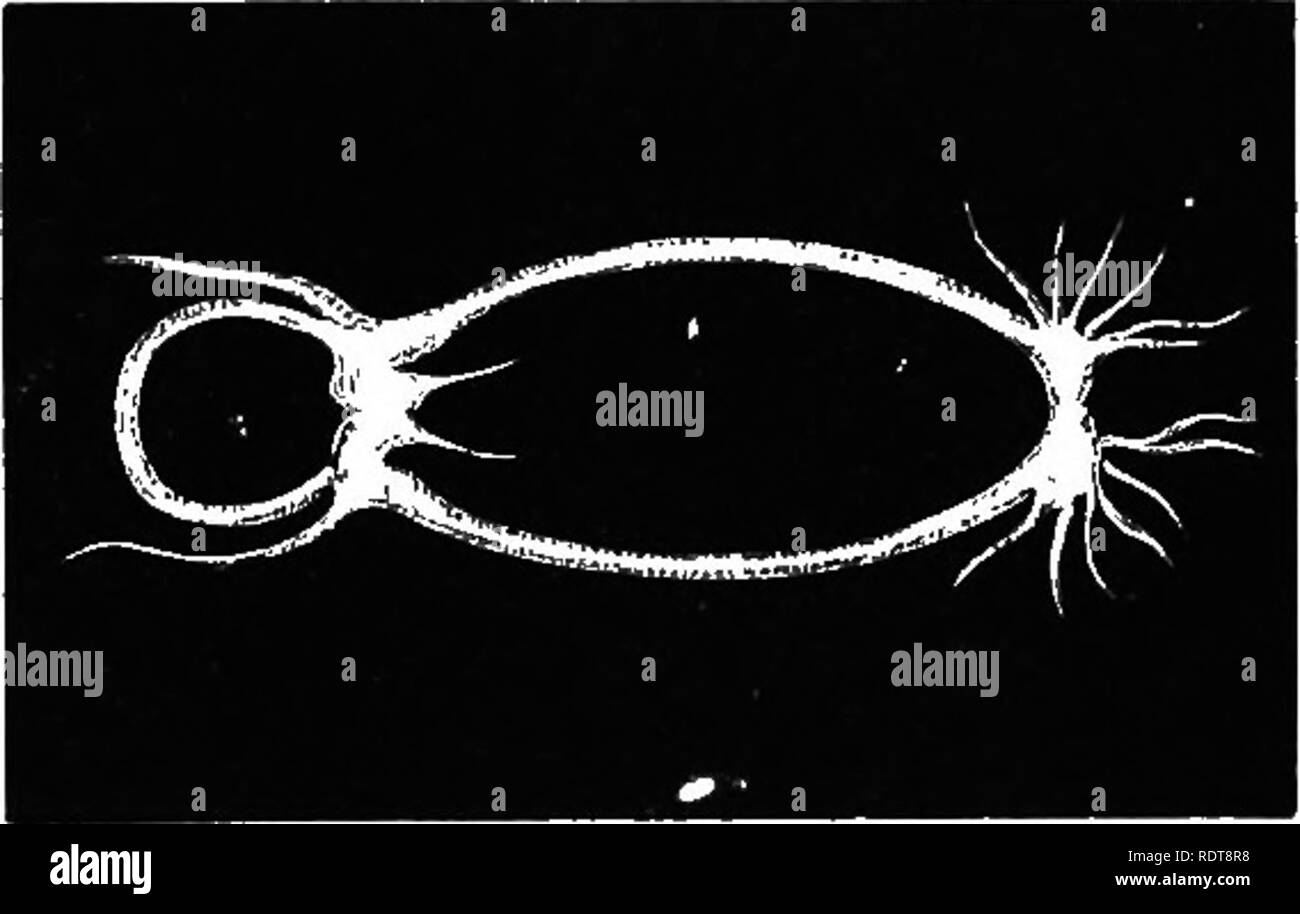 . Fourteen weeks in zoology. Zoology. III. SUBKINGDOM MOLLUSCA. General Characteristics. — The MoUuscans (soft- bodied) have yielding tissues ot great contractile power, inclosed in a soft flexible skin called the mantle. ^^' ''^' The nervous ganglia are placed irregularly, but all communicate with a larger mass forming around the throat a ring, which may be considered the brain. Except in one class, the muscles are attached to the skin, which is usually pro- tected by a shell consisting principally of carbonate of lime, which in turn is defended by an epidermis of animal matter, to prevent co Stock Photohttps://www.alamy.com/image-license-details/?v=1https://www.alamy.com/fourteen-weeks-in-zoology-zoology-iii-subkingdom-mollusca-general-characteristics-the-mouuscans-soft-bodied-have-yielding-tissues-ot-great-contractile-power-inclosed-in-a-soft-flexible-skin-called-the-mantle-the-nervous-ganglia-are-placed-irregularly-but-all-communicate-with-a-larger-mass-forming-around-the-throat-a-ring-which-may-be-considered-the-brain-except-in-one-class-the-muscles-are-attached-to-the-skin-which-is-usually-pro-tected-by-a-shell-consisting-principally-of-carbonate-of-lime-which-in-turn-is-defended-by-an-epidermis-of-animal-matter-to-prevent-co-image232259084.html
. Fourteen weeks in zoology. Zoology. III. SUBKINGDOM MOLLUSCA. General Characteristics. — The MoUuscans (soft- bodied) have yielding tissues ot great contractile power, inclosed in a soft flexible skin called the mantle. ^^' ''^' The nervous ganglia are placed irregularly, but all communicate with a larger mass forming around the throat a ring, which may be considered the brain. Except in one class, the muscles are attached to the skin, which is usually pro- tected by a shell consisting principally of carbonate of lime, which in turn is defended by an epidermis of animal matter, to prevent co Stock Photohttps://www.alamy.com/image-license-details/?v=1https://www.alamy.com/fourteen-weeks-in-zoology-zoology-iii-subkingdom-mollusca-general-characteristics-the-mouuscans-soft-bodied-have-yielding-tissues-ot-great-contractile-power-inclosed-in-a-soft-flexible-skin-called-the-mantle-the-nervous-ganglia-are-placed-irregularly-but-all-communicate-with-a-larger-mass-forming-around-the-throat-a-ring-which-may-be-considered-the-brain-except-in-one-class-the-muscles-are-attached-to-the-skin-which-is-usually-pro-tected-by-a-shell-consisting-principally-of-carbonate-of-lime-which-in-turn-is-defended-by-an-epidermis-of-animal-matter-to-prevent-co-image232259084.htmlRMRDT8R8–. Fourteen weeks in zoology. Zoology. III. SUBKINGDOM MOLLUSCA. General Characteristics. — The MoUuscans (soft- bodied) have yielding tissues ot great contractile power, inclosed in a soft flexible skin called the mantle. ^^' ''^' The nervous ganglia are placed irregularly, but all communicate with a larger mass forming around the throat a ring, which may be considered the brain. Except in one class, the muscles are attached to the skin, which is usually pro- tected by a shell consisting principally of carbonate of lime, which in turn is defended by an epidermis of animal matter, to prevent co
![. Fungi, ascomycetes, ustilaginales, uredinales. Fungi. IV] PEZIZALES III attached antheridium if the latter developed at a distance. But branching might also be regarded as a secondary or vegetative development, appearing after normal fertilization had ceased to occur. The presence of pores in the transverse septa of the trichbgyne suggests that the function of that organ in relation to an antheridium has only recently been lost.. Fig. 67. Jlumai-ia^ranu/ata Qne.; YOvmga.rchica.rp, X3'2o; after Blackman and Fraser. The ascogenous hyphae contain many nuclei irregularly arranged. Asci are form Stock Photo . Fungi, ascomycetes, ustilaginales, uredinales. Fungi. IV] PEZIZALES III attached antheridium if the latter developed at a distance. But branching might also be regarded as a secondary or vegetative development, appearing after normal fertilization had ceased to occur. The presence of pores in the transverse septa of the trichbgyne suggests that the function of that organ in relation to an antheridium has only recently been lost.. Fig. 67. Jlumai-ia^ranu/ata Qne.; YOvmga.rchica.rp, X3'2o; after Blackman and Fraser. The ascogenous hyphae contain many nuclei irregularly arranged. Asci are form Stock Photo](https://c8.alamy.com/comp/RDTP02/fungi-ascomycetes-ustilaginales-uredinales-fungi-iv-pezizales-iii-attached-antheridium-if-the-latter-developed-at-a-distance-but-branching-might-also-be-regarded-as-a-secondary-or-vegetative-development-appearing-after-normal-fertilization-had-ceased-to-occur-the-presence-of-pores-in-the-transverse-septa-of-the-trichbgyne-suggests-that-the-function-of-that-organ-in-relation-to-an-antheridium-has-only-recently-been-lost-fig-67-jlumai-iaranuata-qne-yovmgarchicarp-x32o-after-blackman-and-fraser-the-ascogenous-hyphae-contain-many-nuclei-irregularly-arranged-asci-are-form-RDTP02.jpg) . Fungi, ascomycetes, ustilaginales, uredinales. Fungi. IV] PEZIZALES III attached antheridium if the latter developed at a distance. But branching might also be regarded as a secondary or vegetative development, appearing after normal fertilization had ceased to occur. The presence of pores in the transverse septa of the trichbgyne suggests that the function of that organ in relation to an antheridium has only recently been lost.. Fig. 67. Jlumai-ia^ranu/ata Qne.; YOvmga.rchica.rp, X3'2o; after Blackman and Fraser. The ascogenous hyphae contain many nuclei irregularly arranged. Asci are form Stock Photohttps://www.alamy.com/image-license-details/?v=1https://www.alamy.com/fungi-ascomycetes-ustilaginales-uredinales-fungi-iv-pezizales-iii-attached-antheridium-if-the-latter-developed-at-a-distance-but-branching-might-also-be-regarded-as-a-secondary-or-vegetative-development-appearing-after-normal-fertilization-had-ceased-to-occur-the-presence-of-pores-in-the-transverse-septa-of-the-trichbgyne-suggests-that-the-function-of-that-organ-in-relation-to-an-antheridium-has-only-recently-been-lost-fig-67-jlumai-iaranuata-qne-yovmgarchicarp-x32o-after-blackman-and-fraser-the-ascogenous-hyphae-contain-many-nuclei-irregularly-arranged-asci-are-form-image232269410.html
. Fungi, ascomycetes, ustilaginales, uredinales. Fungi. IV] PEZIZALES III attached antheridium if the latter developed at a distance. But branching might also be regarded as a secondary or vegetative development, appearing after normal fertilization had ceased to occur. The presence of pores in the transverse septa of the trichbgyne suggests that the function of that organ in relation to an antheridium has only recently been lost.. Fig. 67. Jlumai-ia^ranu/ata Qne.; YOvmga.rchica.rp, X3'2o; after Blackman and Fraser. The ascogenous hyphae contain many nuclei irregularly arranged. Asci are form Stock Photohttps://www.alamy.com/image-license-details/?v=1https://www.alamy.com/fungi-ascomycetes-ustilaginales-uredinales-fungi-iv-pezizales-iii-attached-antheridium-if-the-latter-developed-at-a-distance-but-branching-might-also-be-regarded-as-a-secondary-or-vegetative-development-appearing-after-normal-fertilization-had-ceased-to-occur-the-presence-of-pores-in-the-transverse-septa-of-the-trichbgyne-suggests-that-the-function-of-that-organ-in-relation-to-an-antheridium-has-only-recently-been-lost-fig-67-jlumai-iaranuata-qne-yovmgarchicarp-x32o-after-blackman-and-fraser-the-ascogenous-hyphae-contain-many-nuclei-irregularly-arranged-asci-are-form-image232269410.htmlRMRDTP02–. Fungi, ascomycetes, ustilaginales, uredinales. Fungi. IV] PEZIZALES III attached antheridium if the latter developed at a distance. But branching might also be regarded as a secondary or vegetative development, appearing after normal fertilization had ceased to occur. The presence of pores in the transverse septa of the trichbgyne suggests that the function of that organ in relation to an antheridium has only recently been lost.. Fig. 67. Jlumai-ia^ranu/ata Qne.; YOvmga.rchica.rp, X3'2o; after Blackman and Fraser. The ascogenous hyphae contain many nuclei irregularly arranged. Asci are form
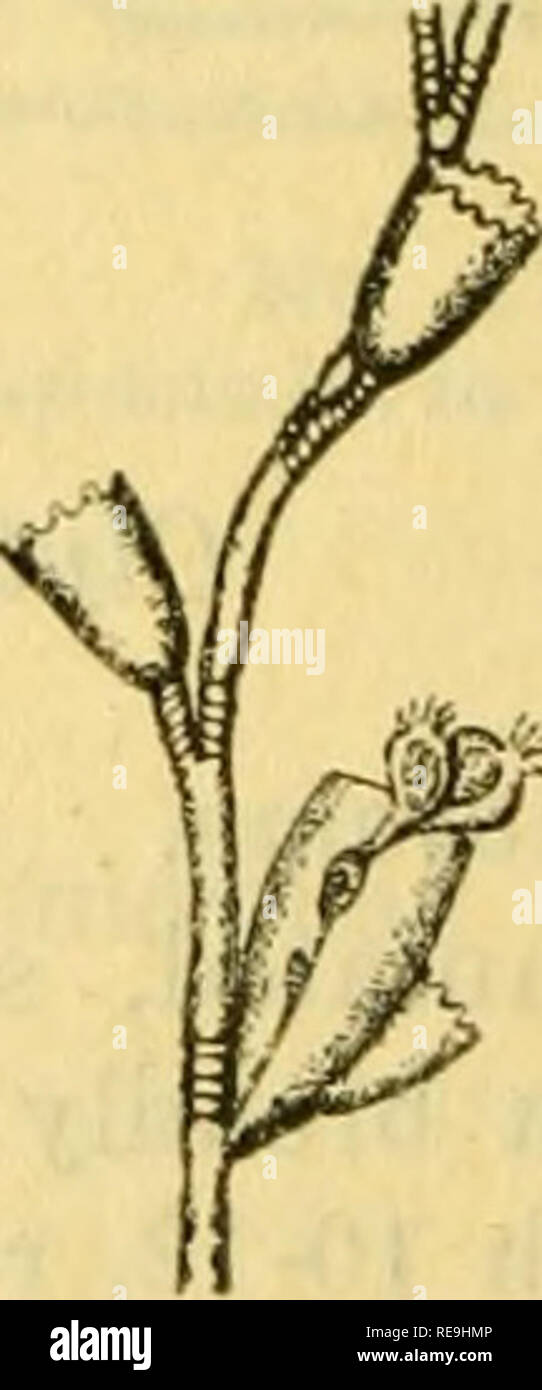 . Contributions to Canadian biology. Marine biology; Natural history. 158 DEPARTMEyr OF THE NATAL SERVICE Genus Goxothyr.ea. Trophosomc. As in the family. Gonosome. Reproduction by lixed niedusiforra sporosaca, furnisbed with ten- tacles, that at maturity become extra-eapsular, remaining attached until their con- tents are discharged. KKY TO SPKCIKS. a Colony slightly and irregularly branched, margin with sharp teeth. G. gracilis. h Colony large, more regularly branched, margin with blunt, square-topped teeth. G. loveni. Gonothyi'cca gracilis (Sars). Trophosomc. Colony slightly and irregularly Stock Photohttps://www.alamy.com/image-license-details/?v=1https://www.alamy.com/contributions-to-canadian-biology-marine-biology-natural-history-158-departmeyr-of-the-natal-service-genus-goxothyrea-trophosomc-as-in-the-family-gonosome-reproduction-by-lixed-niedusiforra-sporosaca-furnisbed-with-ten-tacles-that-at-maturity-become-extra-eapsular-remaining-attached-until-their-con-tents-are-discharged-kky-to-spkciks-a-colony-slightly-and-irregularly-branched-margin-with-sharp-teeth-g-gracilis-h-colony-large-more-regularly-branched-margin-with-blunt-square-topped-teeth-g-loveni-gonothyicca-gracilis-sars-trophosomc-colony-slightly-and-irregularly-image232551446.html
. Contributions to Canadian biology. Marine biology; Natural history. 158 DEPARTMEyr OF THE NATAL SERVICE Genus Goxothyr.ea. Trophosomc. As in the family. Gonosome. Reproduction by lixed niedusiforra sporosaca, furnisbed with ten- tacles, that at maturity become extra-eapsular, remaining attached until their con- tents are discharged. KKY TO SPKCIKS. a Colony slightly and irregularly branched, margin with sharp teeth. G. gracilis. h Colony large, more regularly branched, margin with blunt, square-topped teeth. G. loveni. Gonothyi'cca gracilis (Sars). Trophosomc. Colony slightly and irregularly Stock Photohttps://www.alamy.com/image-license-details/?v=1https://www.alamy.com/contributions-to-canadian-biology-marine-biology-natural-history-158-departmeyr-of-the-natal-service-genus-goxothyrea-trophosomc-as-in-the-family-gonosome-reproduction-by-lixed-niedusiforra-sporosaca-furnisbed-with-ten-tacles-that-at-maturity-become-extra-eapsular-remaining-attached-until-their-con-tents-are-discharged-kky-to-spkciks-a-colony-slightly-and-irregularly-branched-margin-with-sharp-teeth-g-gracilis-h-colony-large-more-regularly-branched-margin-with-blunt-square-topped-teeth-g-loveni-gonothyicca-gracilis-sars-trophosomc-colony-slightly-and-irregularly-image232551446.htmlRMRE9HMP–. Contributions to Canadian biology. Marine biology; Natural history. 158 DEPARTMEyr OF THE NATAL SERVICE Genus Goxothyr.ea. Trophosomc. As in the family. Gonosome. Reproduction by lixed niedusiforra sporosaca, furnisbed with ten- tacles, that at maturity become extra-eapsular, remaining attached until their con- tents are discharged. KKY TO SPKCIKS. a Colony slightly and irregularly branched, margin with sharp teeth. G. gracilis. h Colony large, more regularly branched, margin with blunt, square-topped teeth. G. loveni. Gonothyi'cca gracilis (Sars). Trophosomc. Colony slightly and irregularly
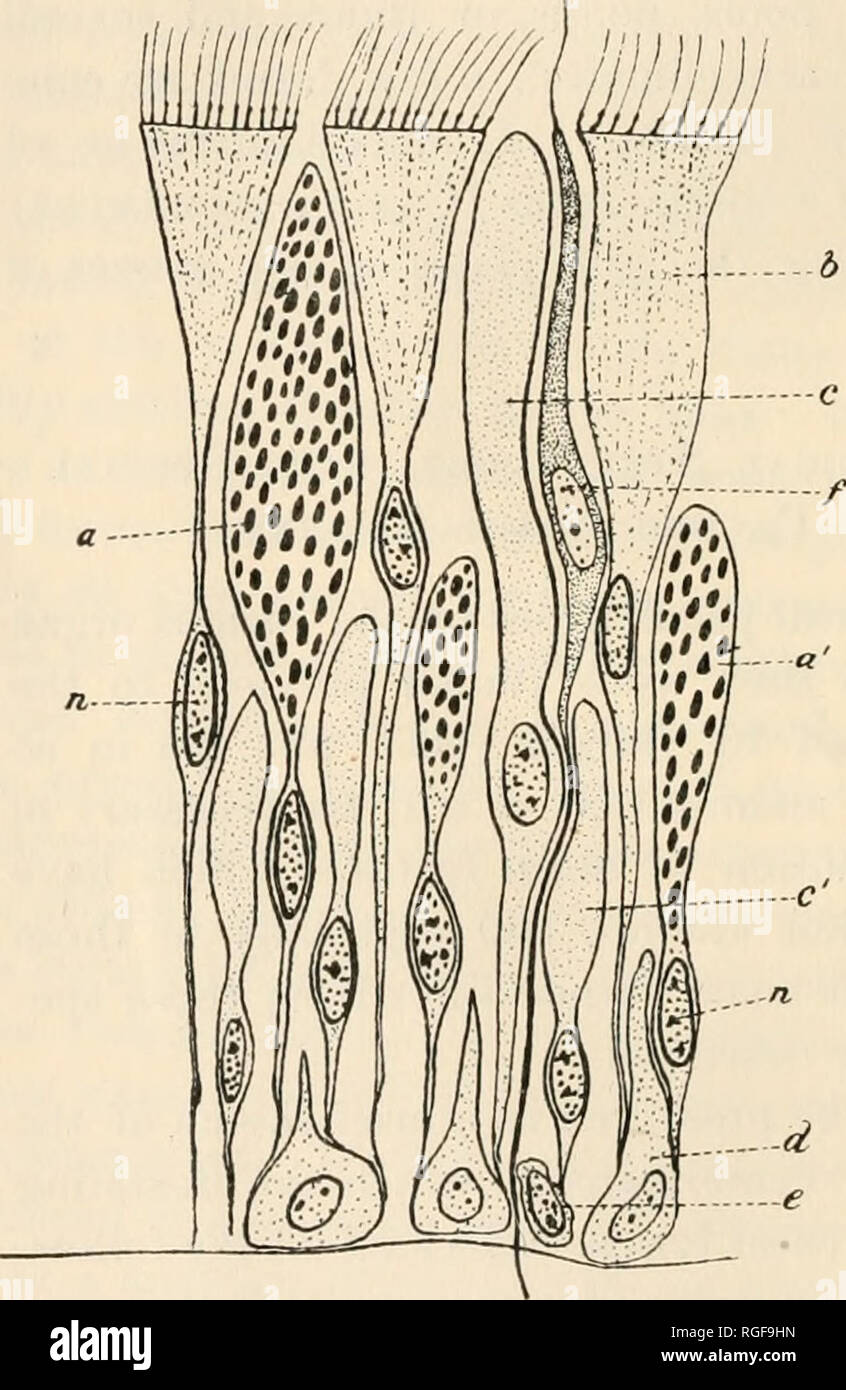 . Bulletin of the Museum of Comparative Zoology at Harvard College. Zoology. BULLKTIX: MrsP:UM OF COMrARATIVK ZOOLOGY, Integument. The body wall of the neraerteans consists of an outer integument, composed of ciliated, glandular, and interstitial cells, and of a series of two or more layers of muscles. The iiitegwaent is composed of highly columnar, often club- shaped cells arranged irregularly in a single layer; many of the cells do not reach the surface, however, and others lie quite super- ficially, these latter being attached among the underlying cells by long fibrous processes (Text-fig. Stock Photohttps://www.alamy.com/image-license-details/?v=1https://www.alamy.com/bulletin-of-the-museum-of-comparative-zoology-at-harvard-college-zoology-bullktix-mrspum-of-comrarativk-zoology-integument-the-body-wall-of-the-neraerteans-consists-of-an-outer-integument-composed-of-ciliated-glandular-and-interstitial-cells-and-of-a-series-of-two-or-more-layers-of-muscles-the-iiitegwaent-is-composed-of-highly-columnar-often-club-shaped-cells-arranged-irregularly-in-a-single-layer-many-of-the-cells-do-not-reach-the-surface-however-and-others-lie-quite-super-ficially-these-latter-being-attached-among-the-underlying-cells-by-long-fibrous-processes-text-fig-image233906113.html
. Bulletin of the Museum of Comparative Zoology at Harvard College. Zoology. BULLKTIX: MrsP:UM OF COMrARATIVK ZOOLOGY, Integument. The body wall of the neraerteans consists of an outer integument, composed of ciliated, glandular, and interstitial cells, and of a series of two or more layers of muscles. The iiitegwaent is composed of highly columnar, often club- shaped cells arranged irregularly in a single layer; many of the cells do not reach the surface, however, and others lie quite super- ficially, these latter being attached among the underlying cells by long fibrous processes (Text-fig. Stock Photohttps://www.alamy.com/image-license-details/?v=1https://www.alamy.com/bulletin-of-the-museum-of-comparative-zoology-at-harvard-college-zoology-bullktix-mrspum-of-comrarativk-zoology-integument-the-body-wall-of-the-neraerteans-consists-of-an-outer-integument-composed-of-ciliated-glandular-and-interstitial-cells-and-of-a-series-of-two-or-more-layers-of-muscles-the-iiitegwaent-is-composed-of-highly-columnar-often-club-shaped-cells-arranged-irregularly-in-a-single-layer-many-of-the-cells-do-not-reach-the-surface-however-and-others-lie-quite-super-ficially-these-latter-being-attached-among-the-underlying-cells-by-long-fibrous-processes-text-fig-image233906113.htmlRMRGF9HN–. Bulletin of the Museum of Comparative Zoology at Harvard College. Zoology. BULLKTIX: MrsP:UM OF COMrARATIVK ZOOLOGY, Integument. The body wall of the neraerteans consists of an outer integument, composed of ciliated, glandular, and interstitial cells, and of a series of two or more layers of muscles. The iiitegwaent is composed of highly columnar, often club- shaped cells arranged irregularly in a single layer; many of the cells do not reach the surface, however, and others lie quite super- ficially, these latter being attached among the underlying cells by long fibrous processes (Text-fig.
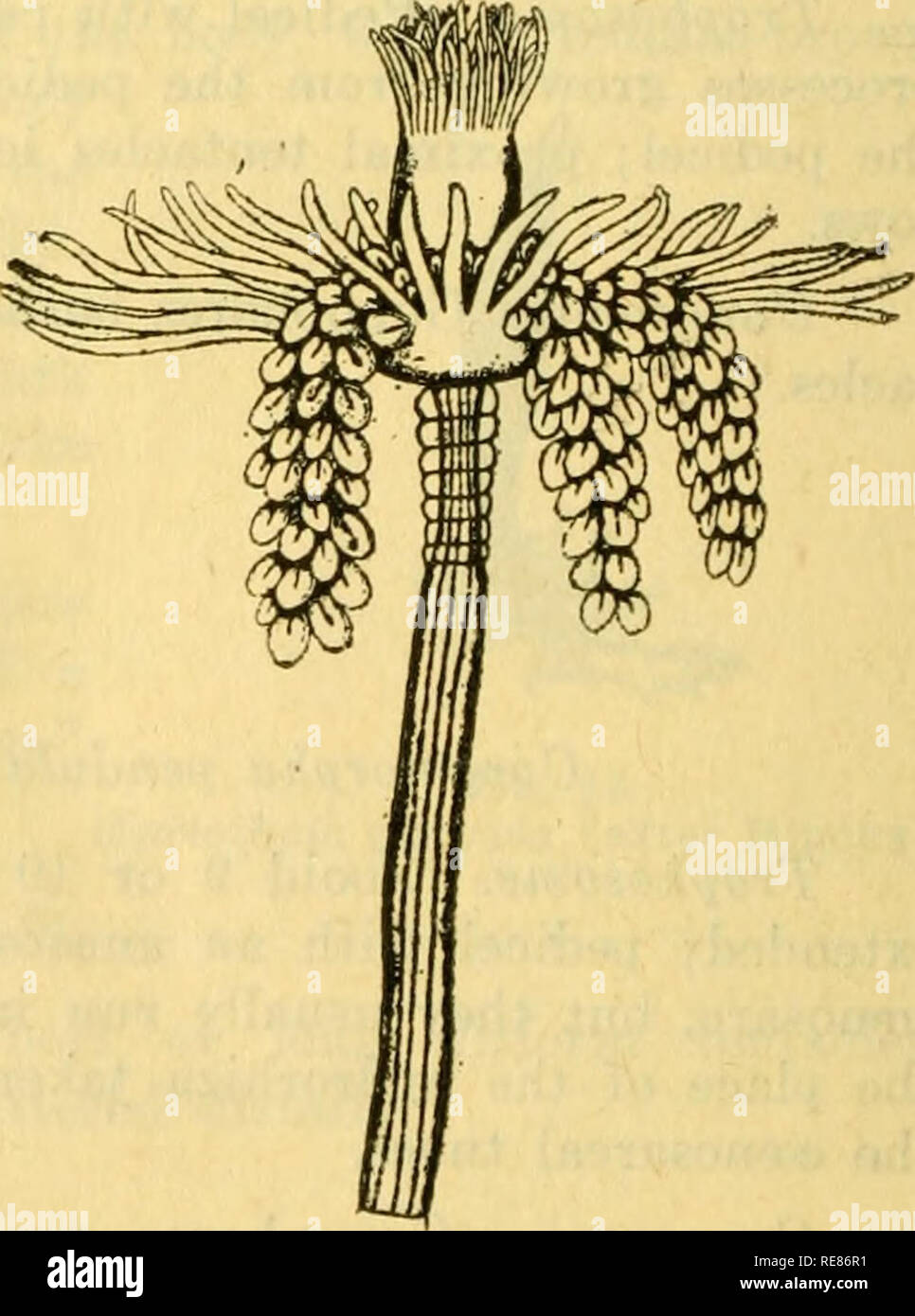 . Contributions to Canadian biology. Marine biology; Natural history. 150 DEPARTMEyT OF THE yiVAL SERVICE Family TUBULARID.^. Trophosome. Sttnn unbranched or irregTilarly branched; perisarc definite; hydranths witli a distal and a proximal set of filiform tentacles. Gonosome. Gonophores producing actinulse. Genus Tubularia. Trophosome. Stem unbranched or irregularly branched; proximal set of ten- tacles longer than the distal set, each set in one whorl. Gonosome. Gonophores in clusters, attached by means of stalked peduncles to the body of the hydranth just distal to the proximal tentacles; fe Stock Photohttps://www.alamy.com/image-license-details/?v=1https://www.alamy.com/contributions-to-canadian-biology-marine-biology-natural-history-150-departmeyt-of-the-yival-service-family-tubularid-trophosome-sttnn-unbranched-or-irregtilarly-branched-perisarc-definite-hydranths-witli-a-distal-and-a-proximal-set-of-filiform-tentacles-gonosome-gonophores-producing-actinulse-genus-tubularia-trophosome-stem-unbranched-or-irregularly-branched-proximal-set-of-ten-tacles-longer-than-the-distal-set-each-set-in-one-whorl-gonosome-gonophores-in-clusters-attached-by-means-of-stalked-peduncles-to-the-body-of-the-hydranth-just-distal-to-the-proximal-tentacles-fe-image232520933.html
. Contributions to Canadian biology. Marine biology; Natural history. 150 DEPARTMEyT OF THE yiVAL SERVICE Family TUBULARID.^. Trophosome. Sttnn unbranched or irregTilarly branched; perisarc definite; hydranths witli a distal and a proximal set of filiform tentacles. Gonosome. Gonophores producing actinulse. Genus Tubularia. Trophosome. Stem unbranched or irregularly branched; proximal set of ten- tacles longer than the distal set, each set in one whorl. Gonosome. Gonophores in clusters, attached by means of stalked peduncles to the body of the hydranth just distal to the proximal tentacles; fe Stock Photohttps://www.alamy.com/image-license-details/?v=1https://www.alamy.com/contributions-to-canadian-biology-marine-biology-natural-history-150-departmeyt-of-the-yival-service-family-tubularid-trophosome-sttnn-unbranched-or-irregtilarly-branched-perisarc-definite-hydranths-witli-a-distal-and-a-proximal-set-of-filiform-tentacles-gonosome-gonophores-producing-actinulse-genus-tubularia-trophosome-stem-unbranched-or-irregularly-branched-proximal-set-of-ten-tacles-longer-than-the-distal-set-each-set-in-one-whorl-gonosome-gonophores-in-clusters-attached-by-means-of-stalked-peduncles-to-the-body-of-the-hydranth-just-distal-to-the-proximal-tentacles-fe-image232520933.htmlRMRE86R1–. Contributions to Canadian biology. Marine biology; Natural history. 150 DEPARTMEyT OF THE yiVAL SERVICE Family TUBULARID.^. Trophosome. Sttnn unbranched or irregTilarly branched; perisarc definite; hydranths witli a distal and a proximal set of filiform tentacles. Gonosome. Gonophores producing actinulse. Genus Tubularia. Trophosome. Stem unbranched or irregularly branched; proximal set of ten- tacles longer than the distal set, each set in one whorl. Gonosome. Gonophores in clusters, attached by means of stalked peduncles to the body of the hydranth just distal to the proximal tentacles; fe
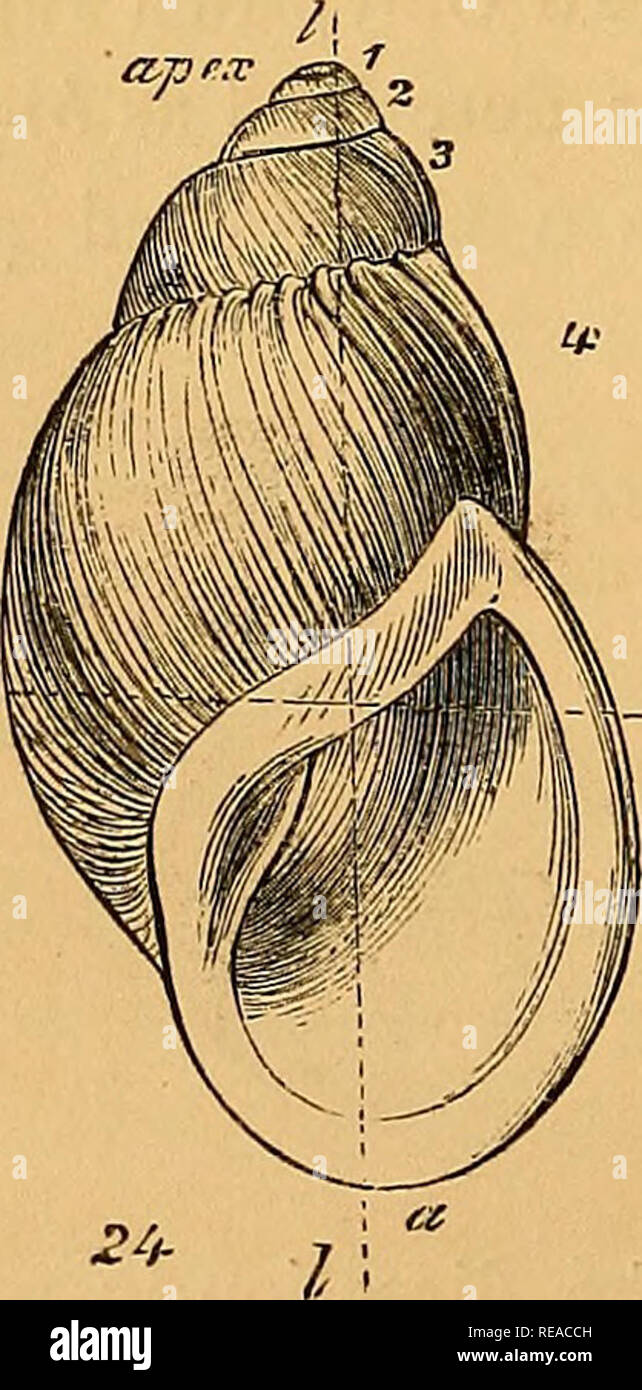 . A conchological manual. Shells. 20 INTRODUCTION. the shell is to be measured for length, a indicates the ante- rior, p the posterior. The line d (fig. 23), from the apex to the base, is the depth. The line h (fig. 28), is in the direc- tion of the breadth. Irregular non-symmetrical Univalves. Serpuliform shells are irregularly twisted hollow tubes, which were formerly considered to have been secreted by a kind of worm, but now known to be the shells of true Molluscs, of a kind not very widely differing from those which have regularly spiral shells. The greater part of these are attached to f Stock Photohttps://www.alamy.com/image-license-details/?v=1https://www.alamy.com/a-conchological-manual-shells-20-introduction-the-shell-is-to-be-measured-for-length-a-indicates-the-ante-rior-p-the-posterior-the-line-d-fig-23-from-the-apex-to-the-base-is-the-depth-the-line-h-fig-28-is-in-the-direc-tion-of-the-breadth-irregular-non-symmetrical-univalves-serpuliform-shells-are-irregularly-twisted-hollow-tubes-which-were-formerly-considered-to-have-been-secreted-by-a-kind-of-worm-but-now-known-to-be-the-shells-of-true-molluscs-of-a-kind-not-very-widely-differing-from-those-which-have-regularly-spiral-shells-the-greater-part-of-these-are-attached-to-f-image232569249.html
. A conchological manual. Shells. 20 INTRODUCTION. the shell is to be measured for length, a indicates the ante- rior, p the posterior. The line d (fig. 23), from the apex to the base, is the depth. The line h (fig. 28), is in the direc- tion of the breadth. Irregular non-symmetrical Univalves. Serpuliform shells are irregularly twisted hollow tubes, which were formerly considered to have been secreted by a kind of worm, but now known to be the shells of true Molluscs, of a kind not very widely differing from those which have regularly spiral shells. The greater part of these are attached to f Stock Photohttps://www.alamy.com/image-license-details/?v=1https://www.alamy.com/a-conchological-manual-shells-20-introduction-the-shell-is-to-be-measured-for-length-a-indicates-the-ante-rior-p-the-posterior-the-line-d-fig-23-from-the-apex-to-the-base-is-the-depth-the-line-h-fig-28-is-in-the-direc-tion-of-the-breadth-irregular-non-symmetrical-univalves-serpuliform-shells-are-irregularly-twisted-hollow-tubes-which-were-formerly-considered-to-have-been-secreted-by-a-kind-of-worm-but-now-known-to-be-the-shells-of-true-molluscs-of-a-kind-not-very-widely-differing-from-those-which-have-regularly-spiral-shells-the-greater-part-of-these-are-attached-to-f-image232569249.htmlRMREACCH–. A conchological manual. Shells. 20 INTRODUCTION. the shell is to be measured for length, a indicates the ante- rior, p the posterior. The line d (fig. 23), from the apex to the base, is the depth. The line h (fig. 28), is in the direc- tion of the breadth. Irregular non-symmetrical Univalves. Serpuliform shells are irregularly twisted hollow tubes, which were formerly considered to have been secreted by a kind of worm, but now known to be the shells of true Molluscs, of a kind not very widely differing from those which have regularly spiral shells. The greater part of these are attached to f
 . A history of the vegetable kingdom; embracing the physiology of plants, with their uses to man and the lower animals, and their application in the arts, manufactures, and domestic economy. Illus. by several hundred figures. Botany; Botany, Economic; 1855. JERUSALEM ARTICHOKE. 283 angular shape, and irregularly notched. The flowers are of a purple colour. There are seve- ral varieties of the cultivated plant, depending upon soil and climate. In tropical countries, of which it is a native, the roots attain a consider- able size, and sometimes fifty are found attached to one plant. The roots, w Stock Photohttps://www.alamy.com/image-license-details/?v=1https://www.alamy.com/a-history-of-the-vegetable-kingdom-embracing-the-physiology-of-plants-with-their-uses-to-man-and-the-lower-animals-and-their-application-in-the-arts-manufactures-and-domestic-economy-illus-by-several-hundred-figures-botany-botany-economic-1855-jerusalem-artichoke-283-angular-shape-and-irregularly-notched-the-flowers-are-of-a-purple-colour-there-are-seve-ral-varieties-of-the-cultivated-plant-depending-upon-soil-and-climate-in-tropical-countries-of-which-it-is-a-native-the-roots-attain-a-consider-able-size-and-sometimes-fifty-are-found-attached-to-one-plant-the-roots-w-image232356992.html
. A history of the vegetable kingdom; embracing the physiology of plants, with their uses to man and the lower animals, and their application in the arts, manufactures, and domestic economy. Illus. by several hundred figures. Botany; Botany, Economic; 1855. JERUSALEM ARTICHOKE. 283 angular shape, and irregularly notched. The flowers are of a purple colour. There are seve- ral varieties of the cultivated plant, depending upon soil and climate. In tropical countries, of which it is a native, the roots attain a consider- able size, and sometimes fifty are found attached to one plant. The roots, w Stock Photohttps://www.alamy.com/image-license-details/?v=1https://www.alamy.com/a-history-of-the-vegetable-kingdom-embracing-the-physiology-of-plants-with-their-uses-to-man-and-the-lower-animals-and-their-application-in-the-arts-manufactures-and-domestic-economy-illus-by-several-hundred-figures-botany-botany-economic-1855-jerusalem-artichoke-283-angular-shape-and-irregularly-notched-the-flowers-are-of-a-purple-colour-there-are-seve-ral-varieties-of-the-cultivated-plant-depending-upon-soil-and-climate-in-tropical-countries-of-which-it-is-a-native-the-roots-attain-a-consider-able-size-and-sometimes-fifty-are-found-attached-to-one-plant-the-roots-w-image232356992.htmlRMRE0NM0–. A history of the vegetable kingdom; embracing the physiology of plants, with their uses to man and the lower animals, and their application in the arts, manufactures, and domestic economy. Illus. by several hundred figures. Botany; Botany, Economic; 1855. JERUSALEM ARTICHOKE. 283 angular shape, and irregularly notched. The flowers are of a purple colour. There are seve- ral varieties of the cultivated plant, depending upon soil and climate. In tropical countries, of which it is a native, the roots attain a consider- able size, and sometimes fifty are found attached to one plant. The roots, w
![. Fungi, ascomycetes, ustilaginales, uredinales. Fungi. IV] HELVELLALES 129 In Sphaerosoma the ascophore is more or less sunk in the substratum, and is attached by rooting hyphae which are sometimes grouped on a short pedicel. It is concave when young, but later forms an irregularly globose mass over the upper surface of which the hymenium is spread (fig. 89). It resembles, in fact, a Peziza which becomes very much reflexed at maturity. In Sph. Janczewskianum (fig. 88), a large Fig. 89. Sphaerosoma fuscescens (Klotz.) oogonial cell has been recognized from Roup.; apothecium, x6; after Roup- wh Stock Photo . Fungi, ascomycetes, ustilaginales, uredinales. Fungi. IV] HELVELLALES 129 In Sphaerosoma the ascophore is more or less sunk in the substratum, and is attached by rooting hyphae which are sometimes grouped on a short pedicel. It is concave when young, but later forms an irregularly globose mass over the upper surface of which the hymenium is spread (fig. 89). It resembles, in fact, a Peziza which becomes very much reflexed at maturity. In Sph. Janczewskianum (fig. 88), a large Fig. 89. Sphaerosoma fuscescens (Klotz.) oogonial cell has been recognized from Roup.; apothecium, x6; after Roup- wh Stock Photo](https://c8.alamy.com/comp/RDTNME/fungi-ascomycetes-ustilaginales-uredinales-fungi-iv-helvellales-129-in-sphaerosoma-the-ascophore-is-more-or-less-sunk-in-the-substratum-and-is-attached-by-rooting-hyphae-which-are-sometimes-grouped-on-a-short-pedicel-it-is-concave-when-young-but-later-forms-an-irregularly-globose-mass-over-the-upper-surface-of-which-the-hymenium-is-spread-fig-89-it-resembles-in-fact-a-peziza-which-becomes-very-much-reflexed-at-maturity-in-sph-janczewskianum-fig-88-a-large-fig-89-sphaerosoma-fuscescens-klotz-oogonial-cell-has-been-recognized-from-roup-apothecium-x6-after-roup-wh-RDTNME.jpg) . Fungi, ascomycetes, ustilaginales, uredinales. Fungi. IV] HELVELLALES 129 In Sphaerosoma the ascophore is more or less sunk in the substratum, and is attached by rooting hyphae which are sometimes grouped on a short pedicel. It is concave when young, but later forms an irregularly globose mass over the upper surface of which the hymenium is spread (fig. 89). It resembles, in fact, a Peziza which becomes very much reflexed at maturity. In Sph. Janczewskianum (fig. 88), a large Fig. 89. Sphaerosoma fuscescens (Klotz.) oogonial cell has been recognized from Roup.; apothecium, x6; after Roup- wh Stock Photohttps://www.alamy.com/image-license-details/?v=1https://www.alamy.com/fungi-ascomycetes-ustilaginales-uredinales-fungi-iv-helvellales-129-in-sphaerosoma-the-ascophore-is-more-or-less-sunk-in-the-substratum-and-is-attached-by-rooting-hyphae-which-are-sometimes-grouped-on-a-short-pedicel-it-is-concave-when-young-but-later-forms-an-irregularly-globose-mass-over-the-upper-surface-of-which-the-hymenium-is-spread-fig-89-it-resembles-in-fact-a-peziza-which-becomes-very-much-reflexed-at-maturity-in-sph-janczewskianum-fig-88-a-large-fig-89-sphaerosoma-fuscescens-klotz-oogonial-cell-has-been-recognized-from-roup-apothecium-x6-after-roup-wh-image232269198.html
. Fungi, ascomycetes, ustilaginales, uredinales. Fungi. IV] HELVELLALES 129 In Sphaerosoma the ascophore is more or less sunk in the substratum, and is attached by rooting hyphae which are sometimes grouped on a short pedicel. It is concave when young, but later forms an irregularly globose mass over the upper surface of which the hymenium is spread (fig. 89). It resembles, in fact, a Peziza which becomes very much reflexed at maturity. In Sph. Janczewskianum (fig. 88), a large Fig. 89. Sphaerosoma fuscescens (Klotz.) oogonial cell has been recognized from Roup.; apothecium, x6; after Roup- wh Stock Photohttps://www.alamy.com/image-license-details/?v=1https://www.alamy.com/fungi-ascomycetes-ustilaginales-uredinales-fungi-iv-helvellales-129-in-sphaerosoma-the-ascophore-is-more-or-less-sunk-in-the-substratum-and-is-attached-by-rooting-hyphae-which-are-sometimes-grouped-on-a-short-pedicel-it-is-concave-when-young-but-later-forms-an-irregularly-globose-mass-over-the-upper-surface-of-which-the-hymenium-is-spread-fig-89-it-resembles-in-fact-a-peziza-which-becomes-very-much-reflexed-at-maturity-in-sph-janczewskianum-fig-88-a-large-fig-89-sphaerosoma-fuscescens-klotz-oogonial-cell-has-been-recognized-from-roup-apothecium-x6-after-roup-wh-image232269198.htmlRMRDTNME–. Fungi, ascomycetes, ustilaginales, uredinales. Fungi. IV] HELVELLALES 129 In Sphaerosoma the ascophore is more or less sunk in the substratum, and is attached by rooting hyphae which are sometimes grouped on a short pedicel. It is concave when young, but later forms an irregularly globose mass over the upper surface of which the hymenium is spread (fig. 89). It resembles, in fact, a Peziza which becomes very much reflexed at maturity. In Sph. Janczewskianum (fig. 88), a large Fig. 89. Sphaerosoma fuscescens (Klotz.) oogonial cell has been recognized from Roup.; apothecium, x6; after Roup- wh
 . Bulletin of the Museum of Comparative Zoology at Harvard College. Zoology. 470 bulletin: museum of comparative zoology part of a seminal vesicle and extends to segment XXXI just behind the posterior end of the euprostates. The tubular part of the seminal vesicles suddenly broadens to form the seminal vesicles proper which extends backwards through many segments, in a carefully examined specimen as far as segment LVIII. A true seminal vesicle is a broad, flat, irregularly lobed band, closely attached to the dorsal side of the intestine, and deeply grooved at the intersegments. A pair of large Stock Photohttps://www.alamy.com/image-license-details/?v=1https://www.alamy.com/bulletin-of-the-museum-of-comparative-zoology-at-harvard-college-zoology-470-bulletin-museum-of-comparative-zoology-part-of-a-seminal-vesicle-and-extends-to-segment-xxxi-just-behind-the-posterior-end-of-the-euprostates-the-tubular-part-of-the-seminal-vesicles-suddenly-broadens-to-form-the-seminal-vesicles-proper-which-extends-backwards-through-many-segments-in-a-carefully-examined-specimen-as-far-as-segment-lviii-a-true-seminal-vesicle-is-a-broad-flat-irregularly-lobed-band-closely-attached-to-the-dorsal-side-of-the-intestine-and-deeply-grooved-at-the-intersegments-a-pair-of-large-image233914854.html
. Bulletin of the Museum of Comparative Zoology at Harvard College. Zoology. 470 bulletin: museum of comparative zoology part of a seminal vesicle and extends to segment XXXI just behind the posterior end of the euprostates. The tubular part of the seminal vesicles suddenly broadens to form the seminal vesicles proper which extends backwards through many segments, in a carefully examined specimen as far as segment LVIII. A true seminal vesicle is a broad, flat, irregularly lobed band, closely attached to the dorsal side of the intestine, and deeply grooved at the intersegments. A pair of large Stock Photohttps://www.alamy.com/image-license-details/?v=1https://www.alamy.com/bulletin-of-the-museum-of-comparative-zoology-at-harvard-college-zoology-470-bulletin-museum-of-comparative-zoology-part-of-a-seminal-vesicle-and-extends-to-segment-xxxi-just-behind-the-posterior-end-of-the-euprostates-the-tubular-part-of-the-seminal-vesicles-suddenly-broadens-to-form-the-seminal-vesicles-proper-which-extends-backwards-through-many-segments-in-a-carefully-examined-specimen-as-far-as-segment-lviii-a-true-seminal-vesicle-is-a-broad-flat-irregularly-lobed-band-closely-attached-to-the-dorsal-side-of-the-intestine-and-deeply-grooved-at-the-intersegments-a-pair-of-large-image233914854.htmlRMRGFMNX–. Bulletin of the Museum of Comparative Zoology at Harvard College. Zoology. 470 bulletin: museum of comparative zoology part of a seminal vesicle and extends to segment XXXI just behind the posterior end of the euprostates. The tubular part of the seminal vesicles suddenly broadens to form the seminal vesicles proper which extends backwards through many segments, in a carefully examined specimen as far as segment LVIII. A true seminal vesicle is a broad, flat, irregularly lobed band, closely attached to the dorsal side of the intestine, and deeply grooved at the intersegments. A pair of large
![. Weeds of the farm and ranch [microform]. Sols; Weeds; Tillage; Mauvaises herbes. It SS DEPARTSfENT OF AoBICULTUBS COMMON EVENING PRIMROSE—Ocno/Aera hiennia. L. A tail, stoat native plant of biennial habit. Its leaves are from one to six inches long, pointed, narrowed at the base and closely attached to the stem, or short stalked. Its flowers, which open at night, are yellow and the seed pods grow close to the stem, about an inch in length, containing small irregularly shaped brown seeds. This weed is seldom troublesome except where crops have been sown on stubble and is easily destroyed by f Stock Photo . Weeds of the farm and ranch [microform]. Sols; Weeds; Tillage; Mauvaises herbes. It SS DEPARTSfENT OF AoBICULTUBS COMMON EVENING PRIMROSE—Ocno/Aera hiennia. L. A tail, stoat native plant of biennial habit. Its leaves are from one to six inches long, pointed, narrowed at the base and closely attached to the stem, or short stalked. Its flowers, which open at night, are yellow and the seed pods grow close to the stem, about an inch in length, containing small irregularly shaped brown seeds. This weed is seldom troublesome except where crops have been sown on stubble and is easily destroyed by f Stock Photo](https://c8.alamy.com/comp/REN40K/weeds-of-the-farm-and-ranch-microform-sols-weeds-tillage-mauvaises-herbes-it-ss-departsfent-of-aobicultubs-common-evening-primroseocnoaera-hiennia-l-a-tail-stoat-native-plant-of-biennial-habit-its-leaves-are-from-one-to-six-inches-long-pointed-narrowed-at-the-base-and-closely-attached-to-the-stem-or-short-stalked-its-flowers-which-open-at-night-are-yellow-and-the-seed-pods-grow-close-to-the-stem-about-an-inch-in-length-containing-small-irregularly-shaped-brown-seeds-this-weed-is-seldom-troublesome-except-where-crops-have-been-sown-on-stubble-and-is-easily-destroyed-by-f-REN40K.jpg) . Weeds of the farm and ranch [microform]. Sols; Weeds; Tillage; Mauvaises herbes. It SS DEPARTSfENT OF AoBICULTUBS COMMON EVENING PRIMROSE—Ocno/Aera hiennia. L. A tail, stoat native plant of biennial habit. Its leaves are from one to six inches long, pointed, narrowed at the base and closely attached to the stem, or short stalked. Its flowers, which open at night, are yellow and the seed pods grow close to the stem, about an inch in length, containing small irregularly shaped brown seeds. This weed is seldom troublesome except where crops have been sown on stubble and is easily destroyed by f Stock Photohttps://www.alamy.com/image-license-details/?v=1https://www.alamy.com/weeds-of-the-farm-and-ranch-microform-sols-weeds-tillage-mauvaises-herbes-it-ss-departsfent-of-aobicultubs-common-evening-primroseocnoaera-hiennia-l-a-tail-stoat-native-plant-of-biennial-habit-its-leaves-are-from-one-to-six-inches-long-pointed-narrowed-at-the-base-and-closely-attached-to-the-stem-or-short-stalked-its-flowers-which-open-at-night-are-yellow-and-the-seed-pods-grow-close-to-the-stem-about-an-inch-in-length-containing-small-irregularly-shaped-brown-seeds-this-weed-is-seldom-troublesome-except-where-crops-have-been-sown-on-stubble-and-is-easily-destroyed-by-f-image232804115.html
. Weeds of the farm and ranch [microform]. Sols; Weeds; Tillage; Mauvaises herbes. It SS DEPARTSfENT OF AoBICULTUBS COMMON EVENING PRIMROSE—Ocno/Aera hiennia. L. A tail, stoat native plant of biennial habit. Its leaves are from one to six inches long, pointed, narrowed at the base and closely attached to the stem, or short stalked. Its flowers, which open at night, are yellow and the seed pods grow close to the stem, about an inch in length, containing small irregularly shaped brown seeds. This weed is seldom troublesome except where crops have been sown on stubble and is easily destroyed by f Stock Photohttps://www.alamy.com/image-license-details/?v=1https://www.alamy.com/weeds-of-the-farm-and-ranch-microform-sols-weeds-tillage-mauvaises-herbes-it-ss-departsfent-of-aobicultubs-common-evening-primroseocnoaera-hiennia-l-a-tail-stoat-native-plant-of-biennial-habit-its-leaves-are-from-one-to-six-inches-long-pointed-narrowed-at-the-base-and-closely-attached-to-the-stem-or-short-stalked-its-flowers-which-open-at-night-are-yellow-and-the-seed-pods-grow-close-to-the-stem-about-an-inch-in-length-containing-small-irregularly-shaped-brown-seeds-this-weed-is-seldom-troublesome-except-where-crops-have-been-sown-on-stubble-and-is-easily-destroyed-by-f-image232804115.htmlRMREN40K–. Weeds of the farm and ranch [microform]. Sols; Weeds; Tillage; Mauvaises herbes. It SS DEPARTSfENT OF AoBICULTUBS COMMON EVENING PRIMROSE—Ocno/Aera hiennia. L. A tail, stoat native plant of biennial habit. Its leaves are from one to six inches long, pointed, narrowed at the base and closely attached to the stem, or short stalked. Its flowers, which open at night, are yellow and the seed pods grow close to the stem, about an inch in length, containing small irregularly shaped brown seeds. This weed is seldom troublesome except where crops have been sown on stubble and is easily destroyed by f
![. Allan Hancock Pacific expeditions. [Reports]. Scientific expeditions. 18 ALLAN HANCOCK PACIFIC EXPEDITIONS VOL. 27 ment-like tube, irregularly occupying crevices of rock; Hypoeulalia, nr bilineata, deep yellow in life; Isocirrus sp.; Lepidonotus caelorus; Lumbrineris inflata; Marphysa conferta; Nicomache personata; Pei- sidice aspera; Phyllochaetopterus prolifica; Pherusa inflata; Pherusa papillata; Sabellaria cementarium, in arenaceous tubes attached to rock; Typosyllis, nr hyalina; Vermiliopsis spp., attached to rocky sur- faces. In addition, Scalpellurn, a stalked barnacle, amphipods, bra Stock Photo . Allan Hancock Pacific expeditions. [Reports]. Scientific expeditions. 18 ALLAN HANCOCK PACIFIC EXPEDITIONS VOL. 27 ment-like tube, irregularly occupying crevices of rock; Hypoeulalia, nr bilineata, deep yellow in life; Isocirrus sp.; Lepidonotus caelorus; Lumbrineris inflata; Marphysa conferta; Nicomache personata; Pei- sidice aspera; Phyllochaetopterus prolifica; Pherusa inflata; Pherusa papillata; Sabellaria cementarium, in arenaceous tubes attached to rock; Typosyllis, nr hyalina; Vermiliopsis spp., attached to rocky sur- faces. In addition, Scalpellurn, a stalked barnacle, amphipods, bra Stock Photo](https://c8.alamy.com/comp/RPWJJJ/allan-hancock-pacific-expeditions-reports-scientific-expeditions-18-allan-hancock-pacific-expeditions-vol-27-ment-like-tube-irregularly-occupying-crevices-of-rock-hypoeulalia-nr-bilineata-deep-yellow-in-life-isocirrus-sp-lepidonotus-caelorus-lumbrineris-inflata-marphysa-conferta-nicomache-personata-pei-sidice-aspera-phyllochaetopterus-prolifica-pherusa-inflata-pherusa-papillata-sabellaria-cementarium-in-arenaceous-tubes-attached-to-rock-typosyllis-nr-hyalina-vermiliopsis-spp-attached-to-rocky-sur-faces-in-addition-scalpellurn-a-stalked-barnacle-amphipods-bra-RPWJJJ.jpg) . Allan Hancock Pacific expeditions. [Reports]. Scientific expeditions. 18 ALLAN HANCOCK PACIFIC EXPEDITIONS VOL. 27 ment-like tube, irregularly occupying crevices of rock; Hypoeulalia, nr bilineata, deep yellow in life; Isocirrus sp.; Lepidonotus caelorus; Lumbrineris inflata; Marphysa conferta; Nicomache personata; Pei- sidice aspera; Phyllochaetopterus prolifica; Pherusa inflata; Pherusa papillata; Sabellaria cementarium, in arenaceous tubes attached to rock; Typosyllis, nr hyalina; Vermiliopsis spp., attached to rocky sur- faces. In addition, Scalpellurn, a stalked barnacle, amphipods, bra Stock Photohttps://www.alamy.com/image-license-details/?v=1https://www.alamy.com/allan-hancock-pacific-expeditions-reports-scientific-expeditions-18-allan-hancock-pacific-expeditions-vol-27-ment-like-tube-irregularly-occupying-crevices-of-rock-hypoeulalia-nr-bilineata-deep-yellow-in-life-isocirrus-sp-lepidonotus-caelorus-lumbrineris-inflata-marphysa-conferta-nicomache-personata-pei-sidice-aspera-phyllochaetopterus-prolifica-pherusa-inflata-pherusa-papillata-sabellaria-cementarium-in-arenaceous-tubes-attached-to-rock-typosyllis-nr-hyalina-vermiliopsis-spp-attached-to-rocky-sur-faces-in-addition-scalpellurn-a-stalked-barnacle-amphipods-bra-image237820650.html
. Allan Hancock Pacific expeditions. [Reports]. Scientific expeditions. 18 ALLAN HANCOCK PACIFIC EXPEDITIONS VOL. 27 ment-like tube, irregularly occupying crevices of rock; Hypoeulalia, nr bilineata, deep yellow in life; Isocirrus sp.; Lepidonotus caelorus; Lumbrineris inflata; Marphysa conferta; Nicomache personata; Pei- sidice aspera; Phyllochaetopterus prolifica; Pherusa inflata; Pherusa papillata; Sabellaria cementarium, in arenaceous tubes attached to rock; Typosyllis, nr hyalina; Vermiliopsis spp., attached to rocky sur- faces. In addition, Scalpellurn, a stalked barnacle, amphipods, bra Stock Photohttps://www.alamy.com/image-license-details/?v=1https://www.alamy.com/allan-hancock-pacific-expeditions-reports-scientific-expeditions-18-allan-hancock-pacific-expeditions-vol-27-ment-like-tube-irregularly-occupying-crevices-of-rock-hypoeulalia-nr-bilineata-deep-yellow-in-life-isocirrus-sp-lepidonotus-caelorus-lumbrineris-inflata-marphysa-conferta-nicomache-personata-pei-sidice-aspera-phyllochaetopterus-prolifica-pherusa-inflata-pherusa-papillata-sabellaria-cementarium-in-arenaceous-tubes-attached-to-rock-typosyllis-nr-hyalina-vermiliopsis-spp-attached-to-rocky-sur-faces-in-addition-scalpellurn-a-stalked-barnacle-amphipods-bra-image237820650.htmlRMRPWJJJ–. Allan Hancock Pacific expeditions. [Reports]. Scientific expeditions. 18 ALLAN HANCOCK PACIFIC EXPEDITIONS VOL. 27 ment-like tube, irregularly occupying crevices of rock; Hypoeulalia, nr bilineata, deep yellow in life; Isocirrus sp.; Lepidonotus caelorus; Lumbrineris inflata; Marphysa conferta; Nicomache personata; Pei- sidice aspera; Phyllochaetopterus prolifica; Pherusa inflata; Pherusa papillata; Sabellaria cementarium, in arenaceous tubes attached to rock; Typosyllis, nr hyalina; Vermiliopsis spp., attached to rocky sur- faces. In addition, Scalpellurn, a stalked barnacle, amphipods, bra
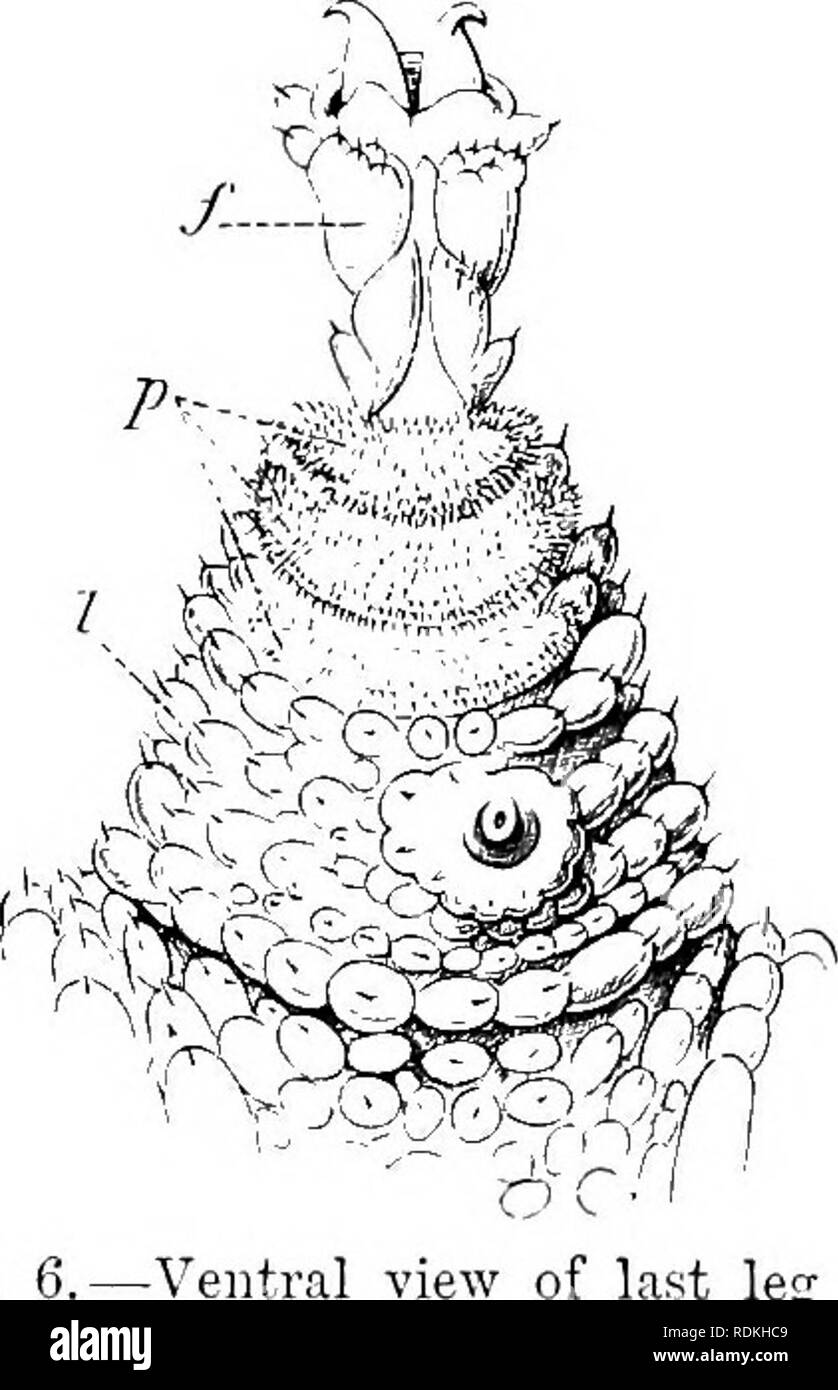 . The Cambridge natural history. Zoology. PERIPATUS ducts of the slime-glands open at their free e)id. They possess two main rings of projecting tissue, and their extremities bear papillae irregularly arranged. The ambulatory appendages vary in number. There are seventeen pairs in P. cafensis and eighteen in F. Bcdfoim'i, while in P. Pdicardsii the number varies from twenty-nine to thirty-four pairs. They consist of two main divisions, which we may call the leg and the foot (Figs. 6 and 7). The leg (l) has the form of a truncated cone, the broad end of which is attached to the ventro-lateral w Stock Photohttps://www.alamy.com/image-license-details/?v=1https://www.alamy.com/the-cambridge-natural-history-zoology-peripatus-ducts-of-the-slime-glands-open-at-their-free-eid-they-possess-two-main-rings-of-projecting-tissue-and-their-extremities-bear-papillae-irregularly-arranged-the-ambulatory-appendages-vary-in-number-there-are-seventeen-pairs-in-p-cafensis-and-eighteen-in-f-bcdfoimi-while-in-p-pdicardsii-the-number-varies-from-twenty-nine-to-thirty-four-pairs-they-consist-of-two-main-divisions-which-we-may-call-the-leg-and-the-foot-figs-6-and-7-the-leg-l-has-the-form-of-a-truncated-cone-the-broad-end-of-which-is-attached-to-the-ventro-lateral-w-image232156073.html
. The Cambridge natural history. Zoology. PERIPATUS ducts of the slime-glands open at their free e)id. They possess two main rings of projecting tissue, and their extremities bear papillae irregularly arranged. The ambulatory appendages vary in number. There are seventeen pairs in P. cafensis and eighteen in F. Bcdfoim'i, while in P. Pdicardsii the number varies from twenty-nine to thirty-four pairs. They consist of two main divisions, which we may call the leg and the foot (Figs. 6 and 7). The leg (l) has the form of a truncated cone, the broad end of which is attached to the ventro-lateral w Stock Photohttps://www.alamy.com/image-license-details/?v=1https://www.alamy.com/the-cambridge-natural-history-zoology-peripatus-ducts-of-the-slime-glands-open-at-their-free-eid-they-possess-two-main-rings-of-projecting-tissue-and-their-extremities-bear-papillae-irregularly-arranged-the-ambulatory-appendages-vary-in-number-there-are-seventeen-pairs-in-p-cafensis-and-eighteen-in-f-bcdfoimi-while-in-p-pdicardsii-the-number-varies-from-twenty-nine-to-thirty-four-pairs-they-consist-of-two-main-divisions-which-we-may-call-the-leg-and-the-foot-figs-6-and-7-the-leg-l-has-the-form-of-a-truncated-cone-the-broad-end-of-which-is-attached-to-the-ventro-lateral-w-image232156073.htmlRMRDKHC9–. The Cambridge natural history. Zoology. PERIPATUS ducts of the slime-glands open at their free e)id. They possess two main rings of projecting tissue, and their extremities bear papillae irregularly arranged. The ambulatory appendages vary in number. There are seventeen pairs in P. cafensis and eighteen in F. Bcdfoim'i, while in P. Pdicardsii the number varies from twenty-nine to thirty-four pairs. They consist of two main divisions, which we may call the leg and the foot (Figs. 6 and 7). The leg (l) has the form of a truncated cone, the broad end of which is attached to the ventro-lateral w
 . Fresh-water biology. Freshwater biology. i68 FRESH-WATER BIOLOGY 233 (220) Chromatophore a single equatorial band, with one pyrenoid. Fila- ments branched, attached, frequently with a gelatinous cov- ering. Reproduction by zoospores and isogametes. Family Chaetophoeaceae . 234 234 (242) The zoosporangia of the same form as the vegetative cells; the larger species usually bearing long hairs. Subfamily Cha'etophoreae . 235 ^iS (239) Plant attached, differentiated into base and apex 236 236 (237, 238) Filaments imbedded in a firm, gelatinous matrix, forming a spherical or an irregularly branche Stock Photohttps://www.alamy.com/image-license-details/?v=1https://www.alamy.com/fresh-water-biology-freshwater-biology-i68-fresh-water-biology-233-220-chromatophore-a-single-equatorial-band-with-one-pyrenoid-fila-ments-branched-attached-frequently-with-a-gelatinous-cov-ering-reproduction-by-zoospores-and-isogametes-family-chaetophoeaceae-234-234-242-the-zoosporangia-of-the-same-form-as-the-vegetative-cells-the-larger-species-usually-bearing-long-hairs-subfamily-chaetophoreae-235-is-239-plant-attached-differentiated-into-base-and-apex-236-236-237-238-filaments-imbedded-in-a-firm-gelatinous-matrix-forming-a-spherical-or-an-irregularly-branche-image231972462.html
. Fresh-water biology. Freshwater biology. i68 FRESH-WATER BIOLOGY 233 (220) Chromatophore a single equatorial band, with one pyrenoid. Fila- ments branched, attached, frequently with a gelatinous cov- ering. Reproduction by zoospores and isogametes. Family Chaetophoeaceae . 234 234 (242) The zoosporangia of the same form as the vegetative cells; the larger species usually bearing long hairs. Subfamily Cha'etophoreae . 235 ^iS (239) Plant attached, differentiated into base and apex 236 236 (237, 238) Filaments imbedded in a firm, gelatinous matrix, forming a spherical or an irregularly branche Stock Photohttps://www.alamy.com/image-license-details/?v=1https://www.alamy.com/fresh-water-biology-freshwater-biology-i68-fresh-water-biology-233-220-chromatophore-a-single-equatorial-band-with-one-pyrenoid-fila-ments-branched-attached-frequently-with-a-gelatinous-cov-ering-reproduction-by-zoospores-and-isogametes-family-chaetophoeaceae-234-234-242-the-zoosporangia-of-the-same-form-as-the-vegetative-cells-the-larger-species-usually-bearing-long-hairs-subfamily-chaetophoreae-235-is-239-plant-attached-differentiated-into-base-and-apex-236-236-237-238-filaments-imbedded-in-a-firm-gelatinous-matrix-forming-a-spherical-or-an-irregularly-branche-image231972462.htmlRMRDB76P–. Fresh-water biology. Freshwater biology. i68 FRESH-WATER BIOLOGY 233 (220) Chromatophore a single equatorial band, with one pyrenoid. Fila- ments branched, attached, frequently with a gelatinous cov- ering. Reproduction by zoospores and isogametes. Family Chaetophoeaceae . 234 234 (242) The zoosporangia of the same form as the vegetative cells; the larger species usually bearing long hairs. Subfamily Cha'etophoreae . 235 ^iS (239) Plant attached, differentiated into base and apex 236 236 (237, 238) Filaments imbedded in a firm, gelatinous matrix, forming a spherical or an irregularly branche
 . Fresh-water biology. Freshwater biology. 220 (211) With a lorica 221 221 (224) Lorica sessile 222 222 (223) Usually cup-shaped or subspherical; tentacles suctorial, sometimes in groups. . Solenophrya Claparede and Lachmann. Representative species Solenophrya pera Stokes 1885. Lorica irregularly cubical or satchel-shaped, hyaline, widest at the base of attachment, narrowing anteriorly, witli the sides somewhat concave. Zooid oval, not attached to bottom of lorica. Tentacles arising from the entire frontal border. Two individuals often in the same lorica. Height of lorica 40 /x. Width and leng Stock Photohttps://www.alamy.com/image-license-details/?v=1https://www.alamy.com/fresh-water-biology-freshwater-biology-220-211-with-a-lorica-221-221-224-lorica-sessile-222-222-223-usually-cup-shaped-or-subspherical-tentacles-suctorial-sometimes-in-groups-solenophrya-claparede-and-lachmann-representative-species-solenophrya-pera-stokes-1885-lorica-irregularly-cubical-or-satchel-shaped-hyaline-widest-at-the-base-of-attachment-narrowing-anteriorly-witli-the-sides-somewhat-concave-zooid-oval-not-attached-to-bottom-of-lorica-tentacles-arising-from-the-entire-frontal-border-two-individuals-often-in-the-same-lorica-height-of-lorica-40-x-width-and-leng-image231908735.html
. Fresh-water biology. Freshwater biology. 220 (211) With a lorica 221 221 (224) Lorica sessile 222 222 (223) Usually cup-shaped or subspherical; tentacles suctorial, sometimes in groups. . Solenophrya Claparede and Lachmann. Representative species Solenophrya pera Stokes 1885. Lorica irregularly cubical or satchel-shaped, hyaline, widest at the base of attachment, narrowing anteriorly, witli the sides somewhat concave. Zooid oval, not attached to bottom of lorica. Tentacles arising from the entire frontal border. Two individuals often in the same lorica. Height of lorica 40 /x. Width and leng Stock Photohttps://www.alamy.com/image-license-details/?v=1https://www.alamy.com/fresh-water-biology-freshwater-biology-220-211-with-a-lorica-221-221-224-lorica-sessile-222-222-223-usually-cup-shaped-or-subspherical-tentacles-suctorial-sometimes-in-groups-solenophrya-claparede-and-lachmann-representative-species-solenophrya-pera-stokes-1885-lorica-irregularly-cubical-or-satchel-shaped-hyaline-widest-at-the-base-of-attachment-narrowing-anteriorly-witli-the-sides-somewhat-concave-zooid-oval-not-attached-to-bottom-of-lorica-tentacles-arising-from-the-entire-frontal-border-two-individuals-often-in-the-same-lorica-height-of-lorica-40-x-width-and-leng-image231908735.htmlRMRD89XR–. Fresh-water biology. Freshwater biology. 220 (211) With a lorica 221 221 (224) Lorica sessile 222 222 (223) Usually cup-shaped or subspherical; tentacles suctorial, sometimes in groups. . Solenophrya Claparede and Lachmann. Representative species Solenophrya pera Stokes 1885. Lorica irregularly cubical or satchel-shaped, hyaline, widest at the base of attachment, narrowing anteriorly, witli the sides somewhat concave. Zooid oval, not attached to bottom of lorica. Tentacles arising from the entire frontal border. Two individuals often in the same lorica. Height of lorica 40 /x. Width and leng
 . Bulletin of the Museum of Comparative Zoology at Harvard College. Zoology. 456 bulletin: museum of comparative zoology Posterior male organs (fig. 10). A pair of euprostates pass from the medio-ventral male pore first sideways, then upwards and backwards through 3 or more (till 7) segments. Their glandular, ental part (eu) is sausage-shaped, about 11 mm. in length and at the ectal end ca 0.9 mm. thick, entalwards slightly diminishing in thickness, simply and more or less irregularly bent, closely attached to the intestine. Its wall is rather thick, consisting principally of long, slender, gl Stock Photohttps://www.alamy.com/image-license-details/?v=1https://www.alamy.com/bulletin-of-the-museum-of-comparative-zoology-at-harvard-college-zoology-456-bulletin-museum-of-comparative-zoology-posterior-male-organs-fig-10-a-pair-of-euprostates-pass-from-the-medio-ventral-male-pore-first-sideways-then-upwards-and-backwards-through-3-or-more-till-7-segments-their-glandular-ental-part-eu-is-sausage-shaped-about-11-mm-in-length-and-at-the-ectal-end-ca-09-mm-thick-entalwards-slightly-diminishing-in-thickness-simply-and-more-or-less-irregularly-bent-closely-attached-to-the-intestine-its-wall-is-rather-thick-consisting-principally-of-long-slender-gl-image233914969.html
. Bulletin of the Museum of Comparative Zoology at Harvard College. Zoology. 456 bulletin: museum of comparative zoology Posterior male organs (fig. 10). A pair of euprostates pass from the medio-ventral male pore first sideways, then upwards and backwards through 3 or more (till 7) segments. Their glandular, ental part (eu) is sausage-shaped, about 11 mm. in length and at the ectal end ca 0.9 mm. thick, entalwards slightly diminishing in thickness, simply and more or less irregularly bent, closely attached to the intestine. Its wall is rather thick, consisting principally of long, slender, gl Stock Photohttps://www.alamy.com/image-license-details/?v=1https://www.alamy.com/bulletin-of-the-museum-of-comparative-zoology-at-harvard-college-zoology-456-bulletin-museum-of-comparative-zoology-posterior-male-organs-fig-10-a-pair-of-euprostates-pass-from-the-medio-ventral-male-pore-first-sideways-then-upwards-and-backwards-through-3-or-more-till-7-segments-their-glandular-ental-part-eu-is-sausage-shaped-about-11-mm-in-length-and-at-the-ectal-end-ca-09-mm-thick-entalwards-slightly-diminishing-in-thickness-simply-and-more-or-less-irregularly-bent-closely-attached-to-the-intestine-its-wall-is-rather-thick-consisting-principally-of-long-slender-gl-image233914969.htmlRMRGFMX1–. Bulletin of the Museum of Comparative Zoology at Harvard College. Zoology. 456 bulletin: museum of comparative zoology Posterior male organs (fig. 10). A pair of euprostates pass from the medio-ventral male pore first sideways, then upwards and backwards through 3 or more (till 7) segments. Their glandular, ental part (eu) is sausage-shaped, about 11 mm. in length and at the ectal end ca 0.9 mm. thick, entalwards slightly diminishing in thickness, simply and more or less irregularly bent, closely attached to the intestine. Its wall is rather thick, consisting principally of long, slender, gl
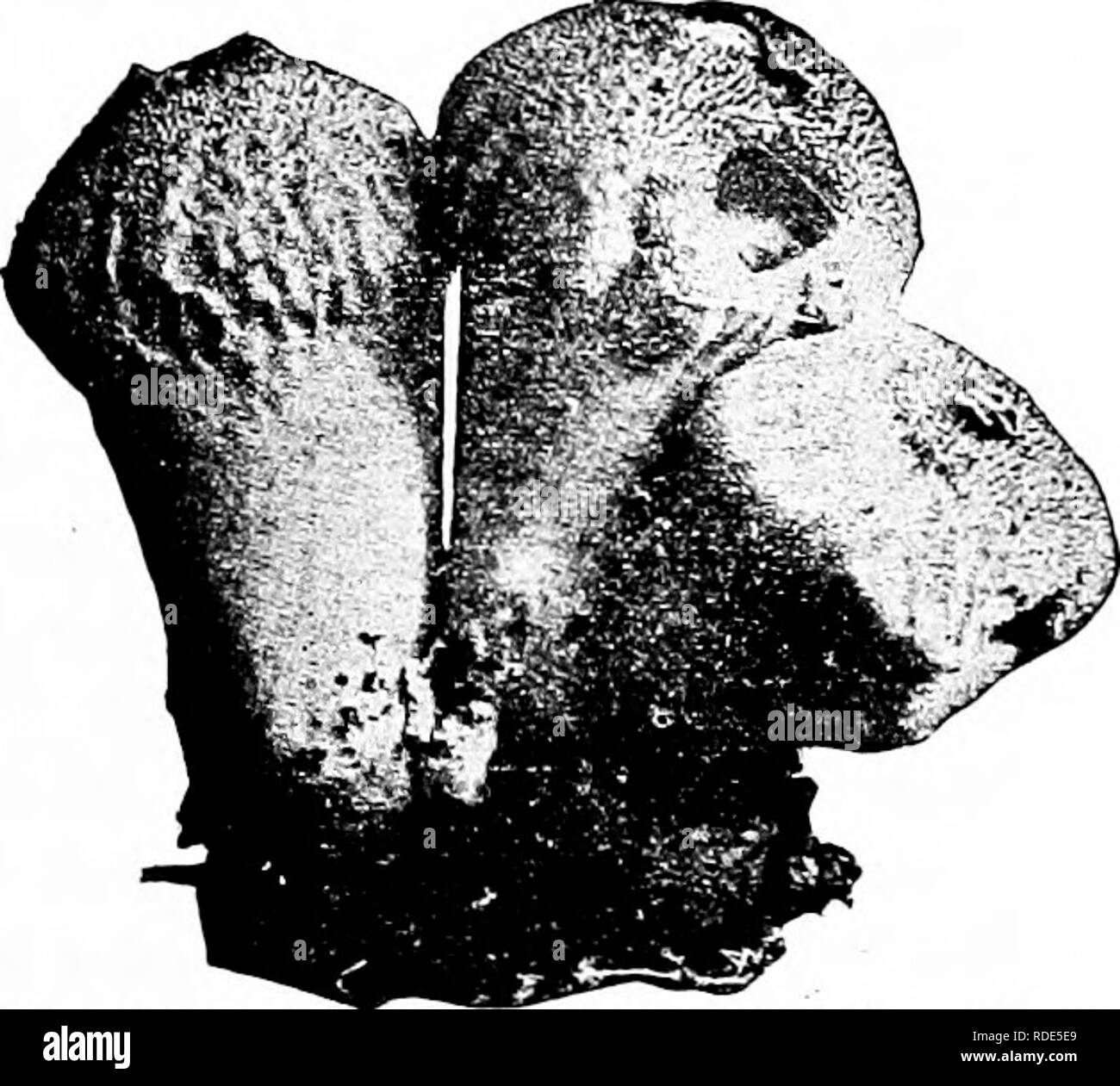 . The fungi which cause plant disease . Plant diseases; Fungi. THE FUNGI WHICH CAUSE PLANT DISEASE 465 Sporophore with a pronounced sterile persistent base Sporopliorc witliout a pronounced sterile base Inner peridium opening irregularly. Inner peridium opening by a basal pore, the outer peridium break- ing equatorially and the upper half with the attached inner peridium forcefully ejected Capillitium free, short-branched ynth pointed ends Sporophore with a pronounced per- sistent sterile base 4. Sporophore without a pronounced sterile base Inner peridium paperj', opening by an apical mouth 5. Stock Photohttps://www.alamy.com/image-license-details/?v=1https://www.alamy.com/the-fungi-which-cause-plant-disease-plant-diseases-fungi-the-fungi-which-cause-plant-disease-465-sporophore-with-a-pronounced-sterile-persistent-base-sporopliorc-witliout-a-pronounced-sterile-base-inner-peridium-opening-irregularly-inner-peridium-opening-by-a-basal-pore-the-outer-peridium-break-ing-equatorially-and-the-upper-half-with-the-attached-inner-peridium-forcefully-ejected-capillitium-free-short-branched-ynth-pointed-ends-sporophore-with-a-pronounced-per-sistent-sterile-base-4-sporophore-without-a-pronounced-sterile-base-inner-peridium-paperj-opening-by-an-apical-mouth-5-image232036961.html
. The fungi which cause plant disease . Plant diseases; Fungi. THE FUNGI WHICH CAUSE PLANT DISEASE 465 Sporophore with a pronounced sterile persistent base Sporopliorc witliout a pronounced sterile base Inner peridium opening irregularly. Inner peridium opening by a basal pore, the outer peridium break- ing equatorially and the upper half with the attached inner peridium forcefully ejected Capillitium free, short-branched ynth pointed ends Sporophore with a pronounced per- sistent sterile base 4. Sporophore without a pronounced sterile base Inner peridium paperj', opening by an apical mouth 5. Stock Photohttps://www.alamy.com/image-license-details/?v=1https://www.alamy.com/the-fungi-which-cause-plant-disease-plant-diseases-fungi-the-fungi-which-cause-plant-disease-465-sporophore-with-a-pronounced-sterile-persistent-base-sporopliorc-witliout-a-pronounced-sterile-base-inner-peridium-opening-irregularly-inner-peridium-opening-by-a-basal-pore-the-outer-peridium-break-ing-equatorially-and-the-upper-half-with-the-attached-inner-peridium-forcefully-ejected-capillitium-free-short-branched-ynth-pointed-ends-sporophore-with-a-pronounced-per-sistent-sterile-base-4-sporophore-without-a-pronounced-sterile-base-inner-peridium-paperj-opening-by-an-apical-mouth-5-image232036961.htmlRMRDE5E9–. The fungi which cause plant disease . Plant diseases; Fungi. THE FUNGI WHICH CAUSE PLANT DISEASE 465 Sporophore with a pronounced sterile persistent base Sporopliorc witliout a pronounced sterile base Inner peridium opening irregularly. Inner peridium opening by a basal pore, the outer peridium break- ing equatorially and the upper half with the attached inner peridium forcefully ejected Capillitium free, short-branched ynth pointed ends Sporophore with a pronounced per- sistent sterile base 4. Sporophore without a pronounced sterile base Inner peridium paperj', opening by an apical mouth 5.
 . A cytological study of haploid Crepis capillaris plants. Karyokinesis; Crepis. 114 University of California Publications in Agricultural Sciences [Vol. 6 and later figures show, division of the chromosomes within a cell does not always proceed synchronously. Usually, however, the divi- sion begins later, and the chromosomes in the shape of attached twin spheres pass irregularly to the poles (fig. 5, b, c) or one may be left out of the spindle and fail to reach a pole, giving rise to three iso-. Please note that these images are extracted from scanned page images that may have been digitally Stock Photohttps://www.alamy.com/image-license-details/?v=1https://www.alamy.com/a-cytological-study-of-haploid-crepis-capillaris-plants-karyokinesis-crepis-114-university-of-california-publications-in-agricultural-sciences-vol-6-and-later-figures-show-division-of-the-chromosomes-within-a-cell-does-not-always-proceed-synchronously-usually-however-the-divi-sion-begins-later-and-the-chromosomes-in-the-shape-of-attached-twin-spheres-pass-irregularly-to-the-poles-fig-5-b-c-or-one-may-be-left-out-of-the-spindle-and-fail-to-reach-a-pole-giving-rise-to-three-iso-please-note-that-these-images-are-extracted-from-scanned-page-images-that-may-have-been-digitally-image231778286.html
. A cytological study of haploid Crepis capillaris plants. Karyokinesis; Crepis. 114 University of California Publications in Agricultural Sciences [Vol. 6 and later figures show, division of the chromosomes within a cell does not always proceed synchronously. Usually, however, the divi- sion begins later, and the chromosomes in the shape of attached twin spheres pass irregularly to the poles (fig. 5, b, c) or one may be left out of the spindle and fail to reach a pole, giving rise to three iso-. Please note that these images are extracted from scanned page images that may have been digitally Stock Photohttps://www.alamy.com/image-license-details/?v=1https://www.alamy.com/a-cytological-study-of-haploid-crepis-capillaris-plants-karyokinesis-crepis-114-university-of-california-publications-in-agricultural-sciences-vol-6-and-later-figures-show-division-of-the-chromosomes-within-a-cell-does-not-always-proceed-synchronously-usually-however-the-divi-sion-begins-later-and-the-chromosomes-in-the-shape-of-attached-twin-spheres-pass-irregularly-to-the-poles-fig-5-b-c-or-one-may-be-left-out-of-the-spindle-and-fail-to-reach-a-pole-giving-rise-to-three-iso-please-note-that-these-images-are-extracted-from-scanned-page-images-that-may-have-been-digitally-image231778286.htmlRMRD2BFX–. A cytological study of haploid Crepis capillaris plants. Karyokinesis; Crepis. 114 University of California Publications in Agricultural Sciences [Vol. 6 and later figures show, division of the chromosomes within a cell does not always proceed synchronously. Usually, however, the divi- sion begins later, and the chromosomes in the shape of attached twin spheres pass irregularly to the poles (fig. 5, b, c) or one may be left out of the spindle and fail to reach a pole, giving rise to three iso-. Please note that these images are extracted from scanned page images that may have been digitally
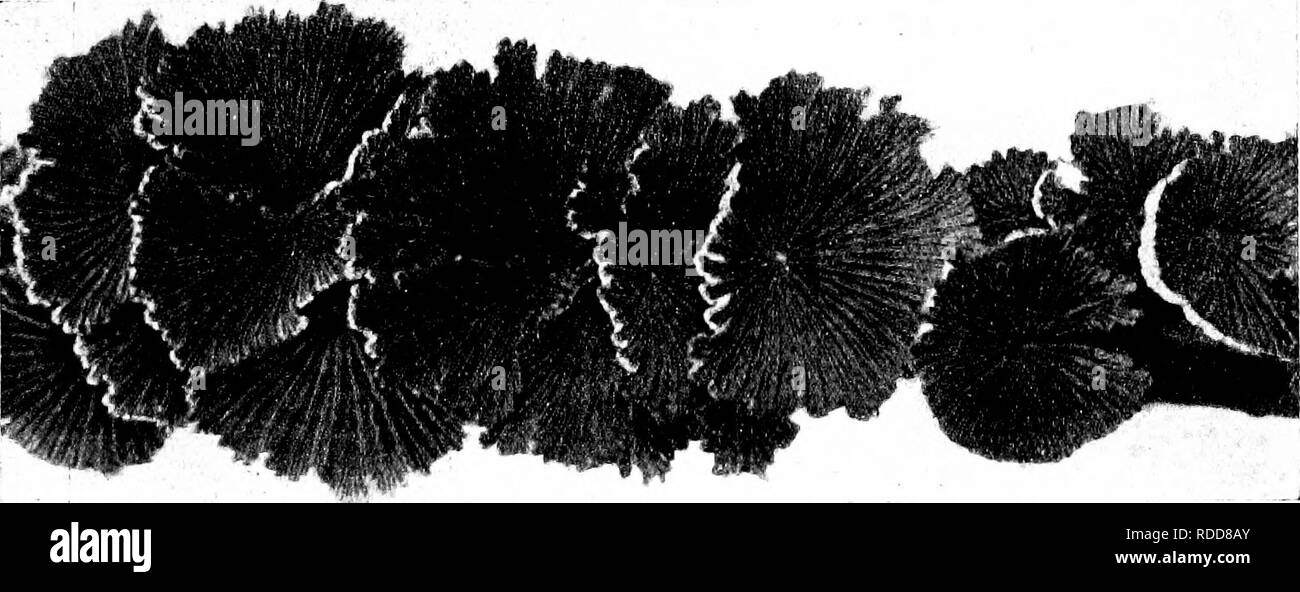 . Minnesota mushrooms ... Botany; Mushrooms. GILL FUNGI 51 SCHIZOPHYLLUJI Characterized by the two-forked edge of the gills, and the upturned woolly cap. Growing on wood ; not poisonous, but too tougli to be of value. Tlie name refers to the forked gills. Schizophyllum commune Fork Gill Cap 1-4 cm. wide, white- or gray-woolly, upturned, attached excentrically, irregularly saucer-shaped; stem lacking; gills grayish to purplish; spores subglobose, l-S/j.. The name refers to the frequence of the plant. Everywhere on dead or dying twigs and trunks, in forest, orchard, etc. ; not edible.. Figure 29 Stock Photohttps://www.alamy.com/image-license-details/?v=1https://www.alamy.com/minnesota-mushrooms-botany-mushrooms-gill-fungi-51-schizophylluji-characterized-by-the-two-forked-edge-of-the-gills-and-the-upturned-woolly-cap-growing-on-wood-not-poisonous-but-too-tougli-to-be-of-value-tlie-name-refers-to-the-forked-gills-schizophyllum-commune-fork-gill-cap-1-4-cm-wide-white-or-gray-woolly-upturned-attached-excentrically-irregularly-saucer-shaped-stem-lacking-gills-grayish-to-purplish-spores-subglobose-l-sj-the-name-refers-to-the-frequence-of-the-plant-everywhere-on-dead-or-dying-twigs-and-trunks-in-forest-orchard-etc-not-edible-figure-29-image232017267.html
. Minnesota mushrooms ... Botany; Mushrooms. GILL FUNGI 51 SCHIZOPHYLLUJI Characterized by the two-forked edge of the gills, and the upturned woolly cap. Growing on wood ; not poisonous, but too tougli to be of value. Tlie name refers to the forked gills. Schizophyllum commune Fork Gill Cap 1-4 cm. wide, white- or gray-woolly, upturned, attached excentrically, irregularly saucer-shaped; stem lacking; gills grayish to purplish; spores subglobose, l-S/j.. The name refers to the frequence of the plant. Everywhere on dead or dying twigs and trunks, in forest, orchard, etc. ; not edible.. Figure 29 Stock Photohttps://www.alamy.com/image-license-details/?v=1https://www.alamy.com/minnesota-mushrooms-botany-mushrooms-gill-fungi-51-schizophylluji-characterized-by-the-two-forked-edge-of-the-gills-and-the-upturned-woolly-cap-growing-on-wood-not-poisonous-but-too-tougli-to-be-of-value-tlie-name-refers-to-the-forked-gills-schizophyllum-commune-fork-gill-cap-1-4-cm-wide-white-or-gray-woolly-upturned-attached-excentrically-irregularly-saucer-shaped-stem-lacking-gills-grayish-to-purplish-spores-subglobose-l-sj-the-name-refers-to-the-frequence-of-the-plant-everywhere-on-dead-or-dying-twigs-and-trunks-in-forest-orchard-etc-not-edible-figure-29-image232017267.htmlRMRDD8AY–. Minnesota mushrooms ... Botany; Mushrooms. GILL FUNGI 51 SCHIZOPHYLLUJI Characterized by the two-forked edge of the gills, and the upturned woolly cap. Growing on wood ; not poisonous, but too tougli to be of value. Tlie name refers to the forked gills. Schizophyllum commune Fork Gill Cap 1-4 cm. wide, white- or gray-woolly, upturned, attached excentrically, irregularly saucer-shaped; stem lacking; gills grayish to purplish; spores subglobose, l-S/j.. The name refers to the frequence of the plant. Everywhere on dead or dying twigs and trunks, in forest, orchard, etc. ; not edible.. Figure 29
 . Bulletin - United States National Museum. Science. Fig. 158.—Trematopoea primigenia. a to c, three fragments, natural size; d, base of a zoarium, LIFE size; e, surface of a typical example, X9, showing the peristome; /, SURFACE OF ANOTHER SPECIMEN, XlS, WITH NUMEROUS ACANTHOPORES AND OPEN MESOPORES; g, THE USUAL APPEARANCE IN TANGENTIAL SECTION, X18; h, SEVERAL ZOCECIA OF THE SAME SECTION, X50; i, VERTICAL SECTION, X18, THROUGH A BASAL EXPANSION ATTACHED TO A CRESTOID COLUMN. BLACK RlVEE (DECORAH) SHALE, Minneapolis, Minnesota. (After Ulrich.) by a series of unequal and irregularly shaped me Stock Photohttps://www.alamy.com/image-license-details/?v=1https://www.alamy.com/bulletin-united-states-national-museum-science-fig-158trematopoea-primigenia-a-to-c-three-fragments-natural-size-d-base-of-a-zoarium-life-size-e-surface-of-a-typical-example-x9-showing-the-peristome-surface-of-another-specimen-xls-with-numerous-acanthopores-and-open-mesopores-g-the-usual-appearance-in-tangential-section-x18-h-several-zocecia-of-the-same-section-x50-i-vertical-section-x18-through-a-basal-expansion-attached-to-a-crestoid-column-black-rlvee-decorah-shale-minneapolis-minnesota-after-ulrich-by-a-series-of-unequal-and-irregularly-shaped-me-image233752613.html
. Bulletin - United States National Museum. Science. Fig. 158.—Trematopoea primigenia. a to c, three fragments, natural size; d, base of a zoarium, LIFE size; e, surface of a typical example, X9, showing the peristome; /, SURFACE OF ANOTHER SPECIMEN, XlS, WITH NUMEROUS ACANTHOPORES AND OPEN MESOPORES; g, THE USUAL APPEARANCE IN TANGENTIAL SECTION, X18; h, SEVERAL ZOCECIA OF THE SAME SECTION, X50; i, VERTICAL SECTION, X18, THROUGH A BASAL EXPANSION ATTACHED TO A CRESTOID COLUMN. BLACK RlVEE (DECORAH) SHALE, Minneapolis, Minnesota. (After Ulrich.) by a series of unequal and irregularly shaped me Stock Photohttps://www.alamy.com/image-license-details/?v=1https://www.alamy.com/bulletin-united-states-national-museum-science-fig-158trematopoea-primigenia-a-to-c-three-fragments-natural-size-d-base-of-a-zoarium-life-size-e-surface-of-a-typical-example-x9-showing-the-peristome-surface-of-another-specimen-xls-with-numerous-acanthopores-and-open-mesopores-g-the-usual-appearance-in-tangential-section-x18-h-several-zocecia-of-the-same-section-x50-i-vertical-section-x18-through-a-basal-expansion-attached-to-a-crestoid-column-black-rlvee-decorah-shale-minneapolis-minnesota-after-ulrich-by-a-series-of-unequal-and-irregularly-shaped-me-image233752613.htmlRMRG89RH–. Bulletin - United States National Museum. Science. Fig. 158.—Trematopoea primigenia. a to c, three fragments, natural size; d, base of a zoarium, LIFE size; e, surface of a typical example, X9, showing the peristome; /, SURFACE OF ANOTHER SPECIMEN, XlS, WITH NUMEROUS ACANTHOPORES AND OPEN MESOPORES; g, THE USUAL APPEARANCE IN TANGENTIAL SECTION, X18; h, SEVERAL ZOCECIA OF THE SAME SECTION, X50; i, VERTICAL SECTION, X18, THROUGH A BASAL EXPANSION ATTACHED TO A CRESTOID COLUMN. BLACK RlVEE (DECORAH) SHALE, Minneapolis, Minnesota. (After Ulrich.) by a series of unequal and irregularly shaped me
 . Annual report of the Regents. New York State Museum; Science. 594 Report of the State Geologist. ' Sphragiopoka, Ulrich. (Geol. Sur. 111., Yol. YIII, p. 398. 1890.) Type, Sjphragiojpora jparasitica, Ulrich. Zoarium a small discoidal body attached to other objects; upper surface flat or a little concave; cell apertures disposed in an irregularly radial manner from the center, on the summits of from six to nine more or less elevated ridges; at first they form only single rows, but at the outer margin the arrangement is biserial. 196. Fig. 196. Sphragioporaparasitica. A frond, xl8. Family Tubul Stock Photohttps://www.alamy.com/image-license-details/?v=1https://www.alamy.com/annual-report-of-the-regents-new-york-state-museum-science-594-report-of-the-state-geologist-sphragiopoka-ulrich-geol-sur-111-yol-yiii-p-398-1890-type-sjphragiojpora-jparasitica-ulrich-zoarium-a-small-discoidal-body-attached-to-other-objects-upper-surface-flat-or-a-little-concave-cell-apertures-disposed-in-an-irregularly-radial-manner-from-the-center-on-the-summits-of-from-six-to-nine-more-or-less-elevated-ridges-at-first-they-form-only-single-rows-but-at-the-outer-margin-the-arrangement-is-biserial-196-fig-196-sphragioporaparasitica-a-frond-xl8-family-tubul-image236160129.html
. Annual report of the Regents. New York State Museum; Science. 594 Report of the State Geologist. ' Sphragiopoka, Ulrich. (Geol. Sur. 111., Yol. YIII, p. 398. 1890.) Type, Sjphragiojpora jparasitica, Ulrich. Zoarium a small discoidal body attached to other objects; upper surface flat or a little concave; cell apertures disposed in an irregularly radial manner from the center, on the summits of from six to nine more or less elevated ridges; at first they form only single rows, but at the outer margin the arrangement is biserial. 196. Fig. 196. Sphragioporaparasitica. A frond, xl8. Family Tubul Stock Photohttps://www.alamy.com/image-license-details/?v=1https://www.alamy.com/annual-report-of-the-regents-new-york-state-museum-science-594-report-of-the-state-geologist-sphragiopoka-ulrich-geol-sur-111-yol-yiii-p-398-1890-type-sjphragiojpora-jparasitica-ulrich-zoarium-a-small-discoidal-body-attached-to-other-objects-upper-surface-flat-or-a-little-concave-cell-apertures-disposed-in-an-irregularly-radial-manner-from-the-center-on-the-summits-of-from-six-to-nine-more-or-less-elevated-ridges-at-first-they-form-only-single-rows-but-at-the-outer-margin-the-arrangement-is-biserial-196-fig-196-sphragioporaparasitica-a-frond-xl8-family-tubul-image236160129.htmlRMRM60J9–. Annual report of the Regents. New York State Museum; Science. 594 Report of the State Geologist. ' Sphragiopoka, Ulrich. (Geol. Sur. 111., Yol. YIII, p. 398. 1890.) Type, Sjphragiojpora jparasitica, Ulrich. Zoarium a small discoidal body attached to other objects; upper surface flat or a little concave; cell apertures disposed in an irregularly radial manner from the center, on the summits of from six to nine more or less elevated ridges; at first they form only single rows, but at the outer margin the arrangement is biserial. 196. Fig. 196. Sphragioporaparasitica. A frond, xl8. Family Tubul
 . Bulletin - United States National Museum. Science. ASCIDIANS OF THE PHILIPPINES VAN NAME. 167 AMAROUCIUM CONSTRICTUM Sluiter, 1900. 1900. Amaroucium constrictum Sluiteb, Zool. Jahrbiicher, Syst., vol. 13, p. 17. pi. 1, fig. 8a. 1909. Amaroucium constrictum Habtjieyeb, Broun's Tier-reich, vol. 3, suppl., p. 1466. Colony in the only specimen irregularly capitate, attached by a narrowed base. Test yellowish white, translucent, moderately firm, the brownish zooids visible through it indistinctly. Height about 12 mm.; greatest diameter of head, about 8 mm. Zooids small; in none of them is the pos Stock Photohttps://www.alamy.com/image-license-details/?v=1https://www.alamy.com/bulletin-united-states-national-museum-science-ascidians-of-the-philippines-van-name-167-amaroucium-constrictum-sluiter-1900-1900-amaroucium-constrictum-sluiteb-zool-jahrbiicher-syst-vol-13-p-17-pi-1-fig-8a-1909-amaroucium-constrictum-habtjieyeb-brouns-tier-reich-vol-3-suppl-p-1466-colony-in-the-only-specimen-irregularly-capitate-attached-by-a-narrowed-base-test-yellowish-white-translucent-moderately-firm-the-brownish-zooids-visible-through-it-indistinctly-height-about-12-mm-greatest-diameter-of-head-about-8-mm-zooids-small-in-none-of-them-is-the-pos-image233727724.html
. Bulletin - United States National Museum. Science. ASCIDIANS OF THE PHILIPPINES VAN NAME. 167 AMAROUCIUM CONSTRICTUM Sluiter, 1900. 1900. Amaroucium constrictum Sluiteb, Zool. Jahrbiicher, Syst., vol. 13, p. 17. pi. 1, fig. 8a. 1909. Amaroucium constrictum Habtjieyeb, Broun's Tier-reich, vol. 3, suppl., p. 1466. Colony in the only specimen irregularly capitate, attached by a narrowed base. Test yellowish white, translucent, moderately firm, the brownish zooids visible through it indistinctly. Height about 12 mm.; greatest diameter of head, about 8 mm. Zooids small; in none of them is the pos Stock Photohttps://www.alamy.com/image-license-details/?v=1https://www.alamy.com/bulletin-united-states-national-museum-science-ascidians-of-the-philippines-van-name-167-amaroucium-constrictum-sluiter-1900-1900-amaroucium-constrictum-sluiteb-zool-jahrbiicher-syst-vol-13-p-17-pi-1-fig-8a-1909-amaroucium-constrictum-habtjieyeb-brouns-tier-reich-vol-3-suppl-p-1466-colony-in-the-only-specimen-irregularly-capitate-attached-by-a-narrowed-base-test-yellowish-white-translucent-moderately-firm-the-brownish-zooids-visible-through-it-indistinctly-height-about-12-mm-greatest-diameter-of-head-about-8-mm-zooids-small-in-none-of-them-is-the-pos-image233727724.htmlRMRG762M–. Bulletin - United States National Museum. Science. ASCIDIANS OF THE PHILIPPINES VAN NAME. 167 AMAROUCIUM CONSTRICTUM Sluiter, 1900. 1900. Amaroucium constrictum Sluiteb, Zool. Jahrbiicher, Syst., vol. 13, p. 17. pi. 1, fig. 8a. 1909. Amaroucium constrictum Habtjieyeb, Broun's Tier-reich, vol. 3, suppl., p. 1466. Colony in the only specimen irregularly capitate, attached by a narrowed base. Test yellowish white, translucent, moderately firm, the brownish zooids visible through it indistinctly. Height about 12 mm.; greatest diameter of head, about 8 mm. Zooids small; in none of them is the pos
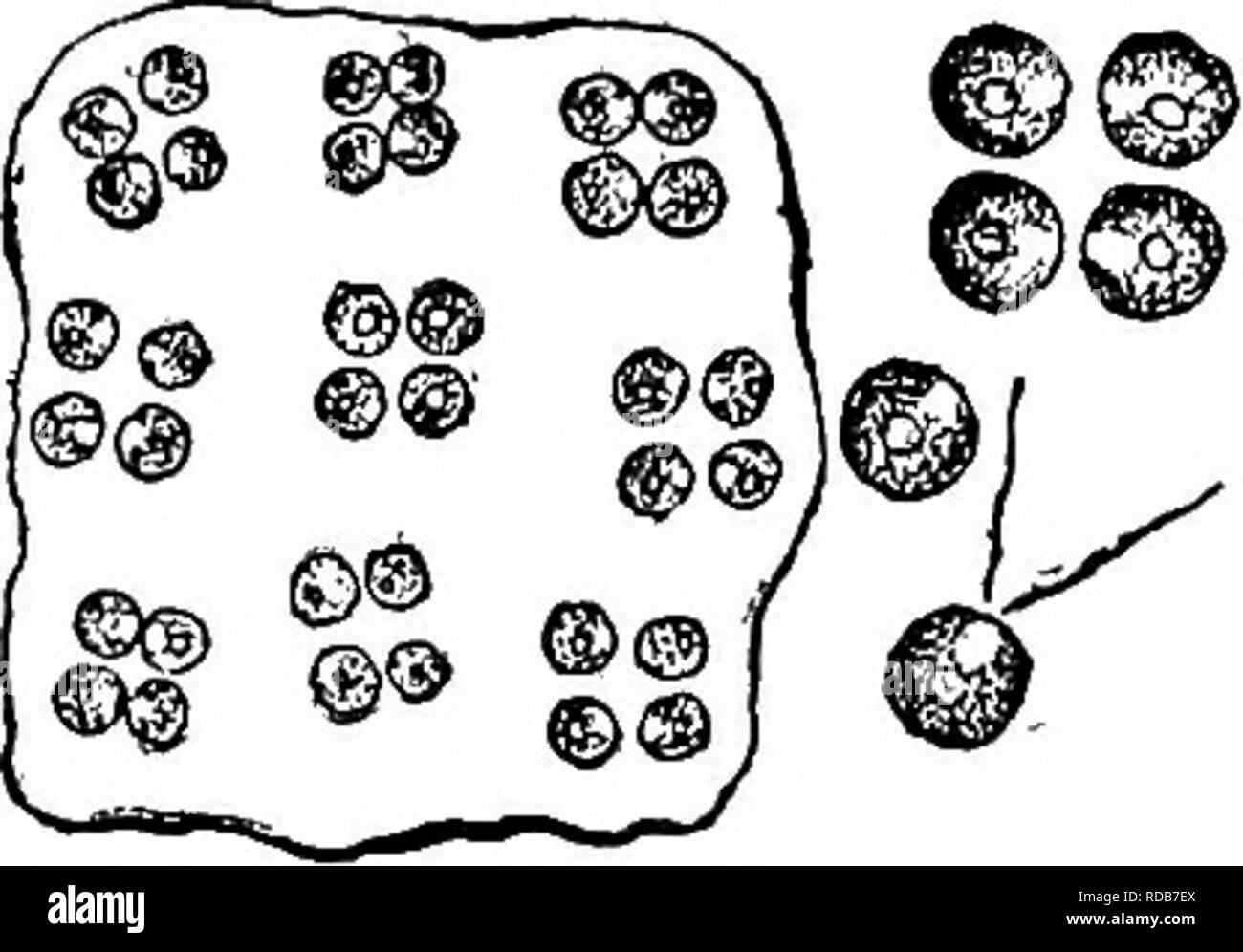 . Fresh-water biology. Freshwater biology. THE FRESH-WATER ALGAE 147 92 (93) Colonies macroscopic or microscopic, expanded or intestiform, cells arranged in fours Tetraspora Link. Reproduction by division in two directions; zoospores may originate directly from the vegetative cells, and by divi- sion give rise to a new colony; isogametes with two cilia may be formed, also resting spores with heavy brown walls. Fig. 153. Tetraspora explanata KUtzing. X 2So- (After Nageli.) 93 (92) Colonies pear-shaped, attached, cells irregularly placed near the surface Apiocystis Nageli.. Please note that thes Stock Photohttps://www.alamy.com/image-license-details/?v=1https://www.alamy.com/fresh-water-biology-freshwater-biology-the-fresh-water-algae-147-92-93-colonies-macroscopic-or-microscopic-expanded-or-intestiform-cells-arranged-in-fours-tetraspora-link-reproduction-by-division-in-two-directions-zoospores-may-originate-directly-from-the-vegetative-cells-and-by-divi-sion-give-rise-to-a-new-colony-isogametes-with-two-cilia-may-be-formed-also-resting-spores-with-heavy-brown-walls-fig-153-tetraspora-explanata-kutzing-x-2so-after-nageli-93-92-colonies-pear-shaped-attached-cells-irregularly-placed-near-the-surface-apiocystis-nageli-please-note-that-thes-image231972690.html
. Fresh-water biology. Freshwater biology. THE FRESH-WATER ALGAE 147 92 (93) Colonies macroscopic or microscopic, expanded or intestiform, cells arranged in fours Tetraspora Link. Reproduction by division in two directions; zoospores may originate directly from the vegetative cells, and by divi- sion give rise to a new colony; isogametes with two cilia may be formed, also resting spores with heavy brown walls. Fig. 153. Tetraspora explanata KUtzing. X 2So- (After Nageli.) 93 (92) Colonies pear-shaped, attached, cells irregularly placed near the surface Apiocystis Nageli.. Please note that thes Stock Photohttps://www.alamy.com/image-license-details/?v=1https://www.alamy.com/fresh-water-biology-freshwater-biology-the-fresh-water-algae-147-92-93-colonies-macroscopic-or-microscopic-expanded-or-intestiform-cells-arranged-in-fours-tetraspora-link-reproduction-by-division-in-two-directions-zoospores-may-originate-directly-from-the-vegetative-cells-and-by-divi-sion-give-rise-to-a-new-colony-isogametes-with-two-cilia-may-be-formed-also-resting-spores-with-heavy-brown-walls-fig-153-tetraspora-explanata-kutzing-x-2so-after-nageli-93-92-colonies-pear-shaped-attached-cells-irregularly-placed-near-the-surface-apiocystis-nageli-please-note-that-thes-image231972690.htmlRMRDB7EX–. Fresh-water biology. Freshwater biology. THE FRESH-WATER ALGAE 147 92 (93) Colonies macroscopic or microscopic, expanded or intestiform, cells arranged in fours Tetraspora Link. Reproduction by division in two directions; zoospores may originate directly from the vegetative cells, and by divi- sion give rise to a new colony; isogametes with two cilia may be formed, also resting spores with heavy brown walls. Fig. 153. Tetraspora explanata KUtzing. X 2So- (After Nageli.) 93 (92) Colonies pear-shaped, attached, cells irregularly placed near the surface Apiocystis Nageli.. Please note that thes
![. Illustrated key to the wild and commonly cultivated trees of the northeastern United States and adjacent Canada [microform] : based primarily upon leaf characters. Trees; Trees; Arbres; Arbres. KEY TO GENERA AXD SPECIES 47 in the mountains to Ga. (Fiji's. 78. 79.) Red Spruce, Yellow Spruce, Picca rubra (I)u Roi)-Dietr. 87. Leaves to ^ of an inch long. (mcs to i ^- inches long, remaining attached to the branch for many years; cone scales usually with the margin irregularly finely toothed (as if Fig. 78. Red Spruce.. Fig. 79. Kcd Spruce. gnawed). Tree of swamps or low lands, rarely on u Stock Photo . Illustrated key to the wild and commonly cultivated trees of the northeastern United States and adjacent Canada [microform] : based primarily upon leaf characters. Trees; Trees; Arbres; Arbres. KEY TO GENERA AXD SPECIES 47 in the mountains to Ga. (Fiji's. 78. 79.) Red Spruce, Yellow Spruce, Picca rubra (I)u Roi)-Dietr. 87. Leaves to ^ of an inch long. (mcs to i ^- inches long, remaining attached to the branch for many years; cone scales usually with the margin irregularly finely toothed (as if Fig. 78. Red Spruce.. Fig. 79. Kcd Spruce. gnawed). Tree of swamps or low lands, rarely on u Stock Photo](https://c8.alamy.com/comp/REMKDJ/illustrated-key-to-the-wild-and-commonly-cultivated-trees-of-the-northeastern-united-states-and-adjacent-canada-microform-based-primarily-upon-leaf-characters-trees-trees-arbres-arbres-key-to-genera-axd-species-47-in-the-mountains-to-ga-fijis-78-79-red-spruce-yellow-spruce-picca-rubra-iu-roi-dietr-87-leaves-to-of-an-inch-long-mcs-to-i-inches-long-remaining-attached-to-the-branch-for-many-years-cone-scales-usually-with-the-margin-irregularly-finely-toothed-as-if-fig-78-red-spruce-fig-79-kcd-spruce-gnawed-tree-of-swamps-or-low-lands-rarely-on-u-REMKDJ.jpg) . Illustrated key to the wild and commonly cultivated trees of the northeastern United States and adjacent Canada [microform] : based primarily upon leaf characters. Trees; Trees; Arbres; Arbres. KEY TO GENERA AXD SPECIES 47 in the mountains to Ga. (Fiji's. 78. 79.) Red Spruce, Yellow Spruce, Picca rubra (I)u Roi)-Dietr. 87. Leaves to ^ of an inch long. (mcs to i ^- inches long, remaining attached to the branch for many years; cone scales usually with the margin irregularly finely toothed (as if Fig. 78. Red Spruce.. Fig. 79. Kcd Spruce. gnawed). Tree of swamps or low lands, rarely on u Stock Photohttps://www.alamy.com/image-license-details/?v=1https://www.alamy.com/illustrated-key-to-the-wild-and-commonly-cultivated-trees-of-the-northeastern-united-states-and-adjacent-canada-microform-based-primarily-upon-leaf-characters-trees-trees-arbres-arbres-key-to-genera-axd-species-47-in-the-mountains-to-ga-fijis-78-79-red-spruce-yellow-spruce-picca-rubra-iu-roi-dietr-87-leaves-to-of-an-inch-long-mcs-to-i-inches-long-remaining-attached-to-the-branch-for-many-years-cone-scales-usually-with-the-margin-irregularly-finely-toothed-as-if-fig-78-red-spruce-fig-79-kcd-spruce-gnawed-tree-of-swamps-or-low-lands-rarely-on-u-image232794286.html
. Illustrated key to the wild and commonly cultivated trees of the northeastern United States and adjacent Canada [microform] : based primarily upon leaf characters. Trees; Trees; Arbres; Arbres. KEY TO GENERA AXD SPECIES 47 in the mountains to Ga. (Fiji's. 78. 79.) Red Spruce, Yellow Spruce, Picca rubra (I)u Roi)-Dietr. 87. Leaves to ^ of an inch long. (mcs to i ^- inches long, remaining attached to the branch for many years; cone scales usually with the margin irregularly finely toothed (as if Fig. 78. Red Spruce.. Fig. 79. Kcd Spruce. gnawed). Tree of swamps or low lands, rarely on u Stock Photohttps://www.alamy.com/image-license-details/?v=1https://www.alamy.com/illustrated-key-to-the-wild-and-commonly-cultivated-trees-of-the-northeastern-united-states-and-adjacent-canada-microform-based-primarily-upon-leaf-characters-trees-trees-arbres-arbres-key-to-genera-axd-species-47-in-the-mountains-to-ga-fijis-78-79-red-spruce-yellow-spruce-picca-rubra-iu-roi-dietr-87-leaves-to-of-an-inch-long-mcs-to-i-inches-long-remaining-attached-to-the-branch-for-many-years-cone-scales-usually-with-the-margin-irregularly-finely-toothed-as-if-fig-78-red-spruce-fig-79-kcd-spruce-gnawed-tree-of-swamps-or-low-lands-rarely-on-u-image232794286.htmlRMREMKDJ–. Illustrated key to the wild and commonly cultivated trees of the northeastern United States and adjacent Canada [microform] : based primarily upon leaf characters. Trees; Trees; Arbres; Arbres. KEY TO GENERA AXD SPECIES 47 in the mountains to Ga. (Fiji's. 78. 79.) Red Spruce, Yellow Spruce, Picca rubra (I)u Roi)-Dietr. 87. Leaves to ^ of an inch long. (mcs to i ^- inches long, remaining attached to the branch for many years; cone scales usually with the margin irregularly finely toothed (as if Fig. 78. Red Spruce.. Fig. 79. Kcd Spruce. gnawed). Tree of swamps or low lands, rarely on u
 . Annali del Museo civico di storia naturale Giacomo Doria. Natural history. WEST INDIAN DEMOSPONGIAE 169 BC.84: massive near the base of attachment, then flattening and giving out two thin and irregular processes. Violet-brown in life. BY. 19: fragment of an irregularly branching, repent sponge. Violet- brown in life.. Fig. 81 50 [xm. Cribrochalina vasculum (Lamarck). Spicules of specimen NC.ll. Scale: NC.ll: a fragment, 10 x 5 cm wide, 6 to 8 mm thick, of a laminar sponge growing attached by a border. The colour in life was dark brown- ish purple, the interior tan. Now in formalin, the colou Stock Photohttps://www.alamy.com/image-license-details/?v=1https://www.alamy.com/annali-del-museo-civico-di-storia-naturale-giacomo-doria-natural-history-west-indian-demospongiae-169-bc84-massive-near-the-base-of-attachment-then-flattening-and-giving-out-two-thin-and-irregular-processes-violet-brown-in-life-by-19-fragment-of-an-irregularly-branching-repent-sponge-violet-brown-in-life-fig-81-50-xm-cribrochalina-vasculum-lamarck-spicules-of-specimen-ncll-scale-ncll-a-fragment-10-x-5-cm-wide-6-to-8-mm-thick-of-a-laminar-sponge-growing-attached-by-a-border-the-colour-in-life-was-dark-brown-ish-purple-the-interior-tan-now-in-formalin-the-colou-image236513210.html
. Annali del Museo civico di storia naturale Giacomo Doria. Natural history. WEST INDIAN DEMOSPONGIAE 169 BC.84: massive near the base of attachment, then flattening and giving out two thin and irregular processes. Violet-brown in life. BY. 19: fragment of an irregularly branching, repent sponge. Violet- brown in life.. Fig. 81 50 [xm. Cribrochalina vasculum (Lamarck). Spicules of specimen NC.ll. Scale: NC.ll: a fragment, 10 x 5 cm wide, 6 to 8 mm thick, of a laminar sponge growing attached by a border. The colour in life was dark brown- ish purple, the interior tan. Now in formalin, the colou Stock Photohttps://www.alamy.com/image-license-details/?v=1https://www.alamy.com/annali-del-museo-civico-di-storia-naturale-giacomo-doria-natural-history-west-indian-demospongiae-169-bc84-massive-near-the-base-of-attachment-then-flattening-and-giving-out-two-thin-and-irregular-processes-violet-brown-in-life-by-19-fragment-of-an-irregularly-branching-repent-sponge-violet-brown-in-life-fig-81-50-xm-cribrochalina-vasculum-lamarck-spicules-of-specimen-ncll-scale-ncll-a-fragment-10-x-5-cm-wide-6-to-8-mm-thick-of-a-laminar-sponge-growing-attached-by-a-border-the-colour-in-life-was-dark-brown-ish-purple-the-interior-tan-now-in-formalin-the-colou-image236513210.htmlRMRMP30A–. Annali del Museo civico di storia naturale Giacomo Doria. Natural history. WEST INDIAN DEMOSPONGIAE 169 BC.84: massive near the base of attachment, then flattening and giving out two thin and irregular processes. Violet-brown in life. BY. 19: fragment of an irregularly branching, repent sponge. Violet- brown in life.. Fig. 81 50 [xm. Cribrochalina vasculum (Lamarck). Spicules of specimen NC.ll. Scale: NC.ll: a fragment, 10 x 5 cm wide, 6 to 8 mm thick, of a laminar sponge growing attached by a border. The colour in life was dark brown- ish purple, the interior tan. Now in formalin, the colou
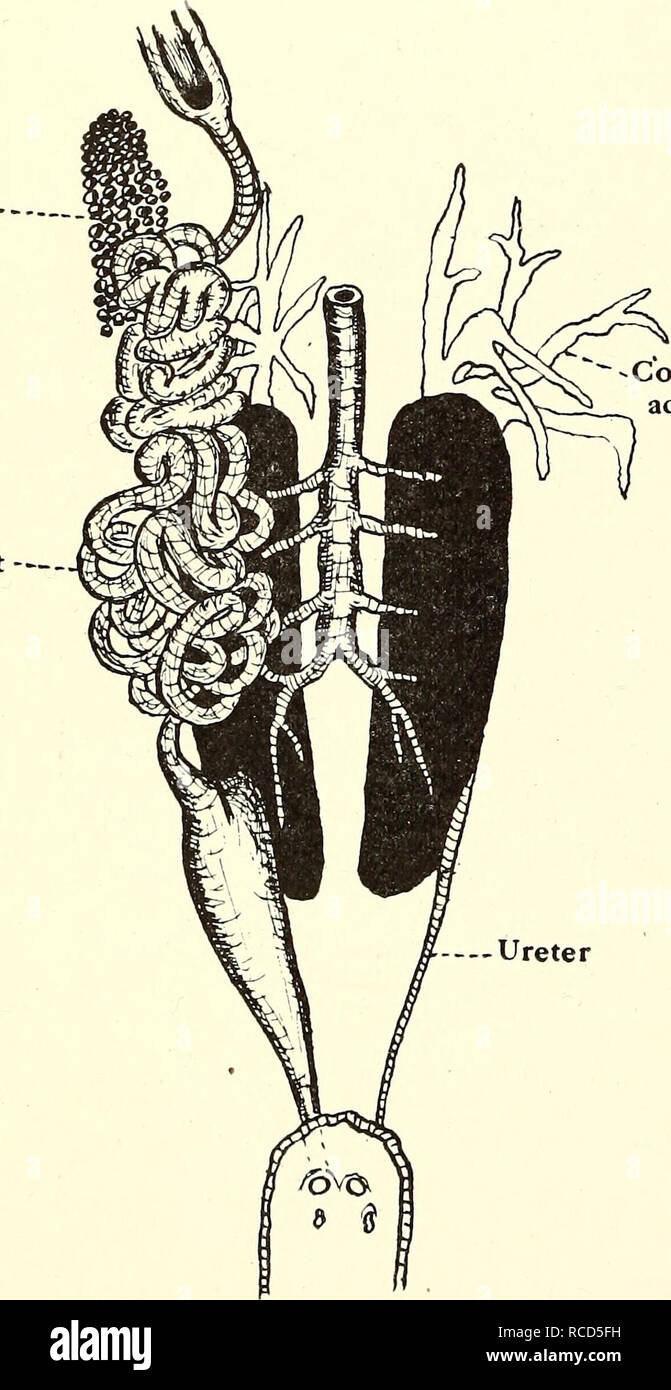 . Dissection of the platana and the frog. Xenopus laevis; Rana fuscigula. In the female Platana note :— (a) The ovaries, a pair of irregularly-lobed organs usually consisting of a mass of rounded black and white bodies, the ova. The ovaries are attached to the dorsal wall of the body cavity by a fold of the peritoneum. (b) The corpora adiposa lying in front of the kidneys. (c) The long convoluted oviducts opening into the body cavity in front and into the cloaca behind. The ureters open separately into the cloaca in the female. Make a drawing of the urinogenital system. Ovary Oviduct H. -Corpo Stock Photohttps://www.alamy.com/image-license-details/?v=1https://www.alamy.com/dissection-of-the-platana-and-the-frog-xenopus-laevis-rana-fuscigula-in-the-female-platana-note-a-the-ovaries-a-pair-of-irregularly-lobed-organs-usually-consisting-of-a-mass-of-rounded-black-and-white-bodies-the-ova-the-ovaries-are-attached-to-the-dorsal-wall-of-the-body-cavity-by-a-fold-of-the-peritoneum-b-the-corpora-adiposa-lying-in-front-of-the-kidneys-c-the-long-convoluted-oviducts-opening-into-the-body-cavity-in-front-and-into-the-cloaca-behind-the-ureters-open-separately-into-the-cloaca-in-the-female-make-a-drawing-of-the-urinogenital-system-ovary-oviduct-h-corpo-image231400389.html
. Dissection of the platana and the frog. Xenopus laevis; Rana fuscigula. In the female Platana note :— (a) The ovaries, a pair of irregularly-lobed organs usually consisting of a mass of rounded black and white bodies, the ova. The ovaries are attached to the dorsal wall of the body cavity by a fold of the peritoneum. (b) The corpora adiposa lying in front of the kidneys. (c) The long convoluted oviducts opening into the body cavity in front and into the cloaca behind. The ureters open separately into the cloaca in the female. Make a drawing of the urinogenital system. Ovary Oviduct H. -Corpo Stock Photohttps://www.alamy.com/image-license-details/?v=1https://www.alamy.com/dissection-of-the-platana-and-the-frog-xenopus-laevis-rana-fuscigula-in-the-female-platana-note-a-the-ovaries-a-pair-of-irregularly-lobed-organs-usually-consisting-of-a-mass-of-rounded-black-and-white-bodies-the-ova-the-ovaries-are-attached-to-the-dorsal-wall-of-the-body-cavity-by-a-fold-of-the-peritoneum-b-the-corpora-adiposa-lying-in-front-of-the-kidneys-c-the-long-convoluted-oviducts-opening-into-the-body-cavity-in-front-and-into-the-cloaca-behind-the-ureters-open-separately-into-the-cloaca-in-the-female-make-a-drawing-of-the-urinogenital-system-ovary-oviduct-h-corpo-image231400389.htmlRMRCD5FH–. Dissection of the platana and the frog. Xenopus laevis; Rana fuscigula. In the female Platana note :— (a) The ovaries, a pair of irregularly-lobed organs usually consisting of a mass of rounded black and white bodies, the ova. The ovaries are attached to the dorsal wall of the body cavity by a fold of the peritoneum. (b) The corpora adiposa lying in front of the kidneys. (c) The long convoluted oviducts opening into the body cavity in front and into the cloaca behind. The ureters open separately into the cloaca in the female. Make a drawing of the urinogenital system. Ovary Oviduct H. -Corpo